Chapter 296-901 WAC
Last Update: 3/18/14GLOBALLY HARMONIZED SYSTEM FOR HAZARD COMMUNICATION
WAC Sections
| HTMLPDF | 296-901-140 | Hazard communication. |
| HTMLPDF | 296-901-14002 | Purpose. |
| HTMLPDF | 296-901-14004 | Scope and application. |
| HTMLPDF | 296-901-14006 | Definitions. |
| HTMLPDF | 296-901-14008 | Hazard classification. |
| HTMLPDF | 296-901-14010 | Written hazard communication program. |
| HTMLPDF | 296-901-14012 | Labels and other forms of warning. |
| HTMLPDF | 296-901-14014 | Safety data sheets. |
| HTMLPDF | 296-901-14016 | Employee information and training. |
| HTMLPDF | 296-901-14018 | Trade secrets. |
| HTMLPDF | 296-901-14020 | Effective dates. |
| HTMLPDF | 296-901-14022 | Appendix A—Health hazard criteria. |
| HTMLPDF | 296-901-14024 | Appendix B—Physical hazard criteria. |
| HTMLPDF | 296-901-14026 | Appendix C—Allocation of label elements. |
| HTMLPDF | 296-901-14028 | Appendix D—Safety data sheets. |
| HTMLPDF | 296-901-14030 | Appendix E—Definition of "trade secret." |
| HTMLPDF | 296-901-14032 | Appendix F—Guidance for hazard classifications regarding carcinogenicity. |
PDF296-901-140
Hazard communication.
PDF296-901-14002
Purpose.
The purpose of this section is to ensure that the hazards of all chemicals produced or imported are classified, and that information concerning the classified hazards is transmitted to employers and employees. The requirements of this section are intended to be consistent with the provisions of the United Nations Globally Harmonized System of Classification and Labeling of Chemicals (GHS), Revision 3. The transmittal of information is to be accomplished by means of comprehensive hazard communication programs, which are to include container labeling and other forms of warning, safety data sheets and employee training.
This occupational safety and health standard is intended to address comprehensively the issue of classifying the potential hazards of chemicals, and communicating information concerning hazards and appropriate protective measures to employees, and to preempt any legislative or regulatory enactments of a state, or political subdivision of a state, pertaining to this subject. Classifying the potential hazards of chemicals and communicating information concerning hazards and appropriate protective measures to employees may include, for example, but is not limited to, provisions for: Developing and maintaining a written hazard communication program for the workplace, including lists of hazardous chemicals present; labeling of containers of chemicals in the workplace, as well as of containers of chemicals being shipped to other workplaces; preparation and distribution of safety data sheets to employees and downstream employers; and development and implementation of employee training programs regarding hazards of chemicals and protective measures.
PDF296-901-14004
Scope and application.
(1) This section requires chemical manufacturers or importers to classify the hazards of chemicals which they produce or import, and all employers to provide information to their employees about the hazardous chemicals to which they are exposed, by means of a hazard communication program, labels and other forms of warning, safety data sheets, and information and training. In addition, this section requires distributors to transmit the required information to employers. (Employers who do not produce or import chemicals need only focus on those parts of this rule that deal with establishing a workplace program and communicating information to their workers.)
(2) This section applies to any chemical which is known to be present in the workplace in such a manner that employees may be exposed under normal conditions of use or in a foreseeable emergency.
(3) This section applies to laboratories only as follows:
(a) Employers must ensure that labels on incoming containers of hazardous chemicals are not removed or defaced;
(b) Employers must maintain any safety data sheets that are received with incoming shipments of hazardous chemicals, and ensure that they are readily accessible during each workshift to laboratory employees when they are in their work areas;
(c) Employers must ensure that laboratory employees are provided information and training in accordance with WAC 296-901-14016, except for the location and availability of the written hazard communication program under WAC 296-901-14016 (2)(c); and
(d) Laboratory employers that ship hazardous chemicals are considered to be either a chemical manufacturer or a distributor under this rule, and thus must ensure that any containers of hazardous chemicals leaving the laboratory are labeled in accordance with WAC 296-901-14012, and that a safety data sheet is provided to distributors and other employers in accordance with WAC 296-901-14014 (5)(a) and (6).
(4) In work operations where employees only handle chemicals in sealed containers which are not opened under normal conditions of use (such as are found in marine cargo handling, warehousing, or retail sales), this section applies to these operations only as follows:
(a) Employers must ensure that labels on incoming containers of hazardous chemicals are not removed or defaced;
(b) Employers must maintain copies of any safety data sheets that are received with incoming shipments of the sealed containers of hazardous chemicals, must obtain a safety data sheet as soon as possible for sealed containers of hazardous chemicals received without a safety data sheet if an employee requests the safety data sheet, and must ensure that the safety data sheets are readily accessible during each work shift to employees when they are in their work area(s); and
(c) Employers must ensure that employees are provided with information and training in accordance with WAC 296-901-14016 (except for the location and availability of the written hazard communication program under WAC 296-901-14016 (2)(c), to the extent necessary to protect them in the event of a spill or leak of a hazardous chemical from a sealed container.
(5) This section does not require labeling of the following chemicals:
(a) Any pesticide as such term is defined in the Federal Insecticide, Fungicide, and Rodenticide Act (7 U.S.C. 136 et seq.), when subject to the labeling requirements of that act and labeling regulations issued under that act by the Environmental Protection Agency;
(b) Any chemical substance or mixture as such terms are defined in the Toxic Substances Control Act (15 U.S.C. 2601 et seq.), when subject to the labeling requirements of that act and labeling regulations issued under that act by the Environmental Protection Agency;
(c) Any food, food additive, color additive, drug, cosmetic, or medical or veterinary device or product, including materials intended for use as ingredients in such products (e.g., flavors and fragrances), as such terms are defined in the Federal Food, Drug, and Cosmetic Act (21 U.S.C. 301 et seq.) or the Virus-Serum-Toxin Act of 1913 (21 U.S.C. 151 et seq.), and regulations issued under those acts, when they are subject to the labeling requirements under those acts by either the Food and Drug Administration or the Department of Agriculture;
(d) Any distilled spirits (beverage alcohols), wine, or malt beverage intended for nonindustrial use, as such terms are defined in the Federal Alcohol Administration Act (27 U.S.C. 201 et seq.) and regulations issued under that act, when subject to the labeling requirements of that act and labeling regulations issued under that act by the Bureau of Alcohol, Tobacco, Firearms and Explosives;
(e) Any consumer product or hazardous substance as those terms are defined in the Consumer Product Safety Act (15 U.S.C. 2051 et seq.) and Federal Hazardous Substances Act (15 U.S.C. 1261 et seq.) respectively, when subject to a consumer product safety standard or labeling requirement of those acts, or regulations issued under those acts by the Consumer Product Safety Commission; and
(f) Agricultural or vegetable seed treated with pesticides and labeled in accordance with the Federal Seed Act (7 U.S.C. 1551 et seq.) and the labeling regulations issued under that act by the Department of Agriculture.
(6) This section does not apply to:
(a) Any hazardous waste as such term is defined by the Solid Waste Disposal Act, as amended by the Resource Conservation and Recovery Act of 1976, as amended (42 U.S.C. 6901 et seq.), when subject to regulations issued under that act by the Environmental Protection Agency;
(b) Any hazardous substance as such term is defined by the Comprehensive Environmental Response, Compensation and Liability Act (CERCLA) (42 U.S.C. 9601 et seq.) when the hazardous substance is the focus of remedial or removal action being conducted under CERCLA in accordance with Environmental Protection Agency regulations;
(c) Tobacco or tobacco products;
(d) Wood or wood products, including lumber which will not be processed, where the chemical manufacturer or importer can establish that the only hazard they pose to employees is the potential for flammability or combustibility (wood or wood products which have been treated with a hazardous chemical covered by this standard, and wood which may be subsequently sawed or cut, generating dust, are not exempted);
(e) Articles (as that term is defined in WAC 296-901-14006);
(f) Food or alcoholic beverages which are sold, used, or prepared in a retail establishment (such as a grocery store, restaurant, or drinking place), and foods intended for personal consumption by employees while in the workplace;
(g) Any drug, as that term is defined in the Federal Food, Drug, and Cosmetic Act (21 U.S.C. 301 et seq.), when it is in solid, final form for direct administration to the patient (e.g., tablets or pills); drugs which are packaged by the chemical manufacturer for sale to consumers in a retail establishment (e.g., over-the-counter drugs); and drugs intended for personal consumption by employees while in the workplace (e.g., first-aid supplies);
(h) Cosmetics which are packaged for sale to consumers in a retail establishment, and cosmetics intended for personal consumption by employees while in the workplace;
(i) Any consumer product or hazardous substance, as those terms are defined in the Consumer Product Safety Act (15 U.S.C. 2051 et seq.) and Federal Hazardous Substances Act (15 U.S.C. 1261 et seq.) respectively, where the employer can show that it is used in the workplace for the purpose intended by the chemical manufacturer or importer of the product, and the use results in a duration and frequency of exposure which is not greater than the range of exposures that could reasonably be experienced by consumers when used for the purpose intended;
(j) Nuisance particulates where the chemical manufacturer or importer can establish that they do not pose any physical or health hazard covered under this section;
(k) Ionizing and nonionizing radiation; and
(l) Biological hazards.
PDF296-901-14006
Definitions.
Article means a manufactured item other than a fluid or particle:
(1) Which is formed to a specific shape or design during manufacture;
(2) Which has end use function(s) dependent in whole or in part upon its shape or design during end use; and
(3) Which under normal conditions of use does not release more than very small quantities, e.g., minute or trace amounts of a hazardous chemical (as determined under WAC 296-901-14008), and does not pose a physical hazard or health risk to employees.
Chemical means any substance, or mixture of substances.
Chemical manufacturer means an employer with a workplace where chemical(s) are produced for use or distribution.
Chemical name means the scientific designation of a chemical the nomenclature system developed by the International Union of Pure and Applied Chemistry (IUPAC) or the Chemical Abstracts Service (CAS) rules of nomenclature, or a name that will clearly identify the chemical for the purpose of conducting a hazard classification.
Classification means to identify the relevant data regarding the hazards of a chemical; review those data to ascertain the hazards associated with the chemical; and decide whether the chemical will be classified as hazardous according to the definition of hazardous chemical in this section. In addition, classification for health and physical hazards includes the determination of the degree of hazard, where appropriate, by comparing the data with the criteria for health and physical hazards.
Commercial account means an arrangement whereby a retail distributor sells hazardous chemicals to an employer, generally in large quantities over time and/or at costs that are below the regular retail price.
Common name means any designation or identification such as code name, code number, trade name, brand name or generic name used to identify a chemical other than by its chemical name.
Container means any bag, barrel, bottle, box, can, cylinder, drum, reaction vessel, storage tank, or the like that contains a hazardous chemical. For purposes of this section, pipes or piping systems, and engines, fuel tanks, or other operating systems in a vehicle, are not considered to be containers.
Designated representative means any individual or organization to whom an employee gives written authorization to exercise such employee's rights under this section. A recognized or certified collective bargaining agent must be treated automatically as a designated representative without regard to written employee authorization.
Distributor means a business, other than a chemical manufacturer or importer, which supplies hazardous chemicals to other distributors or to employers.
Employee is a person, as defined under RCW 49.17.020(5), who may be exposed to hazardous chemicals under normal operating conditions or in foreseeable emergencies. Employees such as office workers or bank tellers who encounter hazardous chemicals only in nonroutine, isolated instances are not covered.
Employer means an employer, as defined under RCW 49.17.020(4), engaged in a business where chemicals are either used, distributed, or are produced for use or distribution, including a contractor or subcontractor.
Exposure or exposed means that an employee is subjected in the course of employment to a chemical that is a physical or health hazard, and includes potential (e.g., accidental or possible) exposure. "Subjected" in terms of health hazards includes any route of entry (e.g., inhalation, ingestion, skin contact or absorption).
Foreseeable emergency means any potential occurrence such as, but not limited to, equipment failure, rupture of containers, or failure of control equipment which could result in an uncontrolled release of a hazardous chemical into the workplace.
Hazard category means the division of criteria within each hazard class, e.g., oral acute toxicity and flammable liquids include four hazard categories. These categories compare hazard severity within a hazard class and should not be taken as a comparison of hazard categories more generally.
Hazard class means the nature of the physical or health hazards, e.g., flammable solid, carcinogen, oral acute toxicity.
Hazard not otherwise classified (HNOC) means an adverse physical or health effect identified through evaluation of scientific evidence during the classification process that does not meet the specified criteria for the physical and health hazard classes addressed in this section. This does not extend coverage to adverse physical and health effects for which there is a hazard class addressed in this section, but the effect either falls below the cut-off value/concentration limit of the hazard class or is under a GHS hazard category that has not been adopted by OSHA (e.g., acute toxicity Category 5).
Hazard statement means a statement assigned to a hazard class and category that describes the nature of the hazard(s) of a chemical including, where appropriate, the degree of hazard.
Hazardous chemical means any chemical which is classified as a physical hazard or a health hazard, a simple asphyxiant, combustible dust, pyrophoric gas, or hazard not otherwise classified.
Health hazard means a chemical which is classified as posing one of the following hazardous effects: Acute toxicity (any route of exposure); skin corrosion or irritation; serious eye damage or eye irritation; respiratory or skin sensitization; germ cell mutagenicity; carcinogenicity; reproductive toxicity; specific target organ toxicity (single or repeated exposure); or aspiration hazard. The criteria for determining whether a chemical is classified as a health hazard are detailed in WAC 296-901-14022, Appendix A—Health hazard criteria.
Immediate use means that the hazardous chemical will be under the control of and used only by the person who transfers it from a labeled container and only within the work shift in which it is transferred.
Importer means the first business with employees within the Customs Territory of the United States which receives hazardous chemicals produced in other countries for the purpose of supplying them to distributors or employers within the United States.
Label means an appropriate group of written, printed or graphic information elements concerning a hazardous chemical that is affixed to, printed on, or attached to the immediate container of a hazardous chemical, or to the outside packaging.
Label elements means the specified pictogram, hazard statement, signal word and precautionary statement for each hazard class and category.
Mixture means a combination or a solution composed of two or more substances in which they do not react.
Physical hazard means a chemical that is classified as posing one of the following hazardous effects: Explosive; flammable (gases, aerosols, liquids, or solids); oxidizer (liquid, solid or gas); self-reactive; pyrophoric (liquid or solid); self-heating; organic peroxide; corrosive to metal; gas under pressure; or in contact with water emits flammable gas. WAC 296-901-14024, Appendix B—Physical hazard criteria.
Pictogram means a composition that may include a symbol plus other graphic elements, such as a border, background pattern, or color, that is intended to convey specific information about the hazards of a chemical. Eight pictograms are designated under this standard for application to a hazard category.
Precautionary statement means a phrase that describes recommended measures that should be taken to minimize or prevent adverse effects resulting from exposure to a hazardous chemical, or improper storage or handling.
Produce means to manufacture, process, formulate, blend, extract, generate, emit, or repackage.
Product identifier means the name or number used for a hazardous chemical on a label or in the SDS. It provides a unique means by which the user can identify the chemical. The product identifier used must permit cross-references to be made among the list of hazardous chemicals required in the written hazard communication program, the label and the SDS.
Pyrophoric gas means a chemical in a gaseous state that will ignite spontaneously in air at a temperature of 130 degrees F (54.4 degrees C) or below.
Responsible party means someone who can provide additional information on the hazardous chemical and appropriate emergency procedures, if necessary.
Safety data sheet (SDS) means written or printed material concerning a hazardous chemical that is prepared in accordance with WAC 296-901-14014.
Signal word means a word used to indicate the relative level of severity of hazard and alert the reader to a potential hazard on the label. The signal words used in this section are "danger" and "warning." "Danger" is used for the more severe hazards, while "warning" is used for the less severe.
Simple asphyxiant means a substance or mixture that displaces oxygen in the ambient atmosphere, and can thus cause oxygen deprivation in those who are exposed, leading to unconsciousness and death.
Specific chemical identity means the chemical name, Chemical Abstracts Service (CAS) Registry Number, or any other information that reveals the precise chemical designation of the substance.
Substance means chemical elements and their compounds in the natural state or obtained by any production process, including any additive necessary to preserve the stability of the product and any impurities deriving from the process used, but excluding any solvent which may be separated without affecting the stability of the substance or changing its composition.
Trade secret means any confidential formula, pattern, process, device, information or compilation of information that is used in an employer's business, and that gives the employer an opportunity to obtain an advantage over competitors who do not know or use it. WAC 296-901-14030, Appendix E—Definition of "trade secret," sets out the criteria to be used in evaluating trade secrets.
Use means to package, handle, react, emit, extract, generate as a by-product, or transfer.
Work area means a room or defined space in a workplace where hazardous chemicals are produced or used, and where employees are present.
Workplace means an establishment, job site, or project, at one geographical location containing one or more work areas.
PDF296-901-14008
Hazard classification.
(1) Chemical manufacturers and importers must evaluate chemicals produced in their workplaces or imported by them to classify the chemicals in accordance with this section. For each chemical, the chemical manufacturer or importer must determine the hazard classes, and where appropriate, the category of each class that apply to the chemical being classified. Employers are not required to classify chemicals unless they choose not to rely on the classification performed by the chemical manufacturer or importer for the chemical to satisfy this requirement.
(2) Chemical manufacturers, importers or employers classifying chemicals must identify and consider the full range of available scientific literature and other evidence concerning the potential hazards. There is no requirement to test the chemical to determine how to classify its hazards. WAC 296-901-14022, Appendix A—Health hazard criteria must be consulted for classification of health hazards, and WAC 296-901-14024, Appendix B—Physical hazard criteria must be consulted for the classification of physical hazards.
(3) Mixtures.
(a) Chemical manufacturers, importers, or employers evaluating chemicals must follow the procedures described in WAC 296-901-14022, Appendix A—Health hazard criteria and WAC 296-901-14024, Appendix B—Physical hazard criteria to classify the hazards of the chemicals, including determinations regarding when mixtures of the classified chemicals are covered by this section.
(b) When classifying mixtures they produce or import, chemical manufacturers and importers of mixtures may rely on the information provided on the current safety data sheets of the individual ingredients, except where the chemical manufacturer or importer knows, or in the exercise of reasonable diligence should know, that the safety data sheet misstates or omits information required by this section.
PDF296-901-14010
Written hazard communication program.
(1) Employers must develop, implement, and maintain at each workplace, a written hazard communication program which at least describes how the criteria specified in WAC 296-901-14012, 296-901-14014, and 296-901-14016 for labels and other forms of warning, safety data sheets, and employee information and training will be met, and which also includes the following:
(a) A list of the hazardous chemicals known to be present using a product identifier that is referenced on the appropriate safety data sheet (the list may be compiled for the workplace as a whole or for individual work areas); and
(b) The methods the employer will use to inform employees of the hazards of nonroutine tasks (for example, the cleaning of reactor vessels), and the hazards associated with chemicals contained in unlabeled pipes in their work areas.
(2) Multi-employer workplaces. Employers who produce, use, or store hazardous chemicals at a workplace in such a way that the employees of other employer(s) may be exposed (for example, employees of a construction contractor working on-site) must additionally ensure that the hazard communication programs developed and implemented under this section include the following:
(a) The methods the employer will use to provide the other employer(s) on-site access to safety data sheets for each hazardous chemical the other employer(s)' employees may be exposed to while working;
(b) The methods the employer will use to inform the other employer(s) of any precautionary measures that need to be taken to protect employees during the workplace's normal operating conditions and in foreseeable emergencies; and
(c) The methods the employer will use to inform the other employer(s) of the labeling system used in the workplace.
(3) The employer may rely on an existing hazard communication program to comply with these requirements, provided that it meets the criteria established in this section.
(4) The employer must make the written hazard communication program available, upon request, to employees, their designated representatives, the department according to the requirements of this section.
(5) Where employees must travel between workplaces during a workshift, i.e., their work is carried out at more than one geographical location, the written hazard communication program may be kept at the primary workplace facility.
PDF296-901-14012
Labels and other forms of warning.
(1) Labels on shipped containers. The chemical manufacturer, importer, or distributor must ensure that each container of hazardous chemicals leaving the workplace is labeled, tagged, or marked. Hazards not otherwise classified do not have to be addressed on the container. Where the chemical manufacturer or importer is required to label, tag or mark the following information must be provided:
(a) Product identifier;
(b) Signal word;
(c) Hazard statement(s);
(d) Pictogram(s);
(e) Precautionary statement(s); and
(f) Name, address, and telephone number of the chemical manufacturer, importer, or other responsible party.
(2) The chemical manufacturer, importer, or distributor must ensure that the information provided under subsection (1)(a) through (e) of this section is in accordance with WAC 296-901-14026, Appendix C—Allocation of label elements, for each hazard class and associated hazard category for the hazardous chemical, prominently displayed, and in English (other languages may also be included if appropriate).
(3) The chemical manufacturer, importer, or distributor must ensure that the information provided under subsection (1)(b) through (d) of this section is located together on the label, tag, or mark.
(4) Solid materials.
(a) For solid metal (such as a steel beam or a metal casting), solid wood, or plastic items that are not exempted as articles due to their downstream use, or shipments of whole grain, the required label may be transmitted to the customer at the time of the initial shipment, and need not be included with subsequent shipments to the same employer unless the information on the label changes;
(b) The label may be transmitted with the initial shipment itself, or with the safety data sheet that is to be provided prior to or at the time of the first shipment; and
(c) This exception to requiring labels on every container of hazardous chemicals is only for the solid material itself, and does not apply to hazardous chemicals used in conjunction with, or known to be present with, the material and to which employees handling the items in transit may be exposed (for example, cutting fluids or pesticides in grains).
(5) Chemical manufacturers, importers, or distributors must ensure that each container of hazardous chemicals leaving the workplace is labeled, tagged, or marked in accordance with this section in a manner which does not conflict with the requirements of the Hazardous Materials Transportation Act (49 U.S.C. 1801 et seq.) and regulations issued under that act by the Department of Transportation.
(6) Workplace labeling. Except as provided in subsection (7) and (8) of this section, the employer must ensure that each container of hazardous chemicals in the workplace is labeled, tagged or marked with either:
(a) The information specified under subsection (1)(a) through (d) of this section for labels on shipped containers; or
(b) Product identifier and words, pictures, symbols, or combination thereof, which provide at least general information regarding the hazards of the chemicals, and which, in conjunction with the other information immediately available to employees under the hazard communication program, will provide employees with the specific information regarding the physical and health hazards of the hazardous chemical.
(7) The employer may use signs, placards, process sheets, batch tickets, operating procedures, or other such written materials in lieu of affixing labels to individual stationary process containers, as long as the alternative method identifies the containers to which it is applicable and conveys the information required under subsection (6) of this section to be on a label. The employer must ensure the written materials are readily accessible to the employees in their work area throughout each work shift.
(8) The employer is not required to label portable containers into which hazardous chemicals are transferred from labeled containers, and which are intended only for the immediate use of the employee who performs the transfer. For purposes of this section, drugs which are dispensed by a pharmacy to a health care provider for direct administration to a patient are exempted from labeling.
(9) The employer must not remove or deface existing labels on incoming containers of hazardous chemicals, unless the container is immediately marked with the required information.
(10) The employer must ensure that workplace labels or other forms of warning are legible, in English, and prominently displayed on the container, or readily available in the work area throughout each work shift. Employers having employees who speak other languages may add the information in their language to the material presented, as long as the information is presented in English as well.
(11) Chemical manufacturers, importers, distributors, or employers who become newly aware of any significant information regarding the hazards of a chemical must revise the labels for the chemical within six months of becoming aware of the new information, and must ensure that labels on containers of hazardous chemicals shipped after that time contain the new information. If the chemical is not currently produced or imported, the chemical manufacturer, importer, distributor, or employer must add the information to the label before the chemical is shipped or introduced into the workplace again.
PDF296-901-14014
Safety data sheets.
(1) Chemical manufacturers and importers must obtain or develop a safety data sheet for each hazardous chemical they produce or import. Employers must have a safety data sheet in the workplace for each hazardous chemical which they use.
(2) The chemical manufacturer or importer preparing the safety data sheet must ensure that it is in English (although the employer may maintain copies in other languages as well), and includes at least the following section numbers and headings, and associated information under each heading, in the order listed (see WAC 296-901-14028, Appendix D—Safety data sheets, for the specific content of each section of the safety data sheet):
(a) Section 1, Identification;
(b) Section 2, Hazard(s) identification;
(c) Section 3, Composition/information on ingredients;
(d) Section 4, First-aid measures;
(e) Section 5, Firefighting measures;
(f) Section 6, Accidental release measures;
(g) Section 7, Handling and storage;
(h) Section 8, Exposure controls/personal protection;
(i) Section 9, Physical and chemical properties;
(j) Section 10, Stability and reactivity;
(k) Section 11, Toxicological information;
(l) Section 12, Ecological information;
(m) Section 13, Disposal considerations;
(n) Section 14, Transport information;
(o) Section 15, Regulatory information; and
(p) Section 16, Other information, including date of preparation or last revision.
Note 1 to WAC 296-901-14014(2): To be consistent with the GHS, an SDS must also include the headings in WAC 296-901-14014 (2)(m) through (o) in order.
Note 2 to WAC 296-901-14014(2): The department will not be enforcing information requirements in SDS sections 12 through 15 (WAC 296-901-14014 (2)(l) through (o), as these areas are not under its jurisdiction.
(3) If no relevant information is found for any subheading within a section on the safety data sheet, the chemical manufacturer, importer or employer preparing the safety data sheet must mark it to indicate that no applicable information was found.
(4) Where complex mixtures have similar hazards and contents (i.e., the chemical ingredients are essentially the same, but the specific composition varies from mixture to mixture), the chemical manufacturer, importer or employer may prepare one safety data sheet to apply to all of these similar mixtures.
(5) The chemical manufacturer, importer or employer preparing the safety data sheet must ensure that the information provided accurately reflects the scientific evidence used in making the hazard classification. If the chemical manufacturer, importer or employer preparing the safety data sheet becomes newly aware of any significant information regarding the hazards of a chemical, or ways to protect against the hazards, this new information must be added to the safety data sheet within three months. If the chemical is not currently being produced or imported, the chemical manufacturer or importer must add the information to the safety data sheet before the chemical is introduced into the workplace again.
(a) Chemical manufacturers or importers must ensure that distributors and employers are provided an appropriate safety data sheet with their initial shipment, and with the first shipment after a safety data sheet is updated;
(b) The chemical manufacturer or importer must either provide safety data sheets with the shipped containers or send them to the distributor or employer prior to or at the time of the shipment;
(c) If the safety data sheet is not provided with a shipment that has been labeled as a hazardous chemical, the distributor or employer must obtain one from the chemical manufacturer or importer as soon as possible; and
(d) The chemical manufacturer or importer must also provide distributors or employers with a safety data sheet upon request.
(6) Distributors must ensure that safety data sheets, and updated information, are provided to other distributors and employers with their initial shipment and with the first shipment after a safety data sheet is updated.
(a) The distributor must either provide safety data sheets with the shipped containers, or send them to the other distributor or employer prior to or at the time of the shipment;
(b) Retail distributors selling hazardous chemicals to employers having a commercial account must provide a safety data sheet to such employers upon request, and must post a sign or otherwise inform them that a safety data sheet is available;
(c) Wholesale distributors selling hazardous chemicals to employers over-the-counter may also provide safety data sheets upon the request of the employer at the time of the over-the-counter purchase, and must post a sign or otherwise inform such employers that a safety data sheet is available;
(d) If an employer without a commercial account purchases a hazardous chemical from a retail distributor not required to have safety data sheets on file (i.e., the retail distributor does not have commercial accounts and does not use the materials), the retail distributor must provide the employer, upon request, with the name, address, and telephone number of the chemical manufacturer, importer, or distributor from which a safety data sheet can be obtained;
(e) Wholesale distributors must also provide safety data sheets to employers or other distributors upon request; and
(f) Chemical manufacturers, importers, and distributors need not provide safety data sheets to retail distributors that have informed them that the retail distributor does not sell the product to commercial accounts or open the sealed container to use it in their own workplaces.
(7) The employer must maintain in the workplace copies of the required safety data sheets for each hazardous chemical, and must ensure that they are readily accessible during each work shift to employees when they are in their work area(s). (Electronic access and other alternatives to maintaining paper copies of the safety data sheets are permitted as long as no barriers to immediate employee access in each workplace are created by such options.)
(8) Where employees must travel between workplaces during a workshift, i.e., their work is carried out at more than one geographical location, the safety data sheets may be kept at the primary workplace facility. In this situation, the employer must ensure that employees can immediately obtain the required information in an emergency.
(9) Safety data sheets may be kept in any form, including operating procedures, and may be designed to cover groups of hazardous chemicals in a work area where it may be more appropriate to address the hazards of a process rather than individual hazardous chemicals. However, the employer must ensure that in all cases the required information is provided for each hazardous chemical, and is readily accessible during each work shift to employees when they are in their work area(s).
(10) Safety data sheets must also be made readily available, upon request, to designated representatives, and the department in accordance with the requirements of WAC 296-901-14010.
(11) The department of labor and industries will translate certain hazard communication documents upon receipt of written or verbal request (within available resources) to employers or the public, a translation into Cambodian, Chinese, Korean, Spanish, or Vietnamese of any of the following:
• An employer's written Hazard Communication Program;
• A safety data sheet; or
• Written materials prepared by the department to inform employees of their rights described in this rule, regarding hazard communication.
Note: Written request for translations should be directed to:
Department of Labor and Industries
Right-To-Know Program
P.O. Box 44610
Olympia, WA 98504-4610
PDF296-901-14016
Employee information and training.
(1) Employers must provide employees with effective information and training on hazardous chemicals in their work area at the time of their initial assignment, and whenever a new chemical hazard the employees have not previously been trained about is introduced into their work area. Information and training may be designed to cover categories of hazards (e.g., flammability, carcinogenicity) or specific chemicals. Chemical-specific information must always be available through labels and safety data sheets.
(2) Information. Employees must be informed of:
(a) The requirements of this section;
(b) Any operations in their work area where hazardous chemicals are present; and
(c) The location and availability of the written hazard communication program, including the required list(s) of hazardous chemicals, and safety data sheets required by this section.
(3) Training. Employee training must include at least:
(a) Methods and observations that may be used to detect the presence or release of a hazardous chemical in the work area (such as monitoring conducted by the employer, continuous monitoring devices, visual appearance or odor of hazardous chemicals when being released, etc.);
(b) The physical, health, simple asphyxiation, combustible dust, and pyrophoric gas hazards, as well as hazards not otherwise classified, of the chemicals in the work area;
(c) The measures employees can take to protect themselves from these hazards, including specific procedures the employer has implemented to protect employees from exposure to hazardous chemicals, such as appropriate work practices, emergency procedures, and personal protective equipment to be used; and
(d) The details of the hazard communication program developed by the employer, including an explanation of the labels received on shipped containers and the workplace labeling system used by their employer; the safety data sheet, including the order of information and how employees can obtain and use the appropriate hazard information.
Note: | You must make the written Chemical Hazard Communication Program available, upon request, to employees, their designated representatives, the department, and NIOSH, in accordance with the requirements of chapter 296-802 WAC, Employee medical and exposure records. |
PDF296-901-14018
Trade secrets.
(1) The chemical manufacturer, importer, or employer may withhold the specific chemical identity, including the chemical name, other specific identification of a hazardous chemical, or the exact percentage (concentration) of the substance in a mixture, from the safety data sheet, provided that:
(a) The claim that the information withheld is a trade secret can be supported;
(b) Information contained in the safety data sheet concerning the properties and effects of the hazardous chemical is disclosed;
(c) The safety data sheet indicates that the specific chemical identity and/or percentage of composition is being withheld as a trade secret; and
(d) The specific chemical identity and percentage is made available to health professionals, employees, and designated representatives in accordance with the applicable provisions of this section.
(2) Where a treating physician or nurse determines that a medical emergency exists and the specific chemical identity and/or specific percentage of composition of a hazardous chemical is necessary for emergency or first-aid treatment, the chemical manufacturer, importer, or employer must immediately disclose the specific chemical identity or percentage composition of a trade secret chemical to that treating physician or nurse, regardless of the existence of a written statement of need or a confidentiality agreement. The chemical manufacturer, importer, or employer may require a written statement of need and confidentiality agreement, in accordance with the provisions of subsections (3) and (4) of this section, as soon as circumstances permit.
(3) In nonemergency situations, a chemical manufacturer, importer, or employer must, upon request, disclose a specific chemical identity or percentage composition, otherwise permitted to be withheld under subsection (1) of this section, to a health professional (i.e., physician, industrial hygienist, toxicologist, epidemiologist, or occupational health nurse) providing medical or other occupational health services to exposed employee(s), and to employees or designated representatives, if:
(a) The request is in writing;
(b) The request describes with reasonable detail one or more of the following occupational health needs for the information:
(i) To assess the hazards of the chemicals to which employees will be exposed;
(ii) To conduct or assess sampling of the workplace atmosphere to determine employee exposure levels;
(iii) To conduct preassignment or periodic medical surveillance of exposed employees;
(iv) To provide medical treatment to exposed employees;
(v) To select or assess appropriate personal protective equipment for exposed employees;
(vi) To design or assess engineering controls or other protective measures for exposed employees; and
(vii) To conduct studies to determine the health effects of exposure.
(c) The request explains in detail why the disclosure of the specific chemical identity or percentage composition is essential and that, in lieu thereof, the disclosure of the following information to the health professional, employee, or designated representative, would not satisfy the purposes described in (b) of this subsection:
(i) The properties and effects of the chemical;
(ii) Measures for controlling workers' exposure to the chemical;
(iii) Methods of monitoring and analyzing worker exposure to the chemical; and
(iv) Methods of diagnosing and treating harmful exposures to the chemical.
(d) The request includes a description of the procedures to be used to maintain the confidentiality of the disclosed information; and
(e) The health professional, and the employer or contractor of the services of the health professional (i.e., downstream employer, labor organization, or individual employee), employee, or designated representative, agree in a written confidentiality agreement that the health professional, employee, or designated representative, will not use the trade secret information for any purpose other than the health need(s) asserted and agree not to release the information under any circumstances other than to the department, as provided in subsection (6) of this section, except as authorized by the terms of the agreement or by the chemical manufacturer, importer, or employer.
(4) The confidentiality agreement authorized under subsection (3)(d) of this section:
(a) May restrict the use of the information to the health purposes indicated in the written statement of need;
(b) May provide for appropriate legal remedies in the event of a breach of the agreement, including stipulation of a reasonable preestimate of likely damages; and
(c) May not include requirements for the posting of a penalty bond.
(5) Nothing in this standard is meant to preclude the parties from pursuing noncontractual remedies to the extent permitted by law.
(6) If the health professional, employee, or designated representative receiving the trade secret information decides that there is a need to disclose it to the department, the chemical manufacturer, importer, or employer who provided the information must be informed by the health professional, employee, or designated representative prior to, or at the same time as, such disclosure.
(7) If the chemical manufacturer, importer, or employer denies a written request for disclosure of a specific chemical identity or percentage composition, the denial must:
(a) Be provided to the health professional, employee, or designated representative, within thirty days of the request;
(b) Be in writing;
(c) Include evidence to support the claim that the specific chemical identity or percent of composition is a trade secret;
(d) State the specific reasons why the request is being denied; and
(e) Explain in detail how alternative information may satisfy the specific medical or occupational health need without revealing the trade secret.
(8) The health professional, employee, or designated representative whose request for information is denied under subsection (3) of this section may refer the request and the written denial of the request to the department for consideration.
(9) When a health professional, employee, or designated representative refers the denial to the department under subsection (8) of this section, the department must consider the evidence to determine if:
(a) The chemical manufacturer, importer, or employer has supported the claim that the specific chemical identity or percentage composition is a trade secret;
(b) The health professional, employee, or designated representative has supported the claim that there is a medical or occupational health need for the information; and
(c) The health professional, employee, or designated representative has demonstrated adequate means to protect the confidentiality.
(10) If the department determines that the specific chemical identity or percentage composition requested under subsection (3) of this section is not a "bona fide" trade secret, or that it is a trade secret, but the requesting health professional, employee, or designated representative has a legitimate medical or occupational health need for the information, has executed a written confidentiality agreement, and has shown adequate means to protect the confidentiality of the information, the chemical manufacturer, importer, or employer will be subject to citation by DOSH.
If a chemical manufacturer, importer, or employer demonstrates to the department that the execution of a confidentiality agreement would not provide sufficient protection against the potential harm from the unauthorized disclosure of a trade secret, the department may issue such orders or impose such additional limitations or conditions upon the disclosure of the requested chemical information as may be appropriate to assure that the occupational health services are provided without an undue risk of harm to the chemical manufacturer, importer, or employer.
(11) A chemical manufacturer, importer, or employer may appeal a citation for a failure to release trade secret information according to WAC 296-900-170.
(12) Notwithstanding the existence of a trade secret claim, a chemical manufacturer, importer, or employer must, upon request, disclose to the department any information which this section requires the chemical manufacturer, importer, or employer to make available. Where there is a trade secret claim, such claim must be made no later than at the time the information is provided to the department so that suitable determinations of trade secret status can be made and the necessary protections can be implemented.
(13) Nothing in this subsection must be construed as requiring the disclosure under any circumstances of process information which is a trade secret.
PDF296-901-14020
Effective dates.
(1) During the transition period between the adoption date of this rule and the effective dates listed below, employers may comply with the applicable requirements in the employer chemical hazard communication standards under WAC 296-800-170 and chapter 296-307 WAC, Part Y-1, or the requirements of this section, or both.
(2) During the transition period between the adoption date of this rule and the effective dates listed below, chemical manufacturers, importers, and distributors may comply with the applicable requirements of chapter 296-816 WAC, Protecting trade secrets, chapter 296-62 WAC, Part B-1, Trade secrets, chapter 296-839 WAC, Content and distribution of material safety data sheets (MSDSs) and label information, chapter 296-307 WAC, Part Y-2, Material safety data sheets and label preparation, or the requirements of this section, or both.
(3) Employers must train employees regarding the new label elements and safety data sheets format by June 1, 2014.
(4) Employers, chemical manufacturers, importers, and distributors must be in compliance with all provisions of this section no later than June 1, 2015, except:
(a) After December 1, 2015, the distributor must not ship containers labeled by the chemical manufacturer or importer unless the label has been modified to comply with WAC 296-901-14012(1).
(b) All employers must, as necessary, update any alternative workplace labeling used under WAC 296-901-14012(6), update the hazard communication program required by WAC 296-901-14016(1), and provide any additional employee training in accordance with WAC 296-901-14016(3) for newly identified physical or health hazards no later than June 1, 2016.
PDF296-901-14022
Appendix A—Health hazard criteria.
A.0 GENERAL CLASSIFICATION CONSIDERATIONS
A.0.1 Classification
A.0.1.1 The term "hazard classification" is used to indicate that only the intrinsic hazardous properties of chemicals are considered. Hazard classification incorporates three steps:
(a) identification of relevant data regarding the hazards of a chemical;
(b) subsequent review of those data to ascertain the hazards associated with the chemical;
(c) determination of whether the chemical will be classified as hazardous and the degree of hazard.
A.0.1.2 For many hazard classes, the criteria are semi quantitative or qualitative and expert judgment is required to interpret the data for classification purposes.
A.0.2 Available data, test methods and test data quality
A.0.2.1 There is no requirement for testing chemicals.
A.0.2.2 The criteria for determining health hazards are test method neutral, i.e., they do not specify particular test methods, as long as the methods are scientifically validated.
A.0.2.3 The term "scientifically validated" refers to the process by which the reliability and the relevance of a procedure are established for a particular purpose. Any test that determines hazardous properties, which is conducted according to recognized scientific principles, can be used for purposes of a hazard determination for health hazards. Test conditions need to be standardized so that the results are reproducible with a given substance, and the standardized test yields "valid" data for defining the hazard class of concern.
A.0.2.4 Existing test data are acceptable for classifying chemicals, although expert judgment also may be needed for classification purposes.
A.0.2.5 The effect of a chemical on biological systems is influenced, by the physico-chemical properties of the substance and/or ingredients of the mixture and the way in which ingredient substances are biologically available. A chemical need not be classified when it can be shown by conclusive experimental data from scientifically validated test methods that the chemical is not biologically available.
A.0.2.6 For classification purposes, epidemiological data and experience on the effects of chemicals on humans (e.g., occupational data, data from accident databases) shall be taken into account in the evaluation of human health hazards of a chemical.
A.0.3 Classification based on weight of evidence
A.0.3.1 For some hazard classes, classification results directly when the data satisfy the criteria. For others, classification of a chemical shall be determined on the basis of the total weight of evidence using expert judgment. This means that all available information bearing on the classification of hazard shall be considered together, including the results of valid in vitro tests, relevant animal data, and human experience such as epidemiological and clinical studies and well-documented case reports and observations.
A.0.3.2 The quality and consistency of the data shall be considered. Information on chemicals related to the material being classified shall be considered as appropriate, as well as site of action and mechanism or mode of action study results. Both positive and negative results shall be considered together in a single weight-of-evidence determination.
A.0.3.3 Positive effects which are consistent with the criteria for classification, whether seen in humans or animals, shall normally justify classification. Where evidence is available from both humans and animals and there is a conflict between the findings, the quality and reliability of the evidence from both sources shall be evaluated in order to resolve the question of classification. Reliable, good quality human data shall generally have precedence over other data. However, even well-designed and conducted epidemiological studies may lack a sufficient number of subjects to detect relatively rare but still significant effects, or to assess potentially confounding factors. Therefore, positive results from well-conducted animal studies are not necessarily negated by the lack of positive human experience but require an assessment of the robustness, quality and statistical power of both the human and animal data.
A.0.3.4 Route of exposure, mechanistic information, and metabolism studies are pertinent to determining the relevance of an effect in humans. When such information raises doubt about relevance in humans, a lower classification may be warranted. When there is scientific evidence demonstrating that the mechanism or mode of action is not relevant to humans, the chemical should not be classified.
A.0.3.5 Both positive and negative results are considered together in the weight of evidence determination. However, a single positive study performed according to good scientific principles and with statistically and biologically significant positive results may justify classification.
A.0.4 Considerations for the classification of mixtures
A.0.4.1 For most hazard classes, the recommended process of classification of mixtures is based on the following sequence:
(a) Where test data are available for the complete mixture, the classification of the mixture will always be based on those data;
(b) Where test data are not available for the mixture itself, the bridging principles designated in each health hazard chapter of this appendix shall be considered for classification of the mixture;
(c) If test data are not available for the mixture itself, and the available information is not sufficient to allow application of the above-mentioned bridging principles, then the method(s) described in each chapter for estimating the hazards based on the information known will be applied to classify the mixture (e.g., application of cut-off values/concentration limits).
A.0.4.2 An exception to the above order or precedence is made for Carcinogenicity, Germ Cell Mutagenicity, and Reproductive Toxicity. For these three hazard classes, mixtures shall be classified based upon information on the ingredient substances, unless on a case-by-case basis, justification can be provided for classifying based upon the mixture as a whole. See chapters A.5, A.6, and A.7 for further information on case-by-case bases.
A.0.4.3 Use of cut-off values/concentration limits
A.0.4.3.1 When classifying an untested mixture based on the hazards of its ingredients, cut-off values/concentration limits for the classified ingredients of the mixture are used for several hazard classes. While the adopted cut-off values/concentration limits adequately identify the hazard for most mixtures, there may be some that contain hazardous ingredients at lower concentrations than the specified cut-off values/concentration limits that still pose an identifiable hazard. There may also be cases where the cut-off value/concentration limit is considerably lower than the established non-hazardous level for an ingredient.
A.0.4.3.2 If the classifier has information that the hazard of an ingredient will be evident (i.e., it presents a health risk) below the specified cut-off value/concentration limit, the mixture containing that ingredient shall be classified accordingly.
A.0.4.3.3 In exceptional cases, conclusive data may demonstrate that the hazard of an ingredient will not be evident (i.e., it does not present a health risk) when present at a level above the specified cut-off value/concentration limit(s). In these cases the mixture may be classified according to those data. The data must exclude the possibility that the ingredient will behave in the mixture in a manner that would increase the hazard over that of the pure substance. Furthermore, the mixture must not contain ingredients that would affect that determination.
A.0.4.4 Synergistic or antagonistic effects
When performing an assessment in accordance with these requirements, the evaluator must take into account all available information about the potential occurrence of synergistic effects among the ingredients of the mixture. Lowering classification of a mixture to a less hazardous category on the basis of antagonistic effects may be done only if the determination is supported by sufficient data.
A.0.5 Bridging principles for the classification of mixtures where test data are not available for the complete mixture.
A.0.5.1 Where the mixture itself has not been tested to determine its toxicity, but there are sufficient data on both the individual ingredients and similar tested mixtures to adequately characterize the hazards of the mixture, these data shall be used in accordance with the following bridging principles, subject to any specific provisions for mixtures for each hazard class. These principles ensure that the classification process uses the available data to the greatest extent possible in characterizing the hazards of the mixture.
A.0.5.1.1 Dilution
For mixtures classified in accordance with A.1 through A.10 of this Appendix, if a tested mixture is diluted with a diluent that has an equivalent or lower toxicity classification than the least toxic original ingredient, and which is not expected to affect the toxicity of other ingredients, then:
(a) the new diluted mixture shall be classified as equivalent to the original tested mixture; or
(b) for classification of acute toxicity in accordance with A.1 of this Appendix, paragraph A.1.3.6 (the additivity formula) shall be applied.
A.0.5.1.2 Batching
For mixtures classified in accordance with A.1 through A.10 of this Appendix, the toxicity of a tested production batch of a mixture can be assumed to be substantially equivalent to that of another untested production batch of the same mixture, when produced by or under the control of the same chemical manufacturer, unless there is reason to believe there is significant variation such that the toxicity of the untested batch has changed. If the latter occurs, a new classification is necessary.
A.0.5.1.3 Concentration of mixtures
For mixtures classified in accordance with A.1, A.2, A.3, A.8, A.9, or A.10 of this Appendix, if a tested mixture is classified in Category 1, and the concentration of the ingredients of the tested mixture that are in Category 1 is increased, the resulting untested mixture shall be classified in Category 1.
A.0.5.1.4 Interpolation within one toxicity category
For mixtures classified in accordance with A.1, A.2, A.3, A.8, A.9, or A.10 of this Appendix, for three mixtures (A, B and C) with identical ingredients, where mixtures A and B have been tested and are in the same toxicity category, and where untested mixture C has the same toxicologically active ingredients as mixtures A and B but has concentrations of toxicologically active ingredients intermediate to the concentrations in mixtures A and B, then mixture C is assumed to be in the same toxicity category as A and B.
A.0.5.1.5 Substantially similar mixtures
For mixtures classified in accordance with A.1 through A.10 of this Appendix, given the following set of conditions:
(a) Where there are two mixtures:
(i) A + B;
(ii) C + B;
(b) the concentration of ingredient B is essentially the same in both mixtures;
(c) the concentration of ingredient A in mixture (i) equals that of ingredient C in mixture (ii);
(d) and data on toxicity for A and C are available and substantially equivalent; i.e., they are in the same hazard category and are not expected to affect the toxicity of B; then
If mixture (i) or (ii) is already classified based on test data, the other mixture can be assigned the same hazard category.
A.0.5.1.6 Aerosols
For mixtures classified in accordance with A.1, A.2, A.3, A.4, A.8, or A.9 of this Appendix, an aerosol form of a mixture shall be classified in the same hazard category as the tested, non-aerosolized form of the mixture, provided the added propellant does not affect the toxicity of the mixture when spraying.
A.1 ACUTE TOXICITY
A.1.1 Definition
Acute toxicity refers to those adverse effects occurring following oral or dermal administration of a single dose of a substance, or multiple doses given within 24 hours, or an inhalation exposure of 4 hours.
A.1.2 Classification criteria for substances
A.1.2.1 Substances can be allocated to one of four toxicity categories based on acute toxicity by the oral, dermal or inhalation route according to the numeric cut-off criteria as shown in Table A.1.1. Acute toxicity values are expressed as (approximate) LD50 (oral, dermal) or LC50 (inhalation) values or as acute toxicity estimates (ATE). See the footnotes following Table A.1.1 for further explanation on the application of these values.
Table A.1.1: Acute toxicity hazard categories and acute toxicity estimate (ATE) values defining the respective categories
Exposure route | Category 1 | Category 2 | Category 3 | Category 4 | |
Oral (mg/kg bodyweight) see: | ≤5 | ˃5 and ≤50 | ˃50 and ≤300 | ˃300 and ≤2000 | |
Note (a) | |||||
Note (b) | |||||
Dermal (mg/kg bodyweight) see: | ≤50 | ˃50 and ≤200 | ˃200 and ≤1000 | ˃1000 and ≤2000 | |
Note (a) | |||||
Note (b) | |||||
Inhalation - Gases (ppmV) see: | ≤100 | ˃100 and ≤500 | ˃500 and ≤2500 | ˃2500 and ≤20000 | |
Note (a) | |||||
Note (b) | |||||
Note (c) | |||||
Inhalation - Vapors (mg/l) see: | ≤0.5 | ˃0.5 and ≤2.0 | ˃2.0 and ≤10.0 | ˃10.0 and ≤20.0 | |
Note (a) | |||||
Note (b) | |||||
Note (c) | |||||
Note (d) | |||||
Inhalation - Dusts and Mists (mg/l) see: | ≤0.05 | ˃0.05 and ≤0.5 | ˃0.5 and ≤1.0 | ˃1.0 and ≤5.0 | |
Note (a) | |||||
Note (b) | |||||
Note (c) | |||||
Note: Gas concentrations are expressed in parts per million per volume (ppmV).
Notes to Table A.1.1:
(a) The acute toxicity estimate (ATE) for the classification of a substance is derived using the LD50/LC50 where available;
(b) The acute toxicity estimate (ATE) for the classification of a substance or ingredient in a mixture is derived using:
(i) the LD50/LC50 where available. Otherwise,
(ii) the appropriate conversion value from Table 1.2 that relates to the results of a range test, or
(iii) the appropriate conversion value from Table 1.2 that relates to a classification category;
(c) Inhalation cut-off values in the table are based on 4 hour testing exposures. Conversion of existing inhalation toxicity data which has been generated according to 1 hour exposure is achieved by dividing by a factor of 2 for gases and vapors and 4 for dusts and mists;
(d) For some substances the test atmosphere will be a vapor which consists of a combination of liquid and gaseous phases. For other substances the test atmosphere may consist of a vapor which is nearly all the gaseous phase. In these latter cases, classification is based on ppmV as follows: Category 1 (100 ppmV), Category 2 (500 ppmV), Category 3 (2500 ppmV), Category 4 (20000 ppmV).
The terms "dust", "mist" and "vapor" are defined as follows:
(i) Dust: solid particles of a substance or mixture suspended in a gas (usually air);
(ii) Mist: liquid droplets of a substance or mixture suspended in a gas (usually air);
(iii) Vapor: the gaseous form of a substance or mixture released from its liquid or solid state.
A.1.2.3 The preferred test species for evaluation of acute toxicity by the oral and inhalation routes is the rat, while the rat or rabbit are preferred for evaluation of acute dermal toxicity. Test data already generated for the classification of chemicals under existing systems should be accepted when reclassifying these chemicals under the harmonized system. When experimental data for acute toxicity are available in several animal species, scientific judgment should be used in selecting the most appropriate LD50 value from among scientifically validated tests.
A.1.3 Classification criteria for mixtures
A.1.3.1 The approach to classification of mixtures for acute toxicity is tiered, and is dependent upon the amount of information available for the mixture itself and for its ingredients. The flow chart of Figure A.1.1 indicates the process that must be followed:
Figure A.1.1: Tiered approach to classification of mixtures for
acute toxicity
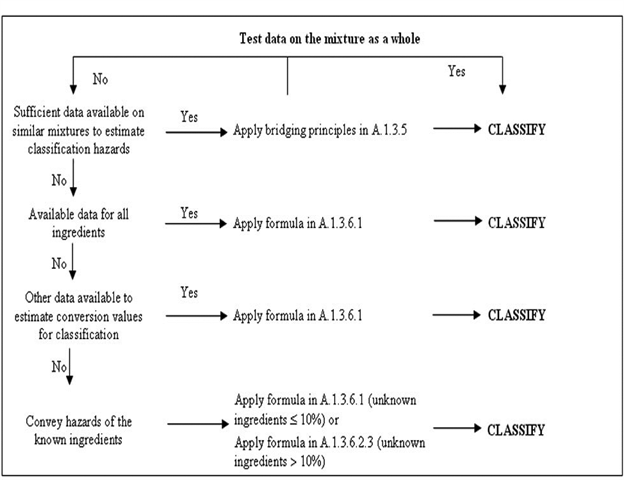 |
A.1.3.2 Classification of mixtures for acute toxicity may be carried out for each route of exposure, but is only required for one route of exposure as long as this route is followed (estimated or tested) for all ingredients and there is no relevant evidence to suggest acute toxicity by multiple routes. When there is relevant evidence of acute toxicity by multiple routes of exposure, classification is to be conducted for all appropriate routes of exposure. All available information shall be considered. The pictogram and signal word used shall reflect the most severe hazard category; and all relevant hazard statements shall be used.
A.1.3.3 For purposes of classifying the hazards of mixtures in the tiered approach:
(a) The "relevant ingredients" of a mixture are those which are present in concentrations ≥ 1% (weight/weight for solids, liquids, dusts, mists and vapors and volume/volume for gases). If there is reason to suspect that an ingredient present at a concentration < 1% will affect classification of the mixture for acute toxicity, that ingredient shall also be considered relevant. Consideration of ingredients present at a concentration < 1% is particularly important when classifying untested mixtures which contain ingredients that are classified in Category 1 and Category 2;
(b) Where a classified mixture is used as an ingredient of another mixture, the actual or derived acute toxicity estimate (ATE) for that mixture is used when calculating the classification of the new mixture using the formulas in A.1.3.6.1 and A.1.3.6.2.4.
(c) If the converted acute toxicity point estimates for all ingredients of a mixture are within the same category, then the mixture should be classified in that category.
(d) When only range data (or acute toxicity hazard category information) are available for ingredients in a mixture, they may be converted to point estimates in accordance with Table A.1.2 when calculating the classification of the new mixture using the formulas in A.1.3.6.1 and A.1.3.6.2.4.
A.1.3.4 Classification of mixtures where acute toxicity test data are available for the complete mixture
Where the mixture itself has been tested to determine its acute toxicity, it is classified according to the same criteria as those used for substances, presented in Table A.1.1. If test data for the mixture are not available, the procedures presented below must be followed.
A.1.3.5 Classification of mixtures where acute toxicity test data are not available for the complete mixture: bridging principles
A.1.3.5.1 Where the mixture itself has not been tested to determine its acute toxicity, but there are sufficient data on both the individual ingredients and similar tested mixtures to adequately characterize the hazards of the mixture, these data will be used in accordance with the following bridging principles as found in paragraph A.0.5 of this Appendix: Dilution, Batching, Concentration of mixtures, Interpolation within one toxicity category, Substantially similar mixtures, and Aerosols.
A.1.3.6 Classification of mixtures based on ingredients of the mixture (additivity formula)
A.1.3.6.1 Data available for all ingredients
The acute toxicity estimate (ATE) of ingredients is considered as follows:
(a) Include ingredients with a known acute toxicity, which fall into any of the acute toxicity categories, or have an oral or dermal LD50 greater than 2000 but less than or equal to 5000 mg/kg body weight (or the equivalent dose for inhalation);
(b) Ignore ingredients that are presumed not acutely toxic (e.g., water, sugar);
(c) Ignore ingredients if the data available are from a limit dose test (at the upper threshold for Category 4 for the appropriate route of exposure as provided in Table A.1.1) and do not show acute toxicity.
Ingredients that fall within the scope of this paragraph are considered to be ingredients with a known acute toxicity estimate (ATE). See note (b) to Table A.1.1 and paragraph A.1.3.3 for appropriate application of available data to the equation below, and paragraph A.1.3.6.2.4.
The ATE of the mixture is determined by calculation from the ATE values for all relevant ingredients according to the following formula below for oral, dermal or inhalation toxicity:
The ATE of the Mixture 2
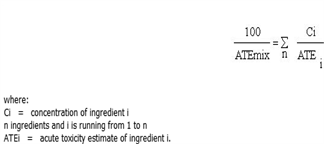 |
A.1.3.6.2 Data are not available for one or more ingredients of the mixture
A.1.3.6.2.1 Where an ATE is not available for an individual ingredient of the mixture, but available information provides a derived conversion value, the formula in A.1.3.6.1 may be applied. This information may include evaluation of:
(a) Extrapolation between oral, dermal and inhalation acute toxicity estimates. Such an evaluation requires appropriate pharmacodynamic and pharmacokinetic data;
(b) Evidence from human exposure that indicates toxic effects but does not provide lethal dose data;
(c) Evidence from any other toxicity tests/assays available on the substance that indicates toxic acute effects but does not necessarily provide lethal dose data; or
(d) Data from closely analogous substances using structure/activity relationships.
A.1.3.6.2.2 This approach requires substantial supplemental technical information, and a highly trained and experienced expert, to reliably estimate acute toxicity. If sufficient information is not available to reliably estimate acute toxicity, proceed to the provisions of A.1.3.6.2.3.
A.1.3.6.2.3 In the event that an ingredient with unknown acute toxicity is used in a mixture at a concentration ≥ 1%, and the mixture has not been classified based on testing of the mixture as a whole, the mixture cannot be attributed a definitive acute toxicity estimate. In this situation the mixture is classified based on the known ingredients only. (Note: A statement that x percent of the mixture consists of ingredient(s) of unknown toxicity is required on the label and safety data sheet in such cases; see Appendix C, Allocation of Label Elements and Appendix D, Safety Data Sheets.)
Where an ingredient with unknown acute toxicity is used in a mixture at a concentration ≥ 1%, and the mixture is not classified based on testing of the mixture as a whole, a statement that X% of the mixture consists of ingredient(s) of unknown acute toxicity is required on the label and safety data sheet in such cases; see Appendix C, Allocation of Label Elements and Appendix D, Safety Data Sheets.)
A.1.3.6.2.4 If the total concentration of the relevant ingredient(s) with unknown acute toxicity is ≤ 10% then the formula presented in A.1.3.6.1 must be used. If the total concentration of the relevant ingredient(s) with unknown acute toxicity is < 10%, the formula presented in A.1.3.6.1 is corrected to adjust for the percentage of the unknown ingredient(s) as follows:
 |
Table A.1.2: Conversion from experimentally obtained acute toxicity range values (or acute toxicity hazard categories) to acute toxicity point estimates for use in the formulas for the classification of mixtures
Exposure routes | Classification category or experimentally obtained acute toxicity range estimate | Converted Acute Toxicity point estimate | ||||
Oral | 0 | <Category 1 ≤ | 5 | 0.5 | ||
(mg/kg bodyweight) | 5 | <Category 2 ≤ | 50 | 5 | ||
50 | <Category 3 ≤ | 300 | 100 | |||
300 | <Category 4 ≤ | 2000 | 500 | |||
Dermal | 0 | <Category 1 ≤ | 50 | 5 | ||
(mg/kg bodyweight) | 50 | <Category 2 ≤ | 200 | 50 | ||
200 | <Category 3 ≤ | 1000 | 300 | |||
1000 | <Category 4 ≤ | 2000 | 1100 | |||
Gases | 0 | <Category 1 ≤ | 100 | 10 | ||
(ppmV) | 100 | <Category 2 ≤ | 500 | 100 | ||
500 | <Category 3 ≤ | 2500 | 700 | |||
2500 | <Category 4 ≤ | 20000 | 4500 | |||
Vapors | 0 | <Category 1 ≤ | 0.5 | 0.05 | ||
(mg/l) | 0.5 | <Category 2 ≤ | 2.0 | 0.5 | ||
2.0 | <Category 3 ≤ | 10.0 | 3 | |||
10.0 | <Category 4 ≤ | 20.0 | 11 | |||
Dust/mist | 0 | <Category 1 ≤ | 0.05 | 0.005 | ||
(mg/l) | 0.05 | <Category 2 ≤ | 0.5 | 0.05 | ||
0.5 | <Category 3 ≤ | 1.0 | 0.5 | |||
1.0 | <Category 4 ≤ | 5.0 | 1.5 | |||
Note: Gas concentrations are expressed in parts per million per volume (ppmV).
A.2 SKIN CORROSION/IRRITATION
A.2.1 Definitions and general considerations
A.2.1.1 Skin corrosion is the production of irreversible damage to the skin; namely, visible necrosis through the epidermis and into the dermis, following the application of a test substance for up to 4 hours. Corrosive reactions are typified by ulcers, bleeding, bloody scabs, and, by the end of observation at 14 days, by discoloration due to blanching of the skin, complete areas of alopecia, and scars. Histopathology should be considered to evaluate questionable lesions.
Skin irritation is the production of reversible damage to the skin following the application of a test substance for up to 4 hours.
A.2.1.2 Skin corrosion/irritation shall be classified using a tiered approach as detailed in figure A.2.1. Emphasis shall be placed upon existing human data (See A.0.2.6), followed by other sources of information. Classification results directly when the data satisfy the criteria in this section. In case the criteria cannot be directly applied, classification of a substance or a mixture is made on the basis of the total weight of evidence (See A.0.3.1). This means that all available information bearing on the determination of skin corrosion/irritation is considered together, including the results of appropriate scientifically validated in vitro tests, relevant animal data, and human data such as epidemiological and clinical studies and well-documented case reports and observations.
A.2.2 Classification criteria for substances using animal test data
A.2.2.1 Corrosion
A.2.2.1.1 A corrosive substance is a chemical that produces destruction of skin tissue, namely, visible necrosis through the epidermis and into the dermis, in at least 1 of 3 tested animals after exposure up to a 4-hour duration. Corrosive reactions are typified by ulcers, bleeding, bloody scabs and, by the end of observation at 14 days, by discoloration due to blanching of the skin, complete areas of alopecia and scars. Histopathology should be considered to discern questionable lesions.
A.2.2.1.2 Three sub-categories of Category 1 are provided in Table A.2.1, all of which shall be regulated as Category 1.
Table A.2.1: Skin corrosion category and sub-categories
Category 1: Corrosive | Corrosivesub-categories | Corrosive in ≥1 of 3 animals | |||
Exposure | Observation | ||||
1A | ≤ 3 min | ≤ 1 h | |||
1B | ˃ 3 min ≤ 1 h | ≤ 14 days | |||
1C | ˃ 1 h ≤ 4 h | ≤ 14 days | |||
A.2.2.2 Irritation
A.2.2.2.1 A single irritant category (Category 2) is presented in the Table A.2.2. The major criterion for the irritant category is that at least 2 tested animals have a mean score of ≥ 2.3 ≥ 4.0.
Table A.2.2 Skin irritation category
Criteria | |
Irritant (Category 2) | (1) Mean value of ≥ 2.3 ≥ 4.0 for erythema/eschar or for edema in at least 2 of 3 tested animals from gradings at 24, 48 and 72 hours after patch removal or, if reactions are delayed, from grades on 3 consecutive days after the onset of skin reactions; or |
(2) Inflammation that persists to the end of the observation period normally 14 days in at least 2 animals, particularly taking into account alopecia (limited area), hyperkeratosis, hyperplasia, and scaling; or | |
(3) In some cases where there is pronounced variability of response among animals, with very definite positive effects related to chemical exposure in a single animal but less than the criteria above. |
A.2.2.2.2 Animal irritant responses within a test can be quite variable, as they are with corrosion. A separate irritant criterion accommodates cases when there is a significant irritant response but less than the mean score criterion for a positive test. For example, a substance might be designated as an irritant if at least 1 of 3 tested animals shows a very elevated mean score throughout the study, including lesions persisting at the end of an observation period of normally 14 days. Other responses could also fulfill this criterion. However, it should be ascertained that the responses are the result of chemical exposure. Addition of this criterion increases the sensitivity of the classification system.
A.2.2.2.3. Reversibility of skin lesions is another consideration in evaluating irritant responses. When inflammation persists to the end of the observation period in 2 or more test animals, taking into consideration alopecia (limited area), hyperkeratosis, hyperplasia and scaling, then a chemical should be considered to be an irritant.
A.2.3 Classification Criteria for Substances Using Other Data Elements
A.2.3.1 Existing human and animal data including information from single or repeated exposure should be the first line of analysis, as they give information directly relevant to effects on the skin. If a substance is highly toxic by the dermal route, a skin corrosion/irritation study may not be practicable since the amount of test substance to be applied would considerably exceed the toxic dose and, consequently, would result in the death of the animals. When observations are made of skin corrosion/irritation in acute toxicity studies and are observed up through the limit dose, these data may be used for classification provided that the dilutions used and species tested are equivalent. In vitro alternatives that have been scientifically validated shall be used to make classification decisions. Solid substances (powders) may become corrosive or irritant when moistened or in contact with moist skin or mucous membranes. Likewise, pH extremes like ≤ 2 and ≥ 11.5 may indicate skin effects, especially when associated with significant buffering capacity. Generally, such substances are expected to produce significant effects on the skin. In the absence of any other information, a substance is considered corrosive (Skin Category 1) if it has a pH ≤ 2 or a pH ≥ 11.5. However, if consideration of alkali/acid reserve suggests the substance or mixture may not be corrosive despite the low or high pH value, then further evaluation may be necessary. In some cases enough information may be available from structurally related compounds to make classification decisions.
A.2.3.2 A tiered approach to the evaluation of initial information shall be used (Figure A.2.1) recognizing that all elements may not be relevant in certain cases.
A.2.3.3 The tiered approach explains how to organize information on a substance and to make a weight-of-evidence decision about hazard assessment and hazard classification.
A.2.3.4 All the above information that is available on a substance shall be evaluated. Although information might be gained from the evaluation of single parameters within a tier, there is merit in considering the totality of existing information and making an overall weight of evidence determination. This is especially true when there is information available on some but not all parameters. Emphasis shall be placed upon existing human experience and data, followed by animal experience and testing data, followed by other sources of information, but case-by-case determinations are necessary.
Figure A.2.1: Tiered evaluation of skin corrosion and
irritation potential
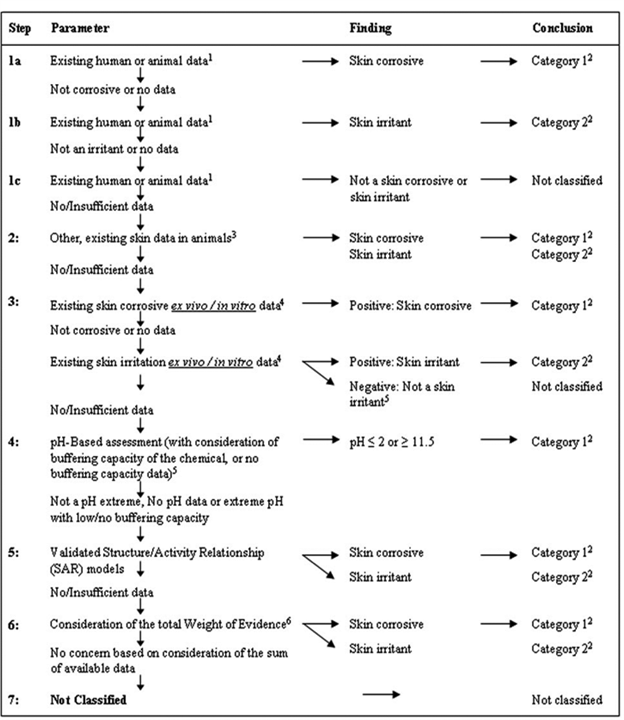 |
Notes to Figure A.2.1:
1. Evidence of existing human or animal data may be derived from single or repeated exposure(s) in occupational, consumer, transportation, or emergency response scenarios; from ethically-conducted human clinical studies; or from purposely-generated data from animal studies conducted according to scientifically validated test methods (at present, there is no internationally accepted test method for human skin irritation testing).
2. Classify in the appropriate harmonized category, as shown in Tables A.2.1 and A.2.2.
3. Pre-existing animal data (e.g. from an acute dermal toxicity test or a sensitisation test) should be carefully reviewed to determine if sufficient skin corrosion/irritation evidence is available through other, similar information. For example, classification/categorization may be done on the basis of whether a chemical has or has not produced any skin irritation in an acute dermal toxicity test in animals at the limit dose, or produces very toxic effects in an acute dermal toxicity test in animals. In the latter case, the chemical would be classified as being very hazardous by the dermal route for acute toxicity, and it would be moot whether the chemical is also irritating or corrosive on the skin. It should be kept in mind in evaluating acute dermal toxicity information that the reporting of dermal lesions may be incomplete, testing and observations may be made on a species other than the rabbit, and species may differ in sensitivity in their responses.
4. Evidence from studies using scientifically validated protocols with isolated human/animal tissues or other, non-tissue-based, though scientifically validated, protocols should be assessed. Examples of scientifically validated test methods for skin corrosion include OECD TG 430 (Transcutaneous Electrical Resistance Test (TER)), 431 (Human Skin Model Test), and 435 (Membrane Barrier Test Method). OECD TG 439 (Reconstructed Human Epidermis Test Method) is a scientifically validated in vitro test method for skin irritation.
5. Measurement of pH alone may be adequate, but assessment of acid or alkali reserve (buffering capacity) would be preferable. Presently, there is no scientifically validated and internationally accepted method for assessing this parameter.
6. All information that is available on a chemical should be considered and an overall determination made on the total weight of evidence. This is especially true when there is conflict in information available on some parameters. Professional judgment should be exercised in making such a determination.
A.2.4 Classification criteria for mixtures
A.2.4.1 Classification of mixtures when data are available for the complete mixture
A.2.4.1.1 The mixture shall be classified using the criteria for substances (See A.2.3).
A.2.4.2 Classification of mixtures when data are not available for the complete mixture: bridging principles
A.2.4.2.1 Where the mixture itself has not been tested to determine its skin corrosion/irritation, but there are sufficient data on both the individual ingredients and similar tested mixtures to adequately characterize the hazards of the mixture, these data will be used in accordance with the following bridging principles, as found in paragraph A.0.5 of this Appendix: Dilution, Batching, Concentration of mixtures, Interpolation within one toxicity category, Substantially similar mixtures, and Aerosols.
A.2.4.3 Classification of mixtures when data are available for all ingredients or only for some ingredients of the mixture
A.2.4.3.1 For purposes of classifying the skin corrosion/irritation hazards of mixtures in the tiered approach:
The "relevant ingredients" of a mixture are those which are present in concentrations ≥ 1% (weight/weight for solids, liquids, dusts, mists and vapors and volume/volume for gases.) If the classifier has reason to suspect that an ingredient present at a concentration < 1% will affect classification of the mixture for skin corrosion/irritation, that ingredient shall also be considered relevant.
A.2.4.3.2 In general, the approach to classification of mixtures as irritant or corrosive to skin when data are available on the ingredients, but not on the mixture as a whole, is based on the theory of additivity, such that each corrosive or irritant ingredient contributes to the overall irritant or corrosive properties of the mixture in proportion to its potency and concentration. A weighting factor of 10 is used for corrosive ingredients when they are present at a concentration below the concentration limit for classification with Category 1, but are at a concentration that will contribute to the classification of the mixture as an irritant. The mixture is classified as corrosive or irritant when the sum of the concentrations of such ingredients exceeds a cut-off value/concentration limit.
A.2.4.3.3 Table A.2.3 below provides the cut-off value/concentration limits to be used to determine if the mixture is considered to be an irritant or a corrosive to the skin.
A.2.4.3.4 Particular care shall be taken when classifying certain types of chemicals such as acids and bases, inorganic salts, aldehydes, phenols, and surfactants. The approach explained in A.2.4.3.1 and A.2.4.3.2 might not work given that many of such substances are corrosive or irritant at concentrations < 1%. For mixtures containing strong acids or bases the pH should be used as classification criteria since pH will be a better indicator of corrosion than the concentration limits of Table A.2.3. A mixture containing corrosive or irritant ingredients that cannot be classified based on the additivity approach shown in Table A.2.3, due to chemical characteristics that make this approach unworkable, should be classified as Skin Category 1 if it contains ≥ 1% of a corrosive ingredient and as Skin Category 2 when it contains ≥ 3% of an irritant ingredient. Classification of mixtures with ingredients for which the approach in Table A.2.3 does not apply is summarized in Table A.2.4 below.
A.2.4.3.5 On occasion, reliable data may show that the skin corrosion/irritation of an ingredient will not be evident when present at a level above the generic concentration cut-off values mentioned in Tables A.2.3 and A.2.4. In these cases the mixture could be classified according to those data (See Use of cut-off values/concentration limits, paragraph A.0.4.3 of this Appendix).
A.2.4.3.6 If there are data showing that (an) ingredient(s) may be corrosive or irritant at a concentration of < 1% (corrosive) or < 3% (irritant), the mixture shall be classified accordingly (See Use of cut-off values/concentration limits, paragraph A.0.4.3 of this Appendix).
Table A.2.3: Concentration of ingredients of a mixture classified as skin Category 1 or 2 that would trigger classification of the mixture as hazardous to skin (Category 1 or 2)
Concentration triggering classification of a mixture as: | ||
Sum of ingredients classified as: | Skin corrosive | Skin irritant |
Category 1 | Category 2 | |
Skin Category 1 | ≥ 5% | ≥ 1% but < 5% |
Skin Category 2 | ≥ 10% | |
(10 x Skin Category 1) + Skin Category 2 | ≥ 10% | |
Table A.2.4: Concentration of ingredients of a mixture for which the additivity approach does not apply, that would trigger classification of the mixture as hazardous to skin
Ingredient: | Concentration: | Mixture classified as: Skin |
Acid with pH ≤ 2 | ≥ 1% | Category 1 |
Base with pH ≥ 11.5 | ≥ 1% | Category 1 |
Other corrosive (Category 1) ingredients for which additivity does not apply | ≥ 1% | Category 1 |
Other irritant (Category 2) ingredients for which additivity does not apply, including acids and bases | ≥ 3% | Category 2 |
A.3 SERIOUS EYE DAMAGE/EYE IRRITATION
A.3.1 Definitions and general considerations
A.3.1.1 Serious eye damage is the production of tissue damage in the eye, or serious physical decay of vision, following application of a test substance to the anterior surface of the eye, which is not fully reversible within 21 days of application.
Eye irritation is the production of changes in the eye following the application of test substance to the anterior surface of the eye, which are fully reversible within 21 days of application.
A.3.1.2 Serious eye damage/eye irritation shall be classified using a tiered approach as detailed in figure A.3.1. Emphasis shall be placed upon existing human data (See A.0.2.6), followed by animal data, followed by other sources of information. Classification results directly when the data satisfy the criteria in this section. In case the criteria cannot be directly applied, classification of a substance or a mixture is made on the basis of the total weight of evidence (See A.0.3.1). This means that all available information bearing on the determination of serious eye damage/eye irritation is considered together, including the results of appropriate scientifically validated in vitro tests, relevant animal data, and human data such as epidemiological and clinical studies and well-documented case reports and observations.
A.3.2 Classification criteria for substances using animal test data
A.3.2.1 Irreversible effects on the eye/serious damage to eyes (Category 1)
A single hazard category is provided in Table A.3.1, for substances that have the potential to seriously damage the eyes. Category 1, irreversible effects on the eye, includes the criteria listed below. These observations include animals with grade 4 cornea lesions and other severe reactions (e.g. destruction of cornea) observed at any time during the test, as well as persistent corneal opacity, discoloration of the cornea by a dye substance, adhesion, pannus, and interference with the function of the iris or other effects that impair sight. In this context, persistent lesions are considered those which are not fully reversible within an observation period of normally 21 days. Category 1 also contains substances fulfilling the criteria of corneal opacity ≥ 3 and/or iritis ˃ 1.5 detected in a Draize eye test with rabbits, because severe lesions like these usually do not reverse within a 21-day observation period.
Table A.3.1: Irreversible eye effects
A substance is classified as Serious Eye Damage Category 1 (irreversible effects on the eye) when it produces: | |
(a) at least in one tested animal, effects on the cornea, iris or conjunctiva that are not expected to reverse or have not fully reversed within an observation period of normally 21 days; and/or | |
(b) at least in 2 of 3 tested animals, a positive response of: | |
(i) corneal opacity ≥ 3; and/or | |
(ii) iritis ˃ 1.5; | |
calculated as the mean scores following grading at 24, 48 and 72 hours after instillation of the substance. | |
A.3.2.2 Reversible effects on the eye (Category 2)
A single category is provided in Table A.3.2 for substances that have the potential to induce reversible eye irritation.
Table A.3.2: Reversible eye effects
A substance is classified as Eye irritant Category 2A (irritating to eyes) when it produces in at least in 2 of 3 tested animals a positive response of: | |
(i) corneal opacity ≥ 1; and/or | |
(ii) iritis ≥ 1; and/or | |
(iii) conjunctival redness ≥ 2; and/or | |
(iv) conjunctival edema (chemosis) ≥ 2 | |
calculated as the mean scores following grading at 24, 48 and 72 hours after instillation of the substance, and which fully reverses within an observation period of normally 21 days. An eye irritant is considered mildly irritating to eyes (Category 2B) when the effects listed above are fully reversible within 7 days of observation. | |
A.3.2.3 For those chemicals where there is pronounced variability among animal responses, this information may be taken into account in determining the classification.
A.3.3 Classification Criteria for Substances Using Other Data Elements
A.3.3.1 Existing human and animal data should be the first line of analysis, as they give information directly relevant to effects on the eye. Possible skin corrosion shall be evaluated prior to consideration of serious eye damage/eye irritation in order to avoid testing for local effects on eyes with skin corrosive substances. In vitro alternatives that have been scientifically validated and accepted shall be used to make classification decisions. Likewise, pH extremes like ≤ 2 and ≥ 11.5, may indicate serious eye damage, especially when associated with significant buffering capacity. Generally, such substances are expected to produce significant effects on the eyes. In the absence of any other information, a mixture/substance is considered to cause serious eye damage (Eye Category 1) if it has a pH ≤ 2 or ≥ 11.5. However, if consideration of acid/alkaline reserve suggests the substance may not have the potential to cause serious eye damage despite the low or high pH value, then further evaluation may be necessary. In some cases enough information may be available from structurally related compounds to make classification decisions.
A.3.3.2 A tiered approach to the evaluation of initial information shall be used where applicable, recognizing that all elements may not be relevant in certain cases (Figure A.3.1).
A.3.3.3 The tiered approach explains how to organize existing information on a substance and to make a weight-of-evidence decision, where appropriate, about hazard assessment and hazard classification.
A.3.3.4 All the above information that is available on a substance shall be evaluated. Although information might be gained from the evaluation of single parameters within a tier, consideration should be given to the totality of existing information and making an overall weight of evidence determination. This is especially true when there is conflict in information available on some parameters.
Figure A.3.1 Evaluation strategy for serious eye damage and eye irritation
(See also Figure A.2.1)
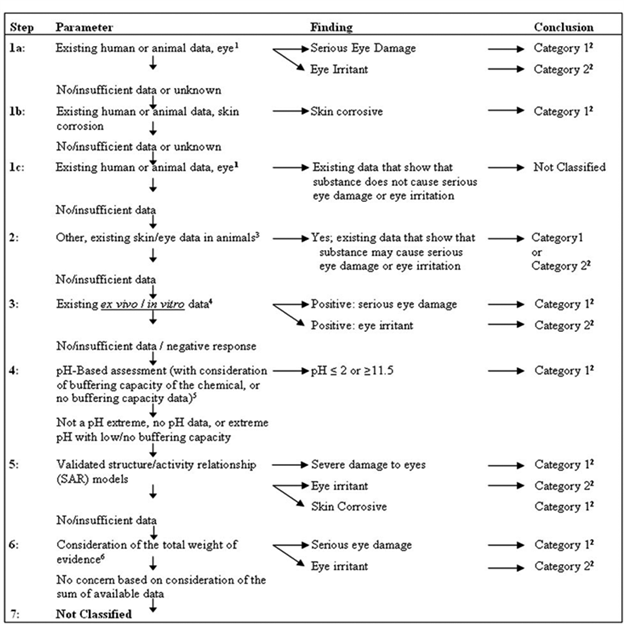 |
Notes to Figure A.3.1:
1 Evidence of existing human or animal data may be derived from single or repeated exposure(s) in occupational, consumer, transportation, or emergency response scenarios; from ethically-conducted human clinical studies; or from purposely-generated data from animal studies conducted according to scientifically validated test methods. At present, there are no internationally accepted test methods for human skin or eye irritation testing.
2 Classify in the appropriate harmonized category, as shown in Tables A.3.1 and A.3.2.
3 Pre-existing animal data should be carefully reviewed to determine if sufficient skin or eye corrosion/irritation evidence is available through other, similar information.
4 Evidence from studies using scientifically validated protocols with isolated human/animal tissues or other, non-tissue-based, though scientifically validated, protocols should be assessed. Examples of, scientifically validated test methods for identifying eye corrosives and severe irritants (i.e., Serious Eye Damage) include OECD TG 437 (Bovine Corneal Opacity and Permeability (BCOP)) and TG 438 (Isolated Chicken Eye). Positive test results from a scientifically validated in vitro test for skin corrosion would likely also lead to a conclusion to classify as causing Serious Eye Damage.
5 Measurement of pH alone may be adequate, but assessment of acid or alkali reserve (buffering capacity) would be preferable.
6 All information that is available on a chemical should be considered and an overall determination made on the total weight of evidence. This is especially true when there is conflict in information available on some parameters. The weight of evidence including information on skin irritation could lead to classification of eye irritation. It is recognized that not all skin irritants are eye irritants as well. Professional judgment should be exercised in making such a determination.
A.3.4 Classification criteria for mixtures
A.3.4.1 Classification of mixtures when data are available for the complete mixture
A.3.4.1.1 The mixture will be classified using the criteria for substances
A.3.4.1.2 Unlike other hazard classes, there are alternative tests available for skin corrosivity of certain types of chemicals that can give an accurate result for classification purposes, as well as being simple and relatively inexpensive to perform. When considering testing of the mixture, chemical manufacturers are encouraged to use a tiered weight of evidence strategy as included in the criteria for classification of substances for skin corrosion and serious eye damage and eye irritation to help ensure an accurate classification, as well as avoid unnecessary animal testing. In the absence of any other information, a mixture is considered to cause serious eye damage (Eye Category 1) if it has a pH ≤ 2 or ≥ 11.5. However, if consideration of acid/alkaline reserve suggests the substance or mixture may not have the potential to cause serious eye damage despite the low or high pH value, then further evaluation may be necessary.
A.3.4.2 Classification of mixtures when data are not available for the complete mixture: bridging principles
A.3.4.2.1 Where the mixture itself has not been tested to determine its skin corrosivity or potential to cause serious eye damage or eye irritation, but there are sufficient data on both the individual ingredients and similar tested mixtures to adequately characterize the hazards of the mixture, these data will be used in accordance with the following bridging principles, as found in paragraph A.0.5 of this Appendix: Dilution, Batching, Concentration of mixtures, Interpolation within one toxicity category, Substantially similar mixtures, and Aerosols.
A.3.4.3 Classification of mixtures when data are available for all ingredients or only for some ingredients of the mixture
A.3.4.3.1 For purposes of classifying the eye corrosion/irritation hazards of mixtures in the tiered approach:
The "relevant ingredients" of a mixture are those which are present in concentrations ≥ 1% (weight/weight for solids, liquids, dusts, mists and vapors and volume/volume for gases.) If the classifier has reason to suspect that an ingredient present at a concentration < 1% will affect classification of the mixture for eye corrosion/irritation, that ingredient shall also be considered relevant.
A.3.4.3.2 In general, the approach to classification of mixtures as seriously damaging to the eye or eye irritant when data are available on the ingredients, but not on the mixture as a whole, is based on the theory of additivity, such that each corrosive or irritant ingredient contributes to the overall irritant or corrosive properties of the mixture in proportion to its potency and concentration. A weighting factor of 10 is used for corrosive ingredients when they are present at a concentration below the concentration limit for classification with Category 1, but are at a concentration that will contribute to the classification of the mixture as an irritant. The mixture is classified as seriously damaging to the eye or eye irritant when the sum of the concentrations of such ingredients exceeds a threshold cut-off value/concentration limit.
A.3.4.3.3 Table A.3.3 provides the cut-off value/concentration limits to be used to determine if the mixture should be classified as seriously damaging to the eye or an eye irritant.
A.3.4.3.4 Particular care must be taken when classifying certain types of chemicals such as acids and bases, inorganic salts, aldehydes, phenols, and surfactants. The approach explained in A.3.4.3.1 and A.3.4.3.2 might not work given that many of such substances are corrosive or irritant at concentrations < 1%. For mixtures containing strong acids or bases, the pH should be used as classification criteria (See A.3.4.1) since pH will be a better indicator of serious eye damage than the concentration limits of Table A.3.3. A mixture containing corrosive or irritant ingredients that cannot be classified based on the additivity approach applied in Table A.3.3 due to chemical characteristics that make this approach unworkable, should be classified as Eye Category 1 if it contains ≥ 1% of a corrosive ingredient and as Eye Category 2 when it contains ≥ 3% of an irritant ingredient. Classification of mixtures with ingredients for which the approach in Table A.3.3 does not apply is summarized in Table A.3.4.
A.3.4.3.5 On occasion, reliable data may show that the reversible/irreversible eye effects of an ingredient will not be evident when present at a level above the generic cut-off values/concentration limits mentioned in Tables A.3.3 and A.3.4. In these cases the mixture could be classified according to those data (See also A.0.4.3 Use of cut-off values/concentration limits"). On occasion, when it is expected that the skin corrosion/irritation or the reversible/irreversible eye effects of an ingredient will not be evident when present at a level above the generic concentration/cut-off levels mentioned in Tables A.3.3 and A.3.4, testing of the mixture may be considered. In those cases, the tiered weight of evidence strategy should be applied as referred to in section A.3.3, Figure A.3.1 and explained in detail in this chapter.
A.3.4.3.6 If there are data showing that (an) ingredient(s) may be corrosive or irritant at a concentration of < 1% (corrosive) or < 3% (irritant), the mixture should be classified accordingly (See also paragraph A.0.4.3, Use of cut-off values/concentration limits).
Table A.3.3: Concentration of ingredients of a mixture classified as Skin Category 1 and/or
Eye Category 1 or 2 that would trigger classification of the mixtures as hazardous to the eye
Sum of ingredients classified as: | Concentration triggering classification of a mixture as: | |
Irreversible eye effects | Reversible eye effects | |
Category 1 | Category 2 | |
Eye or Skin Category 1 | ≥ 3% | ≥ 1% but < 3% |
Eye Category 2 | ≥ 10% | |
(10 x Eye Category 1) + Eye Category 2 | ≥ 10% | |
Skin Category 1 + Eye Category 1 | ≥ 3% | ≥ 1% but < 3% |
10 x (Skin Category 1 + Eye Category 1) + Eye Category 2 | ≥ 10% | |
Note: A mixture may be classified as Eye Category 2B in cases when all relevant ingredients are classified as Eye Category 2B.
Table A.3.4: Concentration of ingredients of a mixture for which the additivity approach does not apply, that would trigger classification of the mixture as hazardous to the eye
Ingredient | Concentration | Mixture classified as: Eye |
Acid with pH ≤ 2 | ≥ 1% | Category 1 |
Base with pH ≥ 11.5 | ≥ 1% | Category 1 |
Other corrosive (Category 1) ingredients for which additivity does not apply | ≥ 1% | Category 1 |
Other irritant (Category 2) ingredients for which additivity does not apply, including acids and bases | ≥ 3% | Category 2 |
A.4 RESPIRATORY OR SKIN SENSITIZATION
A.4.1 Definitions and general considerations
A.4.1.1 Respiratory sensitizer means a chemical that will lead to hypersensitivity of the airways following inhalation of the chemical.
Skin sensitizer means a chemical that will lead to an allergic response following skin contact.
A.4.1.2 For the purpose of this chapter, sensitization includes two phases: the first phase is induction of specialized immunological memory in an individual by exposure to an allergen. The second phase is elicitation, i.e., production of a cell-mediated or antibody-mediated allergic response by exposure of a sensitized individual to an allergen.
A.4.1.3 For respiratory sensitization, the pattern of induction followed by elicitation phases is shared in common with skin sensitization. For skin sensitization, an induction phase is required in which the immune system learns to react; clinical symptoms can then arise when subsequent exposure is sufficient to elicit a visible skin reaction (elicitation phase). As a consequence, predictive tests usually follow this pattern in which there is an induction phase, the response to which is measured by a standardized elicitation phase, typically involving a patch test. The local lymph node assay is the exception, directly measuring the induction response. Evidence of skin sensitization in humans normally is assessed by a diagnostic patch test.
A.4.1.4 Usually, for both skin and respiratory sensitization, lower levels are necessary for elicitation than are required for induction.
A.4.1.5 The hazard class "respiratory or skin sensitization" is differentiated into:
(a) Respiratory sensitization; and
(b) Skin sensitization
A.4.2 Classification criteria for substances
A.4.2.1 Respiratory sensitizers
A.4.2.1.1 Hazard categories
A.4.2.1.1.1 Effects seen in either humans or animals will normally justify classification in a weight of evidence approach for respiratory sensitizers. Substances may be allocated to one of the two sub-categories 1A or 1B using a weight of evidence approach in accordance with the criteria given in Table A.4.1 and on the basis of reliable and good quality evidence from human cases or epidemiological studies and/or observations from appropriate studies in experimental animals.
A.4.2.1.1.2 Where data are not sufficient for sub-categorization, respiratory sensitizers shall be classified in Category 1.
Table A.4.1: Hazard category and sub-categories for respiratory sensitizers
Category 1: | Respiratory sensitizer |
A substance is classified as a respiratory sensitizer | |
(a) if there is evidence in humans that the substance can lead to specific respiratory hypersensitivity and/or | |
(b) if there are positive results from an appropriate animal test. | |
Sub-category 1A: | Substances showing a high frequency of occurrence in humans; or a probability of occurrence of a high sensitization rate in humans based on animal or other tests.1 Severity of reaction may also be considered. |
Sub-category 1B: | Substances showing a low to moderate frequency of occurrence in humans; or a probability of occurrence of a low to moderate sensitization rate in humans based on animal or other tests.1 Severity of reaction may also be considered. |
A.4.2.1.2 Human evidence
A.4.2.1.2.1 Evidence that a substance can lead to specific respiratory hypersensitivity will normally be based on human experience. In this context, hypersensitivity is normally seen as asthma, but other hypersensitivity reactions such as rhinitis/conjunctivitis and alveolitis are also considered. The condition will have the clinical character of an allergic reaction. However, immunological mechanisms do not have to be demonstrated.
A.4.2.1.2.2 When considering the human evidence, it is necessary that in addition to the evidence from the cases, the following be taken into account:
(a) the size of the population exposed;
(b) the extent of exposure.
A.4.2.1.2.3 The evidence referred to above could be:
(a) clinical history and data from appropriate lung function tests related to exposure to the substance, confirmed by other supportive evidence which may include:
(i) in vivo immunological test (e.g., skin prick test);
(ii) in vitro immunological test (e.g., serological analysis);
(iii) studies that may indicate other specific hypersensitivity reactions where immunological mechanisms of action have not been proven, e.g., repeated low-level irritation, pharmacologically mediated effects;
(iv) a chemical structure related to substances known to cause respiratory hypersensitivity;
(b) data from positive bronchial challenge tests with the substance conducted according to accepted guidelines for the determination of a specific hypersensitivity reaction.
A.4.2.1.2.4 Clinical history should include both medical and occupational history to determine a relationship between exposure to a specific substance and development of respiratory hypersensitivity. Relevant information includes aggravating factors both in the home and workplace, the onset and progress of the disease, family history and medical history of the patient in question. The medical history should also include a note of other allergic or airway disorders from childhood and smoking history.
A.4.2.1.2.5 The results of positive bronchial challenge tests are considered to provide sufficient evidence for classification on their own. It is, however, recognized that in practice many of the examinations listed above will already have been carried out.
A.4.2.1.3 Animal studies
A.4.2.1.3.1 Data from appropriate animal studies which may be indicative of the potential of a substance to cause sensitization by inhalation in humans may include:
(a) measurements of Immunoglobulin E (IgE) and other specific immunological parameters, for example in mice
(b) specific pulmonary responses in guinea pigs.
A.4.2.2 Skin sensitizers
A.4.2.2.1 Hazard categories
A.4.2.2.1.1 Effects seen in either humans or animals will normally justify classification in a weight of evidence approach for skin sensitizers. Substances may be allocated to one of the two sub-categories 1A or 1B using a weight of evidence approach in accordance with the criteria given in Table A.4.2 and on the basis of reliable and good quality evidence from human cases or epidemiological studies and/or observations from appropriate studies in experimental animals according to the guidance values provided in A.4.2.2.2.1 and A.4.2.2.3.2 for sub-category 1A and in A.4.2.2.2.2 and A.4.2.2.3.3 for sub-category 1B.
A.4.2.2.1.2 Where data are not sufficient for sub-categorization, skin sensitizers shall be classified in Category 1.
Table A.4.2: Hazard category and sub-categories for skin sensitizers
Category 1: | Skin sensitizer |
A substance is classified as a skin sensitizer | |
(a) if there is evidence in humans that the substance can lead to sensitization by skin contact in a substantial number of persons, or | |
(b) if there are positive results from an appropriate animal test. | |
Sub-category 1A: | Substances showing a high frequency of occurrence in humans and/or a high potency in animals can be presumed to have the potential to produce significant sensitization in humans. Severity of reaction may also be considered. |
Sub-category 1B: | Substances showing a low to moderate frequency of occurrence in humans and/or a low to moderate potency in animals can be presumed to have the potential to produce sensitization in humans. Severity of reaction may also be considered. |
A.4.2.2.2 Human evidence
A.4.2.2.2.1 Human evidence for sub-category 1A may include:
(a) positive responses at ≤ 500 µg/cm2 (Human Repeat Insult Patch Test (HRIPT), Human Maximization Test (HMT) - induction threshold);
(b) diagnostic patch test data where there is a relatively high and substantial incidence of reactions in a defined population in relation to relatively low exposure;
(c) other epidemiological evidence where there is a relatively high and substantial incidence of allergic contact dermatitis in relation to relatively low exposure.
A.4.2.2.2.2 Human evidence for sub-category 1B may include:
(a) positive responses at ˃ 500 µg/cm2 (HRIPT, HMT - induction threshold);
(b) diagnostic patch test data where there is a relatively low but substantial incidence of reactions in a defined population in relation to relatively high exposure;
(c) other epidemiological evidence where there is a relatively low but substantial incidence of allergic contact dermatitis in relation to relatively high exposure.
A.4.2.2.3 Animal studies
A.4.2.2.3.1 For Category 1, when an adjuvant type test method for skin sensitization is used, a response of at least 30% of the animals is considered as positive. For a non-adjuvant Guinea pig test method a response of at least 15% of the animals is considered positive. For Category 1, a stimulation index of three or more is considered a positive response in the local lymph node assay.
A.4.2.2.3.2 Animal test results for sub-category 1A can include data with values indicated in Table A.4.3 below:
Table A.4.3: Animal test results for sub-category 1A
Assay | Criteria |
Local lymph node assay | EC3 value ≤ 2% |
Guinea pig maximization test | ≥ 30% responding at ≤ 0.1% intradermal induction dose or |
≥ 60% responding at ˃ 0.1% to ≤ 1% intradermal induction dose | |
Buehler assay | ≥ 15% responding at ≤ 0.2% topical induction dose or |
≥ 60% responding at ˃ 0.2% to ≤ 20% topical induction dose |
Note: EC3 refers to the estimated concentration of test chemical required to induce a stimulation index of 3 in the local lymph node assay.
A.4.2.2.3.3 Animal test results for sub-category 1B can include data with values indicated in Table A.4.4 below:
Table A.4.4: Animal test results for sub-category 1B
Assay | Criteria |
Local lymph node assay | EC3 value ˃ 2% |
Guinea pig maximization test | ≥ 30% to < 60% responding at ˃ 0.1% to ≤ 1% intradermal induction dose or |
≥ 30% responding at ˃ 1% intradermal induction dose | |
Buehler assay | ≥ 15% to < 60% responding at ˃ 0.2% to ≤ 20% topical induction dose or |
≥ 15% responding at ˃ 20% topical induction dose |
Note: EC3 refers to the estimated concentration of test chemical required to induce a stimulation index of 3 in the local lymph node assay.
A.4.2.2.4 Specific considerations
A.4.2.2.4.1 For classification of a substance, evidence shall include one or more of the following using a weight of evidence approach:
(a) Positive data from patch testing, normally obtained in more than one dermatology clinic;
(b) Epidemiological studies showing allergic contact dermatitis caused by the substance. Situations in which a high proportion of those exposed exhibit characteristic symptoms are to be looked at with special concern, even if the number of cases is small;
(c) Positive data from appropriate animal studies;
(d) Positive data from experimental studies in man (See paragraph A.0.2.6 of this Appendix);
(e) Well documented episodes of allergic contact dermatitis, normally obtained in more than one dermatology clinic;
(f) Severity of reaction.
A.4.2.2.4.2 Evidence from animal studies is usually much more reliable than evidence from human exposure. However, in cases where evidence is available from both sources, and there is conflict between the results, the quality and reliability of the evidence from both sources must be assessed in order to resolve the question of classification on a case-by-case basis. Normally, human data are not generated in controlled experiments with volunteers for the purpose of hazard classification but rather as part of risk assessment to confirm lack of effects seen in animal tests. Consequently, positive human data on skin sensitization are usually derived from case-control or other, less defined studies. Evaluation of human data must, therefore, be carried out with caution as the frequency of cases reflect, in addition to the inherent properties of the substances, factors such as the exposure situation, bioavailability, individual predisposition and preventive measures taken. Negative human data should not normally be used to negate positive results from animal studies. For both animal and human data, consideration should be given to the impact of vehicle.
A.4.2.2.4.3 If none of the above-mentioned conditions are met, the substance need not be classified as a skin sensitizer. However, a combination of two or more indicators of skin sensitization, as listed below, may alter the decision. This shall be considered on a case-by-case basis.
(a) Isolated episodes of allergic contact dermatitis;
(b) Epidemiological studies of limited power, e.g., where chance, bias or confounders have not been ruled out fully with reasonable confidence;
(c) Data from animal tests, performed according to existing guidelines, which do not meet the criteria for a positive result described in A.4.2.2.3, but which are sufficiently close to the limit to be considered significant;
(d) Positive data from non-standard methods;
(e) Positive results from close structural analogues.
A.4.2.2.4.4 Immunological contact urticaria
A.4.2.2.4.4.1 Substances meeting the criteria for classification as respiratory sensitizers may, in addition, cause immunological contact urticaria. Consideration shall be given to classifying these substances as skin sensitizers.
A.4.2.2.4.4.2 Substances which cause immunological contact urticaria without meeting the criteria for respiratory sensitizers shall be considered for classification as skin sensitizers.
A.4.2.2.4.4.3 There is no recognized animal model available to identify substances which cause immunological contact urticaria. Therefore, classification will normally be based on human evidence, similar to that for skin sensitization.
A.4.3 Classification criteria for mixtures
A.4.3.1 Classification of mixtures when data are available for the complete mixture
When reliable and good quality evidence, as described in the criteria for substances, from human experience or appropriate studies in experimental animals, is available for the mixture, then the mixture shall be classified by weight of evidence evaluation of these data. Care must be exercised in evaluating data on mixtures that the dose used does not render the results inconclusive.
A.4.3.2 Classification of mixtures when data are not available for the complete mixture: bridging principles
A.4.3.2.1 Where the mixture itself has not been tested to determine its sensitizing properties, but there are sufficient data on both the individual ingredients and similar tested mixtures to adequately characterize the hazards of the mixture, these data will be used in accordance with the following agreed bridging principles as found in paragraph A.0.5 of this Appendix: Dilution, Batching, Concentration of mixtures, Interpolation, Substantially similar mixtures, and Aerosols.
A.4.3.3 Classification of mixtures when data are available for all ingredients or only for some ingredients of the mixture
The mixture shall be classified as a respiratory or skin sensitizer when at least one ingredient has been classified as a respiratory or skin sensitizer and is present at or above the appropriate cut-off value/concentration limit for the specific endpoint as shown in Table A.4.5.
Table A.4.5: Cut-off values/concentration limits of ingredients of a mixture classified as either respiratory sensitizers or skin sensitizers that would trigger classification of the mixture
Cut-off values/concentration limits triggering classification of a mixture as: | |||
Respiratory Sensitizer | Skin Sensitizer | ||
Category 1 | Category 1 | ||
Ingredient classified as: | Solid/Liquid | Gas | All physical states |
Respiratory Sensitizer Category 1 | ≥ 0.1% | ≥ 0.1% | |
Respiratory Sensitizer Sub-category 1A | ≥ 0.1% | ≥ 0.1% | |
Respiratory Sensitizer Sub-category 1B | ≥ 0.1% | ≥ 0.2% | |
Skin Sensitizer Category 1 | ≥ 0.1% | ||
Skin Sensitizer Sub-category 1A | ≥ 0.1% | ||
Skin Sensitizer Sub-category 1B | ≥ 1.0% | ||
A.5 GERM CELL MUTAGENICITY
A.5.1 Definitions and general considerations
A.5.1.1 A mutation is defined as a permanent change in the amount or structure of the genetic material in a cell. The term mutation applies both to heritable genetic changes that may be manifested at the phenotypic level and to the underlying DNA modifications when known (including, for example, specific base pair changes and chromosomal translocations). The term mutagenic and mutagen will be used for agents giving rise to an increased occurrence of mutations in populations of cells and/or organisms.
A.5.1.2 The more general terms genotoxic and genotoxicity apply to agents or processes which alter the structure, information content, or segregation of DNA, including those which cause DNA damage by interfering with normal replication processes, or which in a non-physiological manner (temporarily) alter its replication. Genotoxicity test results are usually taken as indicators for mutagenic effects.
A.5.1.3 This hazard class is primarily concerned with chemicals that may cause mutations in the germ cells of humans that can be transmitted to the progeny. However, mutagenicity/genotoxicity tests in vitro and in mammalian somatic cells in vivo are also considered in classifying substances and mixtures within this hazard class.
A.5.2 Classification criteria for substances
A.5.2.1 The classification system provides for two different categories of germ cell mutagens to accommodate the weight of evidence available. The two-category system is described in the Figure A.5.1.
Figure A.5.1: Hazard categories for germ cell mutagens
CATEGORY 1: | Substances known to induce heritable mutations or to be regarded as if they induce heritable mutations in the germ cells of humans |
Category 1A: | Substances known to induce heritable mutations in germ cells of humans Positive evidence from human epidemiological studies. |
Category 1B: | Substances which should be regarded as if they induce heritable mutations in the germ cells of humans |
(a) Positive result(s) from in vivo heritable germ cell mutagenicity tests in mammals; or | |
(b) Positive result(s) from in vivo somatic cell mutagenicity tests in mammals, in combination with some evidence that the substance has potential to cause mutations to germ cells. This supporting evidence may, for example, be derived from mutagenicity/genotoxicity tests in germ cells in vivo, or by demonstrating the ability of the substance or its metabolite(s) to interact with the genetic material of germ cells; or | |
(c) Positive results from tests showing mutagenic effects in the germ cells of humans, without demonstration of transmission to progeny; for example, an increase in the frequency of aneuploidy in sperm cells of exposed people. | |
CATEGORY 2: | Substances which cause concern for humans owing to the possibility that they may induce heritable mutations in the germ cells of humans |
Positive evidence obtained from experiments in mammals and/or in some cases from in vitro experiments, obtained from: | |
(a) Somatic cell mutagenicity tests in vivo, in mammals; or | |
(b) Other in vivo somatic cell genotoxicity tests which are supported by positive results from in vitro mutagenicity assays. | |
Note: Substances which are positive in in vitro mammalian mutagenicity assays, and which also show chemical structure activity relationship to known germ cell mutagens, should be considered for classification as Category 2 mutagens. |
A.5.2.2 Specific considerations for classification of substances as germ cell mutagens:
A.5.2.2.1 To arrive at a classification, test results are considered from experiments determining mutagenic and/or genotoxic effects in germ and/or somatic cells of exposed animals. Mutagenic and/or genotoxic effects determined in in vitro tests shall also be considered.
A.5.2.2.2 The system is hazard based, classifying chemicals on the basis of their intrinsic ability to induce mutations in germ cells. The scheme is, therefore, not meant for the (quantitative) risk assessment of chemical substances.
A.5.2.2.3 Classification for heritable effects in human germ cells is made on the basis of scientifically validated tests. Evaluation of the test results shall be done using expert judgment and all the available evidence shall be weighed for classification.
A.5.2.2.4 The classification of substances shall be based on the total weight of evidence available, using expert judgment. In those instances where a single well-conducted test is used for classification, it shall provide clear and unambiguously positive results. The relevance of the route of exposure used in the study of the substance compared to the route of human exposure should also be taken into account.
A.5.3 Classification criteria for mixtures
A.5.3.1 Classification of mixtures when data are available for all ingredients or only for some ingredients of the mixture
A.5.3.1.1 Classification of mixtures shall be based on the available test data for the individual ingredients of the mixture using cut-off values/concentration limits for the ingredients classified as germ cell mutagens.
A.5.3.1.2 The mixture will be classified as a mutagen when at least one ingredient has been classified as a Category 1A, Category 1B or Category 2 mutagen and is present at or above the appropriate cut-off value/concentration limit as shown in Table A.5.1 below for Category 1 and 2 respectively.
Table A.5.1: Cut-off values/concentration limits of ingredients of a mixture classified as germ cell mutagens that would trigger classification of the mixture
Cut-off/concentration limits triggering classification of a mixture as: | ||
Ingredient classified as: | Category 1 mutagen | Category 2 mutagen |
Category 1 A/B mutagen | ≥ 0.1% | - |
Category 2 mutagen | - | ≥ 1.0% |
Note: The cut-off values/concentration limits in the table above apply to solids and liquids (w/w units) as well as gases (v/v units).
A.5.3.2 Classification of mixtures when data are available for the mixture itself
The classification may be modified on a case-by-case basis based on the available test data for the mixture as a whole. In such cases, the test results for the mixture as a whole must be shown to be conclusive taking into account dose and other factors such as duration, observations and analysis (e.g. statistical analysis, test sensitivity) of germ cell mutagenicity test systems.
A.5.3.3 Classification of mixtures when data are not available for the complete mixture: bridging principles
A.5.3.3.1 Where the mixture itself has not been tested to determine its germ cell mutagenicity hazard, but there are sufficient data on both the individual ingredients and similar tested mixtures to adequately characterize the hazards of the mixture, these data will be used in accordance with the following bridging principles as found in paragraph A.0.5 of this Appendix: Dilution, Batching, and Substantially similar mixtures.
A.5.4 Examples of scientifically validated test methods:
A.5.4.1 Examples of in vivo heritable germ cell mutagenicity tests are:
(a) Rodent dominant lethal mutation test (OECD 478)
(b) Mouse heritable translocation assay (OECD 485)
(c) Mouse specific locus test
A.5.4.2 Examples of in vivo somatic cell mutagenicity tests are:
(a) Mammalian bone marrow chromosome aberration test (OECD 475)
(b) Mouse spot test (OECD 484)
(c) Mammalian erythrocyte micronucleus test (OECD 474)
A.5.4.3 Examples of mutagenicity/genotoxicity tests in germ cells are:
(a) Mutagenicity tests:
(i) Mammalian spermatogonial chromosome aberration test (OECD 483)
(ii) Spermatid micronucleus assay
(b) Genotoxicity tests:
(i) Sister chromatid exchange analysis in spermatogonia
(ii) Unscheduled DNA synthesis test (UDS) in testicular cells
A.5.4.4 Examples of genotoxicity tests in somatic cells are:
(a) Liver Unscheduled DNA Synthesis (UDS) in vivo (OECD 486)
(b) Mammalian bone marrow Sister Chromatid Exchanges (SCE)
A.5.4.5 Examples of in vitro mutagenicity tests are:
(a) In vitro mammalian chromosome aberration test (OECD 473)
(b) In vitro mammalian cell gene mutation test (OECD 476)
(c) Bacterial reverse mutation tests (OECD 471)
A.5.4.6 As new, scientifically validated tests arise, these may also be used in the total weight of evidence to be considered.
A.6 CARCINOGENICITY
A.6.1 Definitions
Carcinogen means a substance or a mixture of substances which induce cancer or increase its incidence. Substances and mixtures which have induced benign and malignant tumors in well-performed experimental studies on animals are considered also to be presumed or suspected human carcinogens unless there is strong evidence that the mechanism of tumor formation is not relevant for humans.
Classification of a substance or mixture as posing a carcinogenic hazard is based on its inherent properties and does not provide information on the level of the human cancer risk which the use of the substance or mixture may represent.
A.6.2 Classification criteria for substances
A.6.2.1 For the purpose of classification for carcinogenicity, substances are allocated to one of two categories based on strength of evidence and additional weight of evidence considerations. In certain instances, route-specific classification may be warranted.
Figure A.6.1: Hazard categories for carcinogens
CATEGORY 1: | Known or presumed human carcinogens |
The classification of a substance as a Category 1 carcinogen is done on the basis of epidemiological and/or animal data. This classification is further distinguished on the basis of whether the evidence for classification is largely from human data (Category 1A) or from animal data (Category 1B): | |
Category 1A: | Known to have carcinogenic potential for humans. Classification in this category is largely based on human evidence. |
Category 1B: | Presumed to have carcinogenic potential for humans. Classification in this category is largely based on animal evidence. |
The classification of a substance in Category 1A and 1B is based on strength of evidence together with weight of evidence considerations (See paragraph A.6.2.5). Such evidence may be derived from: | |
- human studies that establish a causal relationship between human exposure to a substance and the development of cancer (known human carcinogen); or | |
- animal experiments for which there is sufficient evidence to demonstrate animal carcinogenicity (presumed human carcinogen). | |
In addition, on a case by case basis, scientific judgment may warrant a decision of presumed human carcinogenicity derived from studies showing limited evidence of carcinogenicity in humans together with limited evidence of carcinogenicity in experimental animals. | |
Category 2: | Suspected human carcinogens |
The classification of a substance in Category 2 is done on the basis of evidence obtained from human and/or animal studies, but which is not sufficiently convincing to place the substance in Category 1A or B. This classification is based on strength of evidence together with weight of evidence considerations (See paragraph A.6.2.5). Such evidence may be from either limited evidence of carcinogenicity in human studies or from limited evidence of carcinogenicity in animal studies. | |
Other considerations: | Where the weight of evidence for the carcinogenicity of a substance does not meet the above criteria, any positive study conducted in accordance with established scientific principles, and which reports statistically significant findings regarding the carcinogenic potential of the substance, must be noted on the safety data sheet. |
A.6.2.2 Classification as a carcinogen is made on the basis of evidence from reliable and acceptable methods, and is intended to be used for substances which have an intrinsic property to produce such toxic effects. The evaluations are to be based on all existing data, peer-reviewed published studies and additional data accepted by regulatory agencies.
A.6.2.3 Carcinogen classification is a one-step, criterion-based process that involves two interrelated determinations: evaluations of strength of evidence and consideration of all other relevant information to place substances with human cancer potential into hazard categories.
A.6.2.4 Strength of evidence involves the enumeration of tumors in human and animal studies and determination of their level of statistical significance. Sufficient human evidence demonstrates causality between human exposure and the development of cancer, whereas sufficient evidence in animals shows a causal relationship between the agent and an increased incidence of tumors. Limited evidence in humans is demonstrated by a positive association between exposure and cancer, but a causal relationship cannot be stated. Limited evidence in animals is provided when data suggest a carcinogenic effect, but are less than sufficient. (Guidance on consideration of important factors in the classification of carcinogenicity and a more detailed description of the terms "limited" and "sufficient" have been developed by the International Agency for Research on Cancer (IARC) and are provided in non-mandatory Appendix F.)
A.6.2.5 Weight of evidence: Beyond the determination of the strength of evidence for carcinogenicity, a number of other factors should be considered that influence the overall likelihood that an agent may pose a carcinogenic hazard in humans. The full list of factors that influence this determination is very lengthy, but some of the important ones are considered here.
A.6.2.5.1 These factors can be viewed as either increasing or decreasing the level of concern for human carcinogenicity. The relative emphasis accorded to each factor depends upon the amount and coherence of evidence bearing on each. Generally there is a requirement for more complete information to decrease than to increase the level of concern. Additional considerations should be used in evaluating the tumor findings and the other factors in a case-by-case manner.
A.6.2.5.2 Some important factors which may be taken into consideration, when assessing the overall level of concern are:
(a) Tumor type and background incidence;
(b) Multisite responses;
(c) Progression of lesions to malignancy;
(d) Reduced tumor latency;
Additional factors which may increase or decrease the level of concern include:
(e) Whether responses are in single or both sexes;
(f) Whether responses are in a single species or several species;
(g) Structural similarity or not to a substance(s) for which there is good evidence of carcinogenicity;
(h) Routes of exposure;
(i) Comparison of absorption, distribution, metabolism and excretion between test animals and humans;
(j) The possibility of a confounding effect of excessive toxicity at test doses; and,
(k) Mode of action and its relevance for humans, such as mutagenicity, cytotoxicity with growth stimulation, mitogenesis, immunosuppression.
Mutagenicity: It is recognized that genetic events are central in the overall process of cancer development. Therefore evidence of mutagenic activity in vivo may indicate that a substance has a potential for carcinogenic effects.
A.6.2.5.3 A substance that has not been tested for carcinogenicity may in certain instances be classified in Category 1A, Category 1B, or Category 2 based on tumor data from a structural analogue together with substantial support from consideration of other important factors such as formation of common significant metabolites, e.g., for benzidine congener dyes.
A.6.2.5.4 The classification should also take into consideration whether or not the substance is absorbed by a given route(s); or whether there are only local tumors at the site of administration for the tested route(s), and adequate testing by other major route(s) show lack of carcinogenicity.
A.6.2.5.5 It is important that whatever is known of the physico-chemical, toxicokinetic and toxicodynamic properties of the substances, as well as any available relevant information on chemical analogues, i.e., structure activity relationship, is taken into consideration when undertaking classification.
A.6.3 Classification criteria for mixtures
A.6.3.1 The mixture shall be classified as a carcinogen when at least one ingredient has been classified as a Category 1 or Category 2 carcinogen and is present at or above the appropriate cut-off value/concentration limit as shown in Table A.6.1.
Table A.6.1: Cut-off values/concentration limits of ingredients of a mixture classified as carcinogen that would trigger classification of the mixture
Ingredient classified as: | Category 1 carcinogen | Category 2 carcinogen |
Category 1 carcinogen | ≥ 0.1% | |
Category 2 carcinogen | ≥ 0.1% (note 1) |
Note: If a Category 2 carcinogen ingredient is present in the mixture at a concentration between 0.1% and 1%, information is required on the SDS for a product. However, a label warning is optional. If a Category 2 carcinogen ingredient is present in the mixture at a concentration of ≥ 1%, both an SDS and a label is required and the information must be included on each.
A.6.3.2 Classification of mixtures when data are available for the complete mixture
A mixture may be classified based on the available test data for the mixture as a whole. In such cases, the test results for the mixture as a whole must be shown to be conclusive taking into account dose and other factors such as duration, observations and analysis (e.g., statistical analysis, test sensitivity) of carcinogenicity test systems.
A.6.3.3 Classification of mixtures when data are not available for the complete mixture: bridging principles
Where the mixture itself has not been tested to determine its carcinogenic hazard, but there are sufficient data on both the individual ingredients and similar tested mixtures to adequately characterize the hazards of the mixture, these data will be used in accordance with the following bridging principles as found in paragraph A.0.5 of this Appendix: Dilution; Batching; and Substantially similar mixtures.
A.6.4 Classification of carcinogenicity
A.6.4.1 Chemical manufacturers, importers and employers evaluating chemicals may treat the following sources as establishing that a substance is a carcinogen or potential carcinogen for hazard communication purposes in lieu of applying the criteria described herein:
A.6.4.1.1 National Toxicology Program (NTP), "Report on Carcinogens" (latest edition);
A.6.4.1.2 International Agency for Research on Cancer (IARC) "Monographs on the Evaluation of Carcinogenic Risks to Humans" (latest editions)
A.6.4.2 Where OSHA has included cancer as a health hazard to be considered by classifiers for a chemical covered by 29 C.F.R. part 1910, Subpart Z, Toxic and Hazardous Substances, chemical manufacturers, importers, and employers shall classify the chemical as a carcinogen.
A.7 REPRODUCTIVE TOXICITY
A.7.1 Definitions and general considerations
A.7.1.1 Reproductive toxicity includes adverse effects on sexual function and fertility in adult males and females, as well as adverse effects on development of the offspring. Some reproductive toxic effects cannot be clearly assigned to either impairment of sexual function and fertility or to developmental toxicity. Nonetheless, chemicals with these effects shall be classified as reproductive toxicants.
For classification purposes, the known induction of genetically based inheritable effects in the offspring is addressed in Germ cell mutagenicity (See A.5).
A.7.1.2 Adverse effects on sexual function and fertility means any effect of chemicals that interferes with reproductive ability or sexual capacity. This includes, but is not limited to, alterations to the female and male reproductive system, adverse effects on onset of puberty, gamete production and transport, reproductive cycle normality, sexual behaviour, fertility, parturition, pregnancy outcomes, premature reproductive senescence, or modifications in other functions that are dependent on the integrity of the reproductive systems.
A.7.1.3 Adverse effects on development of the offspring means any effect of chemicals which interferes with normal development of the conceptus either before or after birth, which is induced during pregnancy or results from parental exposure. These effects can be manifested at any point in the life span of the organism. The major manifestations of developmental toxicity include death of the developing organism, structural abnormality, altered growth and functional deficiency.
A.7.1.4 Adverse effects on or via lactation are also included in reproductive toxicity, but for classification purposes, such effects are treated separately (See A.7.2.1).
A.7.2 Classification criteria for substances
A.7.2.1 For the purpose of classification for reproductive toxicity, substances shall be classified in one of two categories in accordance with Figure A.7.1(a). Effects on sexual function and fertility, and on development, shall be considered. In addition, effects on or via lactation shall be classified in a separate hazard category in accordance with Figure A.7.1(b).
Figure A.7.1(a): Hazard categories for reproductive toxicants
CATEGORY 1: | Known or presumed human reproductive toxicant |
Substance shall be classified in Category 1 for reproductive toxicity when they are known to have produced an adverse effect on sexual function and fertility or on development in humans or when there is evidence from animal studies, possibly supplemented with other information, to provide a strong presumption that the substance has the capacity to interfere with reproduction in humans. The classification of a substance is further distinguished on the basis of whether the evidence for classification is primarily from human data (Category 1A) or from animal data (Category 1B). | |
Category 1A: | Known human reproductive toxicant |
The classification of a substance in this category is largely based on evidence from humans. | |
Category 1B: | Presumed human reproductive toxicant |
The classification of a substance in this category is largely based on evidence from experimental animals. Data from animal studies shall provide sufficient evidence of an adverse effect on sexual function and fertility or on development in the absence of other toxic effects, or if occurring together with other toxic effects the adverse effect on reproduction is considered not to be a secondary non-specific consequence of other toxic effects. However, when there is mechanistic information that raises doubt about the relevance of the effect for humans, classification in Category 2 may be more appropriate. | |
Category 2: | Suspected human reproductive toxicant |
Substances shall be classified in Category 2 for reproductive toxicity when there is some evidence from humans or experimental animals, possibly supplemented with other information, of an adverse effect on sexual function and fertility, or on development, in the absence of other toxic effects, or if occurring together with other toxic effects the adverse effect on reproduction is considered not to be a secondary non-specific consequence of the other toxic effects, and where the evidence is not sufficiently convincing to place the substance in Category 1. For instance, deficiencies in the study may make the quality of evidence less convincing, and in view of this, Category 2 would be the more appropriate classification. |
Figure A.7.1(b): Hazard category for effects on or via lactation
EFFECTS ON OR VIA LACTATION | |
Effects on or via lactation shall be classified in a separate single category. Chemicals that are absorbed by women and have been shown to interfere with lactation or that may be present (including metabolites) in breast milk in amounts sufficient to cause concern for the health of a breastfed child, shall be classified to indicate this property hazardous to breastfed babies. This classification shall be assigned on the basis of: | |
(a) absorption, metabolism, distribution and excretion studies that indicate the likelihood the substance would be present in potentially toxic levels in breast milk; and/or | |
(b) results of one or two generation studies in animals which provide clear evidence of adverse effect in the offspring due to transfer in the milk or adverse effect on the quality of the milk; and/or | |
(c) human evidence indicating a hazard to babies during the lactation period. | |
A.7.2.2 Basis of classification
A.7.2.2.1 Classification is made on the basis of the criteria, outlined above, an assessment of the total weight of evidence, and the use of expert judgment. Classification as a reproductive toxicant is intended to be used for substances which have an intrinsic, specific property to produce an adverse effect on reproduction and substances should not be so classified if such an effect is produced solely as a non-specific secondary consequence of other toxic effects.
A.7.2.2.2 In the evaluation of toxic effects on the developing offspring, it is important to consider the possible influence of maternal toxicity.
A.7.2.2.3 For human evidence to provide the primary basis for a Category 1A classification there must be reliable evidence of an adverse effect on reproduction in humans. Evidence used for classification shall be from well conducted epidemiological studies, if available, which include the use of appropriate controls, balanced assessment, and due consideration of bias or confounding factors. Less rigorous data from studies in humans may be sufficient for a Category 1A classification if supplemented with adequate data from studies in experimental animals, but classification in Category 1B may also be considered.
A.7.2.3 Weight of evidence
A.7.2.3.1 Classification as a reproductive toxicant is made on the basis of an assessment of the total weight of evidence using expert judgment. This means that all available information that bears on the determination of reproductive toxicity is considered together. Included is information such as epidemiological studies and case reports in humans and specific reproduction studies along with sub-chronic, chronic and special study results in animals that provide relevant information regarding toxicity to reproductive and related endocrine organs. Evaluation of substances chemically related to the material under study may also be included, particularly when information on the material is scarce. The weight given to the available evidence will be influenced by factors such as the quality of the studies, consistency of results, nature and severity of effects, level of statistical significance for intergroup differences, number of endpoints affected, relevance of route of administration to humans and freedom from bias. Both positive and negative results are considered together in a weight of evidence determination. However, a single, positive study performed according to good scientific principles and with statistically or biologically significant positive results may justify classification (See also A.7.2.2.3).
A.7.2.3.2 Toxicokinetic studies in animals and humans, site of action and mechanism or mode of action study results may provide relevant information, which could reduce or increase concerns about the hazard to human health. If it is conclusively demonstrated that the clearly identified mechanism or mode of action has no relevance for humans or when the toxicokinetic differences are so marked that it is certain that the hazardous property will not be expressed in humans then a chemical which produces an adverse effect on reproduction in experimental animals should not be classified.
A.7.2.3.3 In some reproductive toxicity studies in experimental animals the only effects recorded may be considered of low or minimal toxicological significance and classification may not necessarily be the outcome. These effects include, for example, small changes in semen parameters or in the incidence of spontaneous defects in the fetus, small changes in the proportions of common fetal variants such as are observed in skeletal examinations, or in fetal weights, or small differences in postnatal developmental assessments.
A.7.2.3.4 Data from animal studies shall provide sufficient evidence of specific reproductive toxicity in the absence of other systemic toxic effects. However, if developmental toxicity occurs together with other toxic effects in the dam (mother), the potential influence of the generalized adverse effects should be assessed to the extent possible. The preferred approach is to consider adverse effects in the embryo/fetus first, and then evaluate maternal toxicity, along with any other factors which are likely to have influenced these effects, as part of the weight of evidence. In general, developmental effects that are observed at maternally toxic doses should not be automatically discounted. Discounting developmental effects that are observed at maternally toxic doses can only be done on a case-by-case basis when a causal relationship is established or refuted.
A.7.2.3.5 If appropriate information is available it is important to try to determine whether developmental toxicity is due to a specific maternally mediated mechanism or to a non-specific secondary mechanism, like maternal stress and the disruption of homeostasis. Generally, the presence of maternal toxicity should not be used to negate findings of embryo/fetal effects, unless it can be clearly demonstrated that the effects are secondary non-specific effects. This is especially the case when the effects in the offspring are significant, e.g., irreversible effects such as structural malformations. In some situations it is reasonable to assume that reproductive toxicity is due to a secondary consequence of maternal toxicity and discount the effects, for example if the chemical is so toxic that dams fail to thrive and there is severe inanition; they are incapable of nursing pups; or they are prostrate or dying.
A.7.2.4 Maternal toxicity
A.7.2.4.1 Development of the offspring throughout gestation and during the early postnatal stages can be influenced by toxic effects in the mother either through non-specific mechanisms related to stress and the disruption of maternal homeostasis, or by specific maternally-mediated mechanisms. So, in the interpretation of the developmental outcome to decide classification for developmental effects it is important to consider the possible influence of maternal toxicity. This is a complex issue because of uncertainties surrounding the relationship between maternal toxicity and developmental outcome. Expert judgment and a weight of evidence approach, using all available studies, shall be used to determine the degree of influence to be attributed to maternal toxicity when interpreting the criteria for classification for developmental effects. The adverse effects in the embryo/fetus shall be first considered, and then maternal toxicity, along with any other factors which are likely to have influenced these effects, as weight of evidence, to help reach a conclusion about classification.
A.7.2.4.2 Based on pragmatic observation, it is believed that maternal toxicity may, depending on severity, influence development via non-specific secondary mechanisms, producing effects such as depressed fetal weight, retarded ossification, and possibly resorptions and certain malformations in some strains of certain species. However, the limited numbers of studies which have investigated the relationship between developmental effects and general maternal toxicity have failed to demonstrate a consistent, reproducible relationship across species. Developmental effects which occur even in the presence of maternal toxicity are considered to be evidence of developmental toxicity, unless it can be unequivocally demonstrated on a case by case basis that the developmental effects are secondary to maternal toxicity. Moreover, classification shall be considered where there is a significant toxic effect in the offspring, e.g., irreversible effects such as structural malformations, embryo/fetal lethality, or significant post-natal functional deficiencies.
A.7.2.4.3 Classification shall not automatically be discounted for chemicals that produce developmental toxicity only in association with maternal toxicity, even if a specific maternally-mediated mechanism has been demonstrated. In such a case, classification in Category 2 may be considered more appropriate than Category 1. However, when a chemical is so toxic that maternal death or severe inanition results, or the dams (mothers) are prostrate and incapable of nursing the pups, it is reasonable to assume that developmental toxicity is produced solely as a secondary consequence of maternal toxicity and discount the developmental effects. Classification is not necessarily the outcome in the case of minor developmental changes, e.g., a small reduction in fetal/pup body weight or retardation of ossification when seen in association with maternal toxicity.
A.7.2.4.4 Some of the endpoints used to assess maternal toxicity are provided below. Data on these endpoints, if available, shall be evaluated in light of their statistical or biological significance and dose-response relationship.
(a) Maternal mortality: An increased incidence of mortality among the treated dams over the controls shall be considered evidence of maternal toxicity if the increase occurs in a dose-related manner and can be attributed to the systemic toxicity of the test material. Maternal mortality greater than 10% is considered excessive and the data for that dose level shall not normally be considered to need further evaluation.
(b) Mating index (Number of animals with seminal plugs or sperm/Number of mated x 100)
(c) Fertility index (Number of animals with implants/Number of matings x 100)
(d) Gestation length (If allowed to deliver
(e) Body weight and body weight change: Consideration of the maternal body weight change and/or adjusted (corrected) maternal body weight shall be included in the evaluation of maternal toxicity whenever such data are available. The calculation of an adjusted (corrected) mean maternal body weight change, which is the difference between the initial and terminal body weight minus the gravid uterine weight (or alternatively, the sum of the weights of the fetuses), may indicate whether the effect is maternal or intrauterine. In rabbits, the body weight gain may not be a useful indicator of maternal toxicity because of normal fluctuations in body weight during pregnancy.
(f) Food and water consumption (if relevant): The observation of a significant decrease in the average food or water consumption in treated dams (mothers) compared to the control group may be useful in evaluating maternal toxicity, particularly when the test material is administered in the diet or drinking water. Changes in food or water consumption must be evaluated in conjunction with maternal body weights when determining if the effects noted are reflective of maternal toxicity or more simply, unpalatability of the test material in feed or water.
(g) Clinical evaluations (including clinical signs, markers, and hematology and clinical chemistry studies): The observation of increased incidence of significant clinical signs of toxicity in treated dams (mothers) relative to the control group is useful in evaluating maternal toxicity. If this is to be used as the basis for the assessment of maternal toxicity, the types, incidence, degree and duration of clinical signs shall be reported in the study. Clinical signs of maternal intoxication include, but are not limited to: coma, prostration, hyperactivity, loss of righting reflex, ataxia, or labored breathing.
(h) Post-mortem data: Increased incidence and/or severity of post-mortem findings may be indicative of maternal toxicity. This can include gross or microscopic pathological findings or organ weight data, including absolute organ weight, organ to body weight ratio, or organ to brain weight ratio. When supported by findings of adverse histopathological effects in the affected organ(s), the observation of a significant change in the average weight of suspected target organ(s) of treated dams (mothers), compared to those in the control group, may be considered evidence of maternal toxicity.
A.7.2.5 Animal and experimental data
A.7.2.5.1 A number of scientifically validated test methods are available, including methods for developmental toxicity testing (e.g., OECD Test Guideline 414, ICH Guideline S5A, 1993), methods for peri- and post-natal toxicity testing (e.g., ICH S5B, 1995), and methods for one or two-generation toxicity testing (e.g., OECD Test Guidelines 415, 416)
A.7.2.5.2 Results obtained from screening tests (e.g., OECD Guidelines 421 - Reproduction/ Developmental Toxicity Screening Test, and 422 - Combined Repeated Dose Toxicity Study with Reproduction/Development Toxicity Screening Test) can also be used to justify classification, although the quality of this evidence is less reliable than that obtained through full studies.
A.7.2.5.3 Adverse effects or changes, seen in short- or long-term repeated dose toxicity studies, which are judged likely to impair reproductive function and which occur in the absence of significant generalized toxicity, may be used as a basis for classification, e.g., histopathological changes in the gonads.
A.7.2.5.4 Evidence from in vitro assays, or non-mammalian tests, and from analogous substances using structure-activity relationship (SAR), can contribute to the procedure for classification. In all cases of this nature, expert judgment must be used to assess the adequacy of the data. Inadequate data shall not be used as a primary support for classification.
A.7.2.5.5 It is preferable that animal studies are conducted using appropriate routes of administration which relate to the potential route of human exposure. However, in practice, reproductive toxicity studies are commonly conducted using the oral route, and such studies will normally be suitable for evaluating the hazardous properties of the substance with respect to reproductive toxicity. However, if it can be conclusively demonstrated that the clearly identified mechanism or mode of action has no relevance for humans or when the toxicokinetic differences are so marked that it is certain that the hazardous property will not be expressed in humans then a substance which produces an adverse effect on reproduction in experimental animals should not be classified.
A.7.2.5.6 Studies involving routes of administration such as intravenous or intraperitoneal injection, which may result in exposure of the reproductive organs to unrealistically high levels of the test substance, or elicit local damage to the reproductive organs, e.g., by irritation, must be interpreted with extreme caution and on their own are not normally the basis for classification.
A.7.2.5.7 There is general agreement about the concept of a limit dose, above which the production of an adverse effect may be considered to be outside the criteria which lead to classification. Some test guidelines specify a limit dose, other test guidelines qualify the limit dose with a statement that higher doses may be necessary if anticipated human exposure is sufficiently high that an adequate margin of exposure would not be achieved. Also, due to species differences in toxicokinetics, establishing a specific limit dose may not be adequate for situations where humans are more sensitive than the animal model.
A.7.2.5.8 In principle, adverse effects on reproduction seen only at very high dose levels in animal studies (for example doses that induce prostration, severe inappetence, excessive mortality) do not normally lead to classification, unless other information is available, for example, toxicokinetics information indicating that humans may be more susceptible than animals, to suggest that classification is appropriate.
A.7.2.5.9 However, specification of the actual "limit dose" will depend upon the test method that has been employed to provide the test results.
A.7.3 Classification criteria for mixtures
A.7.3.1 Classification of mixtures when data are available for all ingredients or only for some ingredients of the mixture
A.7.3.1.1 The mixture shall be classified as a reproductive toxicant when at least one ingredient has been classified as a Category 1 or Category 2 reproductive toxicant and is present at or above the appropriate cut-off value/concentration limit specified in Table A.7.1 for Category 1 and 2, respectively.
A.7.3.1.2 The mixture shall be classified for effects on or via lactation when at least one ingredient has been classified for effects on or via lactation and is present at or above the appropriate cut-off value/concentration limit specified in Table A.7.1 for the additional category for effects on or via lactation.
Table A.7.1: Cut-off values/concentration limits of ingredients of a mixture classified as reproductive toxicants or for effects on or via lactation that trigger classification of the mixture
Cut-off values/concentration limits triggering classification of a mixture as: | |||
Ingredient classified as: | Category 1 reproductive toxicant | Category 2 reproductive toxicant | Additional category for effects on or vialactation |
Category 1 reproductive toxicant | ≥ 0.1% | ||
Category 2 reproductive toxicant | ≥ 0.1% | ||
Additional category for effects on or via lactation | ≥ 0.1% | ||
A.7.3.2 Classification of mixtures when data are available for the complete mixture
Available test data for the mixture as a whole may be used for classification on a case-by-case basis. In such cases, the test results for the mixture as a whole must be shown to be conclusive taking into account dose and other factors such as duration, observations and analysis (e.g., statistical analysis, test sensitivity) of reproduction test systems.
A.7.3.3 Classification of mixtures when data are not available for the complete mixture: bridging principles
A.7.3.3.1 Where the mixture itself has not been tested to determine its reproductive toxicity, but there are sufficient data on both the individual ingredients and similar tested mixtures to adequately characterize the hazards of the mixture, these data shall be used in accordance with the following bridging principles as found in paragraph A.0.5 of this Appendix: Dilution, Batching, and Substantially similar mixtures.
A.8 SPECIFIC TARGET ORGAN TOXICITY SINGLE EXPOSURE
A.8.1 Definitions and general considerations
A.8.1.1 Specific target organ toxicity - single exposure, (STOT-SE) means specific, non-lethal target organ toxicity arising from a single exposure to a chemical. All significant health effects that can impair function, both reversible and irreversible, immediate and/or delayed and not specifically addressed in A.1 to A.7 and A.10 of this Appendix are included. Specific target organ toxicity following repeated exposure is classified in accordance with SPECIFIC TARGET ORGAN TOXICITY - REPEATED EXPOSURE (A.9 of this Appendix) and is therefore not included here.
A.8.1.2 Classification identifies the chemical as being a specific target organ toxicant and, as such, it presents a potential for adverse health effects in people who are exposed to it.
A.8.1.3 The adverse health effects produced by a single exposure include consistent and identifiable toxic effects in humans; or, in experimental animals, toxicologically significant changes which have affected the function or morphology of a tissue/organ, or have produced serious changes to the biochemistry or hematology of the organism, and these changes are relevant for human health. Human data is the primary source of evidence for this hazard class.
A.8.1.4 Assessment shall take into consideration not only significant changes in a single organ or biological system but also generalized changes of a less severe nature involving several organs.
A.8.1.5 Specific target organ toxicity can occur by any route that is relevant for humans, i.e., principally oral, dermal or inhalation.
A.8.1.6 The classification criteria for specific organ systemic toxicity single exposure are organized as criteria for substances Categories 1 and 2 (See A.8.2.1), criteria for substances Category 3 (See A.8.2.2) and criteria for mixtures (See A.8.3). See also Figure A.8.1.
A.8.2 Classification criteria for substances
A.8.2.1 Substances of Category 1 and Category 2
A.8.2.1.1 Substances shall be classified for immediate or delayed effects separately, by the use of expert judgment on the basis of the weight of all evidence available, including the use of recommended guidance values (See A.8.2.1.9). Substances shall then be classified in Category 1 or 2, depending upon the nature and severity of the effect(s) observed, in accordance with Figure A.8.1.
Figure A.8.1: Hazard categories for specific target organ toxicity following single exposure
CATEGORY 1: | Substances that have produced significant toxicity in humans, or that, on the basis of evidence from studies in experimental animals can be presumed to have the potential to produce significant toxicity in humans following single exposure |
Substances are classified in Category 1 for STOT-SE on the basis of: | |
(a) reliable and good quality evidence from human cases or epidemiological studies; or | |
(b) observations from appropriate studies in experimental animals in which significant and/or severe toxic effects of relevance to human health were produced at generally low exposure concentrations. Guidance dose/concentration values are provided below (See A.8.2.1.9) to be used as part of weight-of-evidence evaluation. | |
CATEGORY 2: | Substances that, on the basis of evidence from studies in experimental animals, can be presumed to have the potential to be harmful to human health following single exposure |
Substances are classified in Category 2 for STOT-SE on the basis of observations from appropriate studies in experimental animals in which significant toxic effects, of relevance to human health, were produced at generally moderate exposure concentrations. Guidance dose/concentration values are provided below (See A.8.2.1.9) in order to help in classification | |
In exceptional cases, human evidence can also be used to place a substance in Category 2 (See A.8.2.1.6). | |
CATEGORY 3: | Transient target organ effects |
There are target organ effects for which a substance does not meet the criteria to be classified in Categories 1 or 2 indicated above. These are effects which adversely alter human function for a short duration after exposure and from which humans may recover in a reasonable period without leaving significant alteration of structure or function. This category only includes narcotic effects and respiratory tract irritation. Substances are classified specifically for these effects as discussed in A.8.2.2. | |
Note: The primary target organ/system shall be identified where possible, and where this is not possible, the substance shall be identified as a general toxicant. The data shall be evaluated and, where possible, shall not include secondary effects (e.g., a hepatotoxicant can produce secondary effects in the nervous or gastro-intestinal systems). | |
A.8.2.1.2 The relevant route(s) of exposure by which the classified substance produces damage shall be identified.
A.8.2.1.3 Classification is determined by expert judgment, on the basis of the weight of all evidence available including the guidance presented below.
A.8.2.1.4 Weight of evidence of all available data, including human incidents, epidemiology, and studies conducted in experimental animals is used to substantiate specific target organ toxic effects that merit classification.
A.8.2.1.5 The information required to evaluate specific target organ toxicity comes either from single exposure in humans (e.g., exposure at home, in the workplace or environmentally), or from studies conducted in experimental animals. The standard animal studies in rats or mice that provide this information are acute toxicity studies which can include clinical observations and detailed macroscopic and microscopic examination to enable the toxic effects on target tissues/organs to be identified. Results of acute toxicity studies conducted in other species may also provide relevant information.
A.8.2.1.6 In exceptional cases, based on expert judgment, it may be appropriate to place certain substances with human evidence of target organ toxicity in Category 2: (a) when the weight of human evidence is not sufficiently convincing to warrant Category 1 classification, and/or (b) based on the nature and severity of effects. Dose/concentration levels in humans shall not be considered in the classification and any available evidence from animal studies shall be consistent with the Category 2 classification. In other words, if there are also animal data available on the substance that warrant Category 1 classification, the chemical shall be classified as Category 1.
A.8.2.1.7 Effects considered to support classification for Category 1 and 2
A.8.2.1.7.1 Classification is supported by evidence associating single exposure to the substance with a consistent and identifiable toxic effect.
A.8.2.1.7.2 Evidence from human experience/incidents is usually restricted to reports of adverse health consequences, often with uncertainty about exposure conditions, and may not provide the scientific detail that can be obtained from well-conducted studies in experimental animals.
A.8.2.1.7.3 Evidence from appropriate studies in experimental animals can furnish much more detail, in the form of clinical observations, and macroscopic and microscopic pathological examination and this can often reveal hazards that may not be life-threatening but could indicate functional impairment. Consequently all available evidence, and evidence relevance to human health, must be taken into consideration in the classification process. Relevant toxic effects in humans and/or animals include, but are not limited to:
(a) Morbidity resulting from single exposure;
(b) Significant functional changes, more than transient in nature, in the respiratory system, central or peripheral nervous systems, other organs or other organ systems, including signs of central nervous system depression and effects on special senses (e.g., sight, hearing and sense of smell);
(c) Any consistent and significant adverse change in clinical biochemistry, hematology, or urinalysis parameters;
(d) Significant organ damage that may be noted at necropsy and/or subsequently seen or confirmed at microscopic examination;
(e) Multi-focal or diffuse necrosis, fibrosis or granuloma formation in vital organs with regenerative capacity;
(f) Morphological changes that are potentially reversible but provide clear evidence of marked organ dysfunction; and,
(g) Evidence of appreciable cell death (including cell degeneration and reduced cell number) in vital organs incapable of regeneration.
A.8.2.1.8 Effects considered not to support classification for Category 1 and 2
Effects may be seen in humans and/or animals that do not justify classification. Such effects include, but are not limited to:
(a) Clinical observations or small changes in bodyweight gain, food consumption or water intake that may have some toxicological importance but that do not, by themselves, indicate "significant" toxicity;
(b) Small changes in clinical biochemistry, hematology or urinalysis parameters and/or transient effects, when such changes or effects are of doubtful or of minimal toxicological importance;
(c) Changes in organ weights with no evidence of organ dysfunction;
(d) Adaptive responses that are not considered toxicologically relevant; and,
(e) Substance-induced species-specific mechanisms of toxicity, i.e., demonstrated with reasonable certainty to be not relevant for human health, shall not justify classification.
A.8.2.1.9 Guidance values to assist with classification based on the results obtained from studies conducted in experimental animals for Category 1 and 2
A.8.2.1.9.1 In order to help reach a decision about whether a substance shall be classified or not, and to what degree it shall be classified (Category 1 vs. Category 2), dose/concentration "guidance values" are provided for consideration of the dose/concentration which has been shown to produce significant health effects. The principal argument for proposing such guidance values is that all chemicals are potentially toxic and there has to be a reasonable dose/concentration above which a degree of toxic effect is acknowledged.
A.8.2.1.9.2 Thus, in animal studies, when significant toxic effects are observed that indicate classification, consideration of the dose/concentration at which these effects were seen, in relation to the suggested guidance values, provides useful information to help assess the need to classify (since the toxic effects are a consequence of the hazardous property(ies) and also the dose/concentration).
A.8.2.1.9.3 The guidance value (C) ranges for single-dose exposure which has produced a significant non-lethal toxic effect are those applicable to acute toxicity testing, as indicated in Table A.8.1.
Table A.8.1: Guidance value ranges for single-dose exposures
Guidance value ranges for: | ||||
Route of exposure | Units | Category 1 | Category 2 | Category 3 |
Oral (rat) | mg/kg body weight | C ≤ 300 | 2000 ≥ C ˃ 300 | Guidance values do not apply |
Dermal (rat or rabbit) | mg/kg body weight | C ≤ 1000 | 2000 ≥ C ˃ 1000 | |
Inhalation (rat) gas | ppmV/4h | C ≤ 2500 | 20,000 ≥ C ˃ 2500 | |
Inhalation (rat) vapor | mg/l/4h | C ≤ 10 | 20 ≥ C ˃ 10 | |
Inhalation (rat) dust/mist/fume | mg/l/4h | C ≤ 1.0 | 5.0 ≥ C ˃ 1.0 | |
A.8.2.1.9.4 The guidance values and ranges mentioned in Table A.8.1 are intended only for guidance purposes, i.e., to be used as part of the weight of evidence approach, and to assist with decisions about classification. They are not intended as strict demarcation values. Guidance values are not provided for Category 3 since this classification is primarily based on human data; animal data may be included in the weight of evidence evaluation.
A.8.2.1.9.5 Thus, it is feasible that a specific profile of toxicity occurs at a dose/concentration below the guidance value, e.g., < 2000 mg/kg body weight by the oral route, however the nature of the effect may result in the decision not to classify. Conversely, a specific profile of toxicity may be seen in animal studies occurring at above a guidance value, e.g., ≥ 2000 mg/kg body weight by the oral route, and in addition there is supplementary information from other sources, e.g., other single dose studies, or human case experience, which supports a conclusion that, in view of the weight of evidence, classification is the prudent action to take.
A.8.2.1.10 Other considerations
A.8.2.1.10.1 When a substance is characterized only by use of animal data the classification process includes reference to dose/concentration guidance values as one of the elements that contribute to the weight of evidence approach.
A.8.2.1.10.2 When well-substantiated human data are available showing a specific target organ toxic effect that can be reliably attributed to single exposure to a substance, the substance shall be classified. Positive human data, regardless of probable dose, predominates over animal data. Thus, if a substance is unclassified because specific target organ toxicity observed was considered not relevant or significant to humans, if subsequent human incident data become available showing a specific target organ toxic effect, the substance shall be classified.
A.8.2.1.10.3 A substance that has not been tested for specific target organ toxicity shall, where appropriate, be classified on the basis of data from a scientifically validated structure activity relationship and expert judgment-based extrapolation from a structural analogue that has previously been classified together with substantial support from consideration of other important factors such as formation of common significant metabolites.
A.8.2.2 Substances of Category 3
A.8.2.2.1 Criteria for respiratory tract irritation
The criteria for classifying substances as Category 3 for respiratory tract irritation are:
(a) Respiratory irritant effects (characterized by localized redness, edema, pruritis and/or pain) that impair function with symptoms such as cough, pain, choking, and breathing difficulties are included. It is recognized that this evaluation is based primarily on human data;
(b) Subjective human observations supported by objective measurements of clear respiratory tract irritation (RTI) (e.g., electrophysiological responses, biomarkers of inflammation in nasal or bronchoalveolar lavage fluids);
(c) The symptoms observed in humans shall also be typical of those that would be produced in the exposed population rather than being an isolated idiosyncratic reaction or response triggered only in individuals with hypersensitive airways. Ambiguous reports simply of "irritation" should be excluded as this term is commonly used to describe a wide range of sensations including those such as smell, unpleasant taste, a tickling sensation, and dryness, which are outside the scope of classification for respiratory tract irritation;
(d) There are currently no scientifically validated animal tests that deal specifically with RTI; however, useful information may be obtained from the single and repeated inhalation toxicity tests. For example, animal studies may provide useful information in terms of clinical signs of toxicity (dyspnoea, rhinitis etc.) and histopathology (e.g., hyperemia, edema, minimal inflammation, thickened mucous layer) which are reversible and may be reflective of the characteristic clinical symptoms described above. Such animal studies can be used as part of weight of evidence evaluation; and,
(e) This special classification will occur only when more severe organ effects including the respiratory system are not observed as those effects would require a higher classification.
A.8.2.2.2 Criteria for narcotic effects
The criteria for classifying substances in Category 3 for narcotic effects are:
(a) Central nervous system depression including narcotic effects in humans such as drowsiness, narcosis, reduced alertness, loss of reflexes, lack of coordination, and vertigo are included. These effects can also be manifested as severe headache or nausea, and can lead to reduced judgment, dizziness, irritability, fatigue, impaired memory function, deficits in perception and coordination, reaction time, or sleepiness; and,
(b) Narcotic effects observed in animal studies may include lethargy, lack of coordination righting reflex, narcosis, and ataxia. If these effects are not transient in nature, then they shall be considered for classification as Category 1 or 2.
A.8.3 Classification criteria for mixtures
A.8.3.1 Mixtures are classified using the same criteria as for substances, or alternatively as described below. As with substances, mixtures may be classified for specific target organ toxicity following single exposure, repeated exposure, or both.
A.8.3.2 Classification of mixtures when data are available for the complete mixture
When reliable and good quality evidence from human experience or appropriate studies in experimental animals, as described in the criteria for substances, is available for the mixture, then the mixture shall be classified by weight of evidence evaluation of this data. Care shall be exercised in evaluating data on mixtures, that the dose, duration, observation or analysis, do not render the results inconclusive.
A.8.3.3 Classification of mixtures when data are not available for the complete mixture: bridging principles
A.8.3.3.1 Where the mixture itself has not been tested to determine its specific target organ toxicity, but there are sufficient data on both the individual ingredients and similar tested mixtures to adequately characterize the hazards of the mixture, these data shall be used in accordance with the following bridging principles as found in paragraph A.0.5 of this Appendix: Dilution, Batching, Concentration of mixtures, Interpolation within one toxicity category, Substantially similar mixtures, or Aerosols.
A.8.3.4 Classification of mixtures when data are available for all ingredients or only for some ingredients of the mixture
A.8.3.4.1 Where there is no reliable evidence or test data for the specific mixture itself, and the bridging principles cannot be used to enable classification, then classification of the mixture is based on the classification of the ingredient substances. In this case, the mixture shall be classified as a specific target organ toxicant (specific organ specified), following single exposure, repeated exposure, or both when at least one ingredient has been classified as a Category 1 or Category 2 specific target organ toxicant and is present at or above the appropriate cut-off value/concentration limit specified in Table A.8.2 for Categories 1 and 2, respectively.
Table A.8.2: Cut-off values/concentration limits of ingredients of a mixture classified as a specific target organ toxicant that would trigger classification of the mixture as Category 1 or 2
Cut-off values/concentration limits triggering classification of a mixture as: | ||
Ingredient classified as: | Category 1 | Category 2 |
Category 1 Target organ toxicant | ≥ 1.0% | |
Category 2 Target organ toxicant | ≥ 1.0% | |
A.8.3.4.2 These cut-off values and consequent classifications shall be applied equally and appropriately to both single- and repeated-dose target organ toxicants.
A.8.3.4.3 Mixtures shall be classified for either or both single and repeated dose toxicity independently.
A.8.3.4.4 Care shall be exercised when toxicants affecting more than one organ system are combined that the potentiation or synergistic interactions are considered, because certain substances can cause target organ toxicity at < 1% concentration when other ingredients in the mixture are known to potentiate its toxic effect.
A.8.3.4.5 Care shall be exercised when extrapolating the toxicity of a mixture that contains Category 3 ingredient(s). A cut-off value/concentration limit of 20%, considered as an additive of all Category 3 ingredients for each hazard endpoint, is appropriate; however, this cut-off value/concentration limit may be higher or lower depending on the Category 3 ingredient(s) involved and the fact that some effects such as respiratory tract irritation may not occur below a certain concentration while other effects such as narcotic effects may occur below this 20% value. Expert judgment shall be exercised. Respiratory tract irritation and narcotic effects are to be evaluated separately in accordance with the criteria given in A.8.2.2. When conducting classifications for these hazards, the contribution of each ingredient should be considered additive, unless there is evidence that the effects are not additive.
A.9 SPECIFIC TARGET ORGAN TOXICITY REPEATED OR PROLONGED EXPOSURE
A.9.1 Definitions and general considerations
A.9.1.1 Specific target organ toxicity - repeated exposure (STOT-RE) means specific target organ toxicity arising from repeated exposure to a substance or mixture. All significant health effects that can impair function, both reversible and irreversible, immediate and/or delayed and not specifically addressed in A.1 to A.7 and A.10 of this Appendix are included. Specific target organ toxicity following a single-event exposure is classified in accordance with SPECIFIC TARGET ORGAN TOXICITY - SINGLE EXPOSURE (A.8 of this Appendix) and is therefore not included here.
A.9.1.2 Classification identifies the substance or mixture as being a specific target organ toxicant and, as such, it may present a potential for adverse health effects in people who are exposed to it.
A.9.1.3 These adverse health effects produced by repeated exposure include consistent and identifiable toxic effects in humans, or, in experimental animals, toxicologically significant changes which have affected the function or morphology of a tissue/organ, or have produced serious changes to the biochemistry or hematology of the organism and these changes are relevant for human health. Human data will be the primary source of evidence for this hazard class.
A.9.1.4 Assessment shall take into consideration not only significant changes in a single organ or biological system but also generalized changes of a less severe nature involving several organs.
A.9.1.5 Specific target organ toxicity can occur by any route that is relevant for humans, e.g., principally oral, dermal or inhalation.
A.9.2 Classification criteria for substances
A.9.2.1 Substances shall be classified as STOT-RE by expert judgment on the basis of the weight of all evidence available, including the use of recommended guidance values which take into account the duration of exposure and the dose/concentration which produced the effect(s), (See A.9.2.9). Substances shall be placed in one of two categories, depending upon the nature and severity of the effect(s) observed, in accordance with Figure A.9.1.
Figure A.9.1: Hazard categories for specific target organ toxicity following repeated exposure
CATEGORY 1: | Substances that have produced significant toxicity in humans, or that, on the basis of evidence from studies in experimental animals can be presumed to have the potential to produce significant toxicity in humans following repeated or prolonged exposure |
Substances are classified in Category 1 for specific target organ toxicity (repeated exposure) on the basis of: | |
(a) reliable and good quality evidence from human cases or epidemiological studies; or, | |
(b) observations from appropriate studies in experimental animals in which significant and/or severe toxic effects, of relevance to human health, were produced at generally low exposure concentrations. Guidance dose/concentration values are provided below (See A.9.2.9) to be used as part of weight-of-evidence evaluation. | |
CATEGORY 2: | Substances that, on the basis of evidence from studies in experimental animals can be presumed to have the potential to be harmful to human health following repeated or prolonged exposure |
Substances are classified in Category 2 for specific target organ toxicity (repeated exposure) on the basis of observations from appropriate studies in experimental animals in which significant toxic effects, of relevance to human health, were produced at generally moderate exposure concentrations. Guidance dose/concentration values are provided below (See A.9.2.9) in order to help in classification. | |
In exceptional cases human evidence can also be used to place a substance in Category 2 (See A.9.2.6). | |
Note: The primary target organ/system shall be identified where possible, or the substance shall be identified as a general toxicant. The data shall be carefully evaluated and, where possible, shall not include secondary effects (e.g., a hepatotoxicant can produce secondary effects in the nervous or gastro-intestinal systems). | |
A.9.2.2 The relevant route of exposure by which the classified substance produces damage shall be identified.
A.9.2.3 Classification is determined by expert judgment, on the basis of the weight of all evidence available including the guidance presented below.
A.9.2.4 Weight of evidence of all data, including human incidents, epidemiology, and studies conducted in experimental animals, is used to substantiate specific target organ toxic effects that merit classification.
A.9.2.5 The information required to evaluate specific target organ toxicity comes either from repeated exposure in humans, e.g., exposure at home, in the workplace or environmentally, or from studies conducted in experimental animals. The standard animal studies in rats or mice that provide this information are 28 day, 90 day or lifetime studies (up to 2 years) that include hematological, clinico-chemical and detailed macroscopic and microscopic examination to enable the toxic effects on target tissues/organs to be identified. Data from repeat dose studies performed in other species may also be used. Other long-term exposure studies, e.g., for carcinogenicity, neurotoxicity or reproductive toxicity, may also provide evidence of specific target organ toxicity that could be used in the assessment of classification.
A.9.2.6 In exceptional cases, based on expert judgment, it may be appropriate to place certain substances with human evidence of specific target organ toxicity in Category 2: (a) when the weight of human evidence is not sufficiently convincing to warrant Category 1 classification, and/or (b) based on the nature and severity of effects. Dose/concentration levels in humans shall not be considered in the classification and any available evidence from animal studies shall be consistent with the Category 2 classification. In other words, if there are also animal data available on the substance that warrant Category 1 classification, the substance shall be classified as Category 1.
A.9.2.7 Effects considered to support classification
A.9.2.7.1 Classification is supported by reliable evidence associating repeated exposure to the substance with a consistent and identifiable toxic effect.
A.9.2.7.2 Evidence from human experience/incidents is usually restricted to reports of adverse health consequences, often with uncertainty about exposure conditions, and may not provide the scientific detail that can be obtained from well-conducted studies in experimental animals.
A.9.2.7.3 Evidence from appropriate studies in experimental animals can furnish much more detail, in the form of clinical observations, hematology, clinical chemistry, macroscopic and microscopic pathological examination and this can often reveal hazards that may not be life-threatening but could indicate functional impairment. Consequently all available evidence, and relevance to human health, must be taken into consideration in the classification process. Relevant toxic effects in humans and/or animals include, but are not limited to:
(a) Morbidity or death resulting from repeated or long-term exposure. Morbidity or death may result from repeated exposure, even to relatively low doses/concentrations, due to bioaccumulation of the substance or its metabolites, or due to the overwhelming of the de-toxification process by repeated exposure;
(b) Significant functional changes in the central or peripheral nervous systems or other organ systems, including signs of central nervous system depression and effects on special senses (e.g., sight, hearing and sense of smell);
(c) Any consistent and significant adverse change in clinical biochemistry, hematology, or urinalysis parameters;
(d) Significant organ damage that may be noted at necropsy and/or subsequently seen or confirmed at microscopic examination;
(e) Multi-focal or diffuse necrosis, fibrosis or granuloma formation in vital organs with regenerative capacity;
(f) Morphological changes that are potentially reversible but provide clear evidence of marked organ dysfunction (e.g., severe fatty change in the liver); and,
(g) Evidence of appreciable cell death (including cell degeneration and reduced cell number) in vital organs incapable of regeneration.
A.9.2.8 Effects considered not to support classification
Effects may be seen in humans and/or animals that do not justify classification. Such effects include, but are not limited to:
(a) Clinical observations or small changes in bodyweight gain, food consumption or water intake that may have some toxicological importance but that do not, by themselves, indicate "significant" toxicity;
(b) Small changes in clinical biochemistry, hematology or urinalysis parameters and /or transient effects, when such changes or effects are of doubtful or of minimal toxicological importance;
(c) Changes in organ weights with no evidence of organ dysfunction;
(d) Adaptive responses that are not considered toxicologically relevant;
(e) Substance-induced species-specific mechanisms of toxicity, i.e., demonstrated with reasonable certainty to be not relevant for human health, shall not justify classification.
A.9.2.9 Guidance values to assist with classification based on the results obtained from studies conducted in experimental animals
A.9.2.9.1 In studies conducted in experimental animals, reliance on observation of effects alone, without reference to the duration of experimental exposure and dose/concentration, omits a fundamental concept of toxicology, i.e., all substances are potentially toxic, and what determines the toxicity is a function of the dose/concentration and the duration of exposure. In most studies conducted in experimental animals the test guidelines use an upper limit dose value.
A.9.2.9.2 In order to help reach a decision about whether a substance shall be classified or not, and to what degree it shall be classified (Category 1 vs. Category 2), dose/concentration "guidance values" are provided in Table A.9.1 for consideration of the dose/concentration which has been shown to produce significant health effects. The principal argument for proposing such guidance values is that all chemicals are potentially toxic and there has to be a reasonable dose/concentration above which a degree of toxic effect is acknowledged. Also, repeated-dose studies conducted in experimental animals are designed to produce toxicity at the highest dose used in order to optimize the test objective and so most studies will reveal some toxic effect at least at this highest dose. What is therefore to be decided is not only what effects have been produced, but also at what dose/concentration they were produced and how relevant is that for humans.
A.9.2.9.3 Thus, in animal studies, when significant toxic effects are observed that indicate classification, consideration of the duration of experimental exposure and the dose/concentration at which these effects were seen, in relation to the suggested guidance values, provides useful information to help assess the need to classify (since the toxic effects are a consequence of the hazardous property(ies) and also the duration of exposure and the dose/concentration).
A.9.2.9.4 The decision to classify at all can be influenced by reference to the dose/concentration guidance values at or below which a significant toxic effect has been observed.
A.9.2.9.5 The guidance values refer to effects seen in a standard 90-day toxicity study conducted in rats. They can be used as a basis to extrapolate equivalent guidance values for toxicity studies of greater or lesser duration, using dose/exposure time extrapolation similar to Haber's rule for inhalation, which states essentially that the effective dose is directly proportional to the exposure concentration and the duration of exposure. The assessment should be done on a case-by-case basis; for example, for a 28-day study the guidance values below would be increased by a factor of three.
A.9.2.9.6 Thus for Category 1 classification, significant toxic effects observed in a 90-day repeated-dose study conducted in experimental animals and seen to occur at or below the (suggested) guidance values (C) as indicated in Table A.9.1 would justify classification:
Table A.9.1: Guidance values to assist in Category 1 classification (applicable to a 90-day study)
Route of exposure | Units | Guidance values (dose/concentration) |
Oral (rat) | mg/kg body weight/day | C ≤ 10 |
Dermal (rat or rabbit) | mg/kg body weight/day | C ≤ 20 |
Inhalation (rat) gas | ppmV/6h/day | C ≤ 50 |
Inhalation (rat) vapor | mg/liter/6h/day | C ≤ 0.2 |
Inhalation (rat) dust/mist/fume | mg/liter/6h/day | C ≤ 0.02 |
A.9.2.9.7 For Category 2 classification, significant toxic effects observed in a 90-day repeated-dose study conducted in experimental animals and seen to occur within the (suggested) guidance value ranges as indicated in Table A.9.2 would justify classification:
Table A.9.2: Guidance values to assist in Category 2 classification
(applicable to a 90-day study)
Route of exposure | Units | Guidance values range (dose/concentration) |
Oral (rat) | mg/kg body weight/day | 10 < C ≤ 100 |
Dermal (rat or rabbit) | mg/kg body weight/day | 20 < C ≤ 200 |
Inhalation (rat) gas | ppmV/6h/day | 50 < C ≤ 250 |
Inhalation (rat) vapor | mg/liter/6h/day | 0.2 < C ≤ 1.0 |
Inhalation (rat) dust/mist/fume | mg/liter/6h/day | 0.02 < C ≤ 0.2 |
A.9.2.9.8 The guidance values and ranges mentioned in A.2.9.9.6 and A.2.9.9.7 are intended only for guidance purposes, i.e., to be used as part of the weight of evidence approach, and to assist with decisions about classification. They are not intended as strict demarcation values.
A.9.2.9.9 Thus, it is possible that a specific profile of toxicity occurs in repeat-dose animal studies at a dose/concentration below the guidance value, e.g., < 100 mg/kg body weight/day by the oral route, however the nature of the effect, e.g., nephrotoxicity seen only in male rats of a particular strain known to be susceptible to this effect, may result in the decision not to classify. Conversely, a specific profile of toxicity may be seen in animal studies occurring at above a guidance value, e.g., ≥ 100 mg/kg body weight/day by the oral route, and in addition there is supplementary information from other sources, e.g., other long-term administration studies, or human case experience, which supports a conclusion that, in view of the weight of evidence, classification is prudent.
A.9.2.10 Other considerations
A.9.2.10.1 When a substance is characterized only by use of animal data the classification process includes reference to dose/concentration guidance values as one of the elements that contribute to the weight of evidence approach.
A.9.2.10.2 When well-substantiated human data are available showing a specific target organ toxic effect that can be reliably attributed to repeated or prolonged exposure to a substance, the substance shall be classified. Positive human data, regardless of probable dose, predominates over animal data. Thus, if a substance is unclassified because no specific target organ toxicity was seen at or below the dose/concentration guidance value for animal testing, if subsequent human incident data become available showing a specific target organ toxic effect, the substance shall be classified.
A.9.2.10.3 A substance that has not been tested for specific target organ toxicity may in certain instances, where appropriate, be classified on the basis of data from a scientifically validated structure activity relationship and expert judgment-based extrapolation from a structural analogue that has previously been classified together with substantial support from consideration of other important factors such as formation of common significant metabolites.
A.9.3 Classification criteria for mixtures
A.9.3.1 Mixtures are classified using the same criteria as for substances, or alternatively as described below. As with substances, mixtures may be classified for specific target organ toxicity following single exposure, repeated exposure, or both.
A.9.3.2 Classification of mixtures when data are available for the complete mixture
When reliable and good quality evidence from human experience or appropriate studies in experimental animals, as described in the criteria for substances, is available for the mixture, then the mixture shall be classified by weight of evidence evaluation of these data. Care shall be exercised in evaluating data on mixtures, that the dose, duration, observation or analysis, do not render the results inconclusive.
A.9.3.3 Classification of mixtures when data are not available for the complete mixture: bridging principles
A.9.3.3.1 Where the mixture itself has not been tested to determine its specific target organ toxicity, but there are sufficient data on both the individual ingredients and similar tested mixtures to adequately characterize the hazards of the mixture, these data shall be used in accordance with the following bridging principles as found in paragraph A.0.5 of this Appendix: Dilution; Batching; Concentration of mixtures; Interpolation within one toxicity category; Substantially similar mixtures; and Aerosols.
A.9.3.4 Classification of mixtures when data are available for all ingredients or only for some ingredients of the mixture
A.9.3.4.1 Where there is no reliable evidence or test data for the specific mixture itself, and the bridging principles cannot be used to enable classification, then classification of the mixture is based on the classification of the ingredient substances. In this case, the mixture shall be classified as a specific target organ toxicant (specific organ specified), following single exposure, repeated exposure, or both when at least one ingredient has been classified as a Category 1 or Category 2 specific target organ toxicant and is present at or above the appropriate cut-off value/concentration limit specified in Table A.9.3 for Category 1 and 2 respectively.
Table A.9.3: Cut-off value/concentration limits of ingredients of a mixture classified as a specific target organ toxicant that would trigger classification of the mixture as Category 1 or 2
Cut-off values/concentration limits triggering classification of a mixture as: | ||
Ingredient classified as: | Category 1 | Category 2 |
Category 1 Target organ toxicant | ≥ 1.0% | |
Category 2 Target organ toxicant | ≥ 1.0% | |
A.9.3.4.2 These cut-off values and consequent classifications shall be applied equally and appropriately to both single- and repeated-dose target organ toxicants.
A.9.3.4.3 Mixtures shall be classified for either or both single- and repeated-dose toxicity independently.
A.9.3.4.4 Care shall be exercised when toxicants affecting more than one organ system are combined that the potentiation or synergistic interactions are considered, because certain substances can cause specific target organ toxicity at < 1% concentration when other ingredients in the mixture are known to potentiate its toxic effect.
A.10 ASPIRATION HAZARD
A.10.1 Definitions and general and specific considerations
A.10.1.1 Aspiration means the entry of a liquid or solid chemical directly through the oral or nasal cavity, or indirectly from vomiting, into the trachea and lower respiratory system.
A.10.1.2 Aspiration toxicity includes severe acute effects such as chemical pneumonia, varying degrees of pulmonary injury or death following aspiration.
A.10.1.3 Aspiration is initiated at the moment of inspiration, in the time required to take one breath, as the causative material lodges at the crossroad of the upper respiratory and digestive tracts in the laryngopharyngeal region.
A.10.1.4 Aspiration of a substance or mixture can occur as it is vomited following ingestion. This may have consequences for labeling, particularly where, due to acute toxicity, a recommendation may be considered to induce vomiting after ingestion. However, if the substance/mixture also presents an aspiration toxicity hazard, the recommendation to induce vomiting may need to be modified.
A.10.1.5 Specific considerations
A.10.1.5.1 The classification criteria refer to kinematic viscosity. The following provides the conversion between dynamic and kinematic viscosity:
 |
A.10.1.5 Specific Considerations
A.10.1.5.2 Although the definition of aspiration in A.10.1.1 includes the entry of solids into the respiratory system, classification according to (b) in table A.10.1 for Category 1 is intended to apply to liquid substances and mixtures only.
A.10.1.5.3 Classification of aerosol/mist products
Aerosol and mist products are usually dispensed in containers such as self-pressurized containers, trigger and pump sprayers. Classification for these products shall be considered if their use may form a pool of product in the mouth, which then may be aspirated. If the mist or aerosol from a pressurized container is fine, a pool may not be formed. On the other hand, if a pressurized container dispenses product in a stream, a pool may be formed that may then be aspirated. Usually, the mist produced by trigger and pump sprayers is coarse and therefore, a pool may be formed that then may be aspirated. When the pump mechanism may be removed and contents are available to be swallowed then the classification of the products should be considered.
A.10.2 Classification criteria for substances
Table A.10.1: Criteria for aspiration toxicity
Category | Criteria |
Category 1: Chemicals known to cause human aspiration toxicity hazards or to be regarded as if they cause human aspiration toxicity hazard | A substance shall be classified in Category 1: (a) If reliable and good quality human evidence indicates that it causes aspiration toxicity (See note); or |
(b) If it is a hydrocarbon and has a kinematic viscosity ≤20.5 mm2/s, measured at 40°C. |
Note: Examples of substances included in Category 1 are certain hydrocarbons, turpentine and pine oil.
A.10.3 Classification criteria for mixtures
A.10.3.1 Classification when data are available for the complete mixture
A mixture shall be classified in Category 1 based on reliable and good quality human evidence.
A.10.3.2 Classification of mixtures when data are not available for the complete mixture: bridging principles
A.10.3.2.1 Where the mixture itself has not been tested to determine its aspiration toxicity, but there are sufficient data on both the individual ingredients and similar tested mixtures to adequately characterize the hazard of the mixture, these data shall be used in accordance with the following bridging principles as found in paragraph A.0.5 of this Appendix: Dilution; Batching; Concentration of mixtures; Interpolation within one toxicity category; and Substantially similar mixtures. For application of the dilution bridging principle, the concentration of aspiration toxicants shall not be less than 10%.
A.10.3.3 Classification of mixtures when data are available for all ingredients or only for some ingredients of the mixture
A.10.3.3.1 A mixture which contains ≥ 10% of an ingredient or ingredients classified in Category 1, and has a kinematic viscosity ≤ 20.5 mm2/s, measured at 40˚C, shall be classified in Category 1.
A.10.3.3.2 In the case of a mixture which separates into two or more distinct layers, one of which contains ≥ 10% of an ingredient or ingredients classified in Category 1 and has a kinematic viscosity ≤ 20.5 mm2/s, measured at 40˚C, then the entire mixture shall be classified in Category 1.
PDF296-901-14024
Appendix B—Physical hazard criteria.
B.1 EXPLOSIVES
B.1.1 Definitions and general considerations.
B.1.1.1 An explosive chemical is a solid or liquid chemical which is in itself capable by chemical reaction of producing gas at such a temperature and pressure and at such a speed as to cause damage to the surroundings. Pyrotechnic chemicals are included even when they do not evolve gases.
A pyrotechnic chemical is a chemical designed to produce an effect by heat, light, sound, gas or smoke or a combination of these as the result of non-detonative self-sustaining exothermic chemical reactions.
An explosive item is an item containing one or more explosive chemicals.
A pyrotechnic item is an item containing one or more pyrotechnic chemicals.
An unstable explosive is an explosive which is thermally unstable and/or too sensitive for normal handling, transport, or use.
An intentional explosive is a chemical or item which is manufactured with a view to produce a practical explosive or pyrotechnic effect.
B.1.1.2 The class of explosives comprises:
(a) Explosive chemicals;
(b) Explosive items, except devices containing explosive chemicals in such quantity or of such a character that their inadvertent or accidental ignition or initiation must not cause any effect external to the device either by projection, fire, smoke, heat or loud noise; and
(c) Chemicals and items not included under (a) and (b) above which are manufactured with the view to producing a practical explosive or pyrotechnic effect.
B.1.2 Classification criteria
Chemicals and items of this class must be classified as unstable explosives or must be assigned to one of the following six divisions depending on the type of hazard they present:
(a) Division 1.1 - Chemicals and items which have a mass explosion hazard (a mass explosion is one which affects almost the entire quantity present virtually instantaneously);
(b) Division 1.2 - Chemicals and items which have a projection hazard but not a mass explosion hazard;
(c) Division 1.3 - Chemicals and items which have a fire hazard and either a minor blast hazard or a minor projection hazard or both, but not a mass explosion hazard:
(i) Combustion of which gives rise to considerable radiant heat; or
(ii) Which burn one after another, producing minor blast or projection effects or both;
(d) Division 1.4 - Chemicals and items which present no significant hazard: chemicals and items which present only a small hazard in the event of ignition or initiation. The effects are largely confined to the package and no projection of fragments of appreciable size or range is to be expected. An external fire must not cause virtually instantaneous explosion of almost the entire contents of the package;
(e) Division 1.5 - Very insensitive chemicals which have a mass explosion hazard: chemicals which have a mass explosion hazard but are so insensitive that there is very little probability of initiation or of transition from burning to detonation under normal conditions;
(f) Division 1.6 - Extremely insensitive items which do not have a mass explosion hazard: Items which contain only extremely insensitive detonating chemicals and which demonstrate a negligible probability of accidental initiation or propagation.
B.1.3 Additional classification considerations
B.1.3.1 Explosives must be classified as unstable explosives or must be assigned to one of the six divisions identified in B.1.2 in accordance with the three step procedure in Part I of the UN ST/SG/AC.10/Rev. 4, The UN Recommendations on the Transport of Dangerous Goods, Manual of Tests and Criteria, Fourth Revised Edition, 2003. The first step is to ascertain whether the substance or mixture has explosive effects (Test Series 1). The second step is the acceptance procedure (Test Series 2 to 4) and the third step is the assignment to a hazard division (Test Series 5 to 7). The assessment whether a candidate for "ammonium nitrate emulsion or suspension or gel, intermediate for blasting explosives (ANE)" is insensitive enough for inclusion as an oxidizing liquid (See B.13) or an oxidizing solid (See B.14) is determined by Test Series 8 tests.
NOTE: Classification of solid chemicals must be based on tests performed on the chemical as presented. If, for example, for the purposes of supply or transport, the same chemical is to be presented in a physical form different from that which was tested and which is considered likely to materially alter its performance in a classification test, classification must be based on testing of the chemical in the new form
B.1.3.2 Explosive properties are associated with the presence of certain chemical groups in a molecule which can react to produce very rapid increases in temperature or pressure. The screening procedure in B.1.3.1 is aimed at identifying the presence of such reactive groups and the potential for rapid energy release. If the screening procedure identifies the chemical as a potential explosive, the acceptance procedure (See section 10.3 of the UN ST/SG/AC.10 (incorporated by reference; See §1910.6)) is necessary for classification.
NOTE: Neither a Series 1 type (a) propagation of detonation test nor a Series 2 type (a) test of sensitivity to detonative shock is necessary if the exothermic decomposition energy of organic materials is less than 800 J/g.
B.1.3.3 If a mixture contains any known explosives, the acceptance procedure is necessary for classification.
B.1.3.4 A chemical is not classified as explosive if:
(a) There are no chemical groups associated with explosive properties present in the molecule. Examples of groups which may indicate explosive properties are given in Table A6.1 in Appendix 6 of the UN ST/SG/AC.10/Rev. 4, The UN Recommendations on the Transport of Dangerous Goods, Manual of Tests and Criteria, Fourth Revised Edition, 2003; or
(b) The substance contains chemical groups associated with explosive properties which include oxygen and the calculated oxygen balance is less than -200.
The oxygen balance is calculated for the chemical reaction:
CxHyOz + [x + (y/4)-(z/2)]O2 → x.CO2 + (y/2)H2O
using the formula: oxygen balance = -1600[2x + (y/2)-z]/molecular weight; or
(c) The organic substance or a homogenous mixture of organic substances contains chemical groups associated with explosive properties but the exothermic decomposition energy is less than 500 J/g and the onset of exothermic decomposition is below 500°C (932°F). The exothermic decomposition energy may be determined using a suitable calorimetric technique; or
(d) For mixtures of inorganic oxidizing substances with organic material(s), the concentration of the inorganic oxidizing substance is:
(i) less than 15%, by mass, if the oxidizing substance is assigned to Category 1 or 2;
(ii) less than 30%, by mass, if the oxidizing substance is assigned to Category 3.
B.2 FLAMMABLE GASES
B.2.1 Definition
Flammable gas means a gas having a flammable range with air at 20°C (68°F) and a standard pressure of 101.3 kPa (14.7 psi).
B.2.2 Classification criteria
A flammable gas must be classified in one of the two categories for this class in accordance with Table B.2.1:
TABLE B.2.1—CRITERIA FOR FLAMMABLE GASES
Category | Criteria |
1 | Gases, which at 20°C (68°F) and a standard pressure of 101.3 kPa (14.7 psi): (a) are ignitable when in a mixture of 13% or less by volume in air; or (b) have a flammable range with air of at least 12 percentage points regardless of the lower flammable limit. |
2 | Gases, other than those of Category 1, which, at 20°C (68°F) and a standard pressure of 101.3 kPa (14.7 psi), have a flammable range while mixed in air. |
NOTE: Aerosols must not be classified as flammable gases. See B.3.
B.2.3 Additional classification considerations
Flammability must be determined by tests or by calculation in accordance with ISO 10156:1996 (E), Gases and Gas Mixtures—Determination of Fire Potential and Oxidizing Ability for the Selection of Cylinder Valve Outlets, Second Edition, Feb. 15, 1996, ISO 10156-2:2005 (E), Gas Cylinders—Gases and Gas Mixtures—Part 2: Determination of Oxidizing Ability of Toxic and Corrosive Gases and Gas Mixtures, First Edition Aug. 1, 2005. Where insufficient data are available to use this method, equivalent validated methods may be used.
B.3 FLAMMABLE AEROSOLS
B.3.1 Definition
Aerosol means any non-refillable receptacle containing a gas compressed, liquefied or dissolved under pressure, and fitted with a release device allowing the contents to be ejected as particles in suspension in a gas, or as a foam, paste, powder, liquid or gas.
B.3.2 Classification criteria
B.3.2.1 Aerosols must be considered for classification as flammable if they contain any component which is classified as flammable in accordance with this Appendix, i.e.:
Flammable liquids (See B.6);
Flammable gases (See B.2);
Flammable solids (See B.7).
NOTE 1: Flammable components do not include pyrophoric, self-heating or water-reactive chemicals.
NOTE 2: Flammable aerosols do not fall additionally within the scope of flammable gases, flammable liquids, or flammable solids.
B.3.2.2 A flammable aerosol must be classified in one of the two categories for this class in accordance with Table B.3.1.
TABLE B.3.1—CRITERIA FOR FLAMMABLE AEROSOLS
Category | Criteria |
1 | Contains ≥85% flammable components and the chemical heat of combustion is ≥30 kJ/g; or (a) For spray aerosols, in the ignition distance test, ignition occurs at a distance ≥75 cm (29.5 in), or (b) For foam aerosols, in the aerosol foam flammability test (i) the flame height is ≥20 cm (7.87 in) and the flame duration ≥2 s; or (ii) the flame height is ≥4 cm (1.57 in) and the flame duration ≥7 s. |
2 | Contains ˃ 1% flammable components, or the heat of combustion is ≥20 kJ/g; and (a) For spray aerosols, in the ignition distance test, ignition occurs at a distance ≥15 cm (5.9 in), or in the enclosed space ignition test, the (i) time equivalent is ≤300 s/m3; or (ii) deflagration density is ≤300 g/m3 (b) For foam aerosols, in the aerosol foam flammability test, the flame height is ≥4 cm and the flame duration is ≥2 s and it does not meet the criteria for Category 1 |
NOTE: Aerosols not submitted to the flammability classification procedures in this Appendix must be classified as extremely flammable (Category 1).
B.3.3 Additional classification considerations
B.3.3.1 To classify a flammable aerosol, data on its flammable components, on its chemical heat of combustion and, if applicable, the results of the aerosol foam flammability test (for foam aerosols) and of the ignition distance test and enclosed space test (for spray aerosols) are necessary.
B.3.3.2 The chemical heat of combustion (ΔHc), in kilojoules per gram (kJ/g), is the product of the theoretical heat of combustion (ΔHcomb), and a combustion efficiency, usually less than 1.0 (a typical combustion efficiency is 0.95 or 95%).
For a composite aerosol formulation, the chemical heat of combustion is the summation of the weighted heats of combustion for the individual components, as follows:
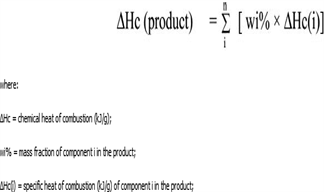 |
The chemical heats of combustion must be found in literature, calculated or determined by tests (See ASTM D240-02 (Reapproved 2007), Standard Test Method for Heat of Combustion of Liquid Hydrocarbon Fuels by Bomb Calorimeter, ISO 13943:2000 (E/F), Fire Safety—Vocabulary, First Edition, April 15, 2000, Sections 86.1 to 86.3, and NFPA 30B, Code for the Manufacture and Storage of Aerosol Products, 2007 Edition).
B.3.3.3 The Ignition Distance Test, Enclosed Space Ignition Test and Aerosol Foam Flammability Test must be performed in accordance with sub-sections 31.4, 31.5 and 31.6 of the of the UN ST/SG/AC.10/Rev. 4, The UN Recommendations of the Transport of Dangerous Goods, Manual of Tests and Criteria, Fourth Revised Edition, 2003.
B.4 OXIDIZING GASES
B.4.1 Definition
Oxidizing gas means any gas which may, generally by providing oxygen, cause or contribute to the combustion of other material more than air does.
NOTE: "Gases which cause or contribute to the combustion of other material more than air does" means pure gases or gas mixtures with an oxidizing power greater than 23.5% (as determined by a method specified in ISO 10156:1996 (E), Gases and Gas Mixtures—Determination of Fire Potential and Oxidizing Ability for the Selection of Cylinder Valve Outlets, Second Edition, Feb. 15, 1996, 10156-2:2005 (E), Gas Cylinders—Gases and Gas Mixtures—Part 2:Determination of Oxidizing Ability of Toxic and Corrosive Gases and Gas Mixtures, First Edition Aug. 1, 2005 or an equivalent testing method).
B.4.2 Classification criteria
An oxidizing gas must classified in a single category for this class in accordance with Table B.4.1:
TABLE B.4.1—CRITERIA FOR OXIDIZING GASES
Category | Criteria |
1 | Any gas which may, generally by providing oxygen, cause or contribute to the combustion of other material more than air does. |
B.4.3 Additional classification considerations
Classification must be in accordance with tests or calculation methods as described in ISO 10156:1996 (E), Gases and Gas Mixtures—Determination of Fire Potential and Oxidizing Ability for the Selection of Cylinder Valve Outlets, Second Edition, Feb. 15, 1996 and ISO 10156-2:2005 (E), Gas Cylinders—Gases and Gas Mixtures—Part 2: Determination of Oxidizing Ability of Toxic and Corrosive Gases and Gas Mixtures, First Edition Aug. 1, 2005.
B.5 GASES UNDER PRESSURE
B.5.1 Definition
Gases under pressure are gases which are contained in a receptacle at a pressure of 200 kPa (29 psi) (gauge) or more, or which are liquefied or liquefied and refrigerated.
They comprise compressed gases, liquefied gases, dissolved gases and refrigerated liquefied gases.
B.5.2 Classification criteria
Gases under pressure must be classified in one of four groups in accordance with Table B.5.1:
TABLE B.5.1—CRITERIA FOR GASES UNDER PRESSURE
Group | Criteria |
Compressed gas | A gas which when under pressure is entirely gaseous at -50°C (-58°F), including all gases with a critical temperature1 ≤ 50°C (-58°F). |
Liquefied gas | A gas which when under pressure is partially liquid at temperatures above -50°C (-58°F). A distinction is made between: (a) High pressure liquefied gas: a gas with a critical temperature1 between -50°C (-58°F) and +65°C (149°F); and (b) Low pressure liquefied gas: a gas with a critical temperature1 above +65°C (149°F). |
Refrigerated liquefied gas | A gas which is made partially liquid because of its low temperature. |
Dissolved gas | A gas which when under pressure is dissolved in a liquid phase solvent. |
1 The critical temperature is the temperature above which a pure gas cannot be liquefied, regardless of the degree of compression.
B.6 FLAMMABLE LIQUIDS
B.6.1 Definition
Flammable liquid means a liquid having a flash point of not more than 93°C (199.4°F).
Flash point means the minimum temperature at which a liquid gives off vapor in sufficient concentration to form an ignitable mixture with air near the surface of the liquid, as determined by a method identified in Section B.6.3.
B.6.2 Classification criteria
A flammable liquid must be classified in one of four categories in accordance with Table B.6.1:
TABLE B.6.1—CRITERIA FOR FLAMMABLE LIQUIDS
Category | Criteria |
1 | Flash point < 23°C (73.4°F) and initial boiling point ≤ 35°C (95°F) |
2 | Flash point < 23°C (73.4°F) and initial boiling point ˃ 35°C (95°F) |
3 | Flash point ≥ 23°C (73.4°F) and ≤ 60°C (140°F) |
4 | Flash point ˃ 60°C (140°F) and ≤ 93°C (199.4°F) |
B.6.3 Additional classification considerations
The flash point must be determined in accordance with ASTM D56-05, Standard Test Method for Flash Point by Tag Closed Cup Tester, ASTM D3278-96 (Reapproved 2004) E1, Standard Test Methods for Flash Point of Liquids by Small Scale Closed-Cup Apparatus, ASTM D3828-07a, Standard Test Methods for Flash Point by Small Scale Closed Cup Tester, Approved, ASTM D93-08, Standard Test Methods for Flash Point by Pensky-Martens Closed Cup Tester, or any other method specified in GHS Revision 3, Chapter 2.6.
The initial boiling point must be determined in accordance with ASTM D86-07a, Standard Test Method for Distillation of Petroleum Products at Atmospheric Pressure or ASTM D1078-05, Standard Test Method for Distillation Range of Volatile Organic Liquids.
B.7 FLAMMABLE SOLIDS
B.7.1 Definitions
Flammable solid means a solid which is a readily combustible solid, or which may cause or contribute to fire through friction.
Readily combustible solids are powdered, granular, or pasty chemicals which are dangerous if they can be easily ignited by brief contact with an ignition source, such as a burning match, and if the flame spreads rapidly.
B.7.2 Classification criteria
B.7.2.1 Powdered, granular or pasty chemicals must be classified as flammable solids when the time of burning of one or more of the test runs, performed in accordance with the test method described in the UN ST/SG/AC.10/Rev. 4, The UN Recommendations of the Transport of Dangerous Goods, Manual of Tests and Criteria, Fourth Revised Edition, 2003, Part III, sub-section 33.2.1, is less than 45 s or the rate of burning is more than 2.2 mm/s (0.0866 in/s).
B.7.2.2 Powders of metals or metal alloys must be classified as flammable solids when they can be ignited and the reaction spreads over the whole length of the sample in 10 min or less.
B.7.2.3 Solids which may cause fire through friction must be classified in this class by analogy with existing entries (e.g., matches) until definitive criteria are established.
B.7.2.4 A flammable solid must be classified in one of the two categories for this class using Method N.1 as described in Part III, sub-section 33.2.1 of the UN ST/SG/AC.10/Rev. 4, The UN Recommendations of the Transport of Dangerous Goods, Manual of Tests and Criteria, Fourth Revised Edition, 2003, in accordance with Table B.7.1:
TABLE B.7.1—CRITERIA FOR FLAMMABLE SOLIDS
Category | Criteria |
1 | Burning rate test: Chemicals other than metal powders: (a) wetted zone does not stop fire; and (b) burning time <45 s or burning rate ˃2.2 mm/s Metal powders: burning time ≤5 min |
2 | Burning rate test: Chemicals other than metal powders: (a) wetted zone stops the fire for at least 4 min; and ˃ (b) burning time <45 s or burning rate ˃2.2 mm/s Metal powders: burning time ˃5 min and ≤10 min |
NOTE: Classification of solid chemicals must be based on tests performed on the chemical as presented. If, for example, for the purposes of supply or transport, the same chemical is to be presented in a physical form different from that which was tested and which is considered likely to materially alter its performance in a classification test, classification must be based on testing of the chemical in the new form.
B.8 SELF-REACTIVE CHEMICALS
B.8.1 Definitions
Self-reactive chemicals are thermally unstable liquid or solid chemicals liable to undergo a strongly exothermic decomposition even without participation of oxygen (air). This definition excludes chemicals classified under this section as explosives, organic peroxides, oxidizing liquids or oxidizing solids.
A self-reactive chemical is regarded as possessing explosive properties when in laboratory testing the formulation is liable to detonate, to deflagrate rapidly or to show a violent effect when heated under confinement.
B.8.2 Classification criteria
B.8.2.1 A self-reactive chemical must be considered for classification in this class unless:
(a) It is classified as an explosive according to B.1 of this appendix;
(b) It is classified as an oxidizing liquid or an oxidizing solid according to B.13 or B.14 of this appendix, except that a mixture of oxidizing substances which contains 5% or more of combustible organic substances must be classified as a self-reactive chemical according to the procedure defined in B.8.2.2;
(c) It is classified as an organic peroxide according to B.15 of this appendix;
(d) Its heat of decomposition is less than 300 J/g; or
(e) Its self-accelerating decomposition temperature (SADT) is greater than 75°C (167°F) for a 50 kg (110 lb) package.
B.8.2.2 Mixtures of oxidizing substances, meeting the criteria for classification as oxidizing liquids or oxidizing solids, which contain 5% or more of combustible organic substances and which do not meet the criteria mentioned in B.8.2.1 (a), (c), (d) or (e), must be subjected to the self-reactive chemicals classification procedure in B.8.2.3. Such a mixture showing the properties of a self-reactive chemical type B to F must be classified as a self-reactive chemical.
B.8.2.3 Self-reactive chemicals must be classified in one of the seven categories of "types A to G" for this class, according to the following principles:
(a) Any self-reactive chemical which can detonate or deflagrate rapidly, as packaged, will be defined as self-reactive chemical TYPE A;
(b) Any self-reactive chemical possessing explosive properties and which, as packaged, neither detonates nor deflagrates rapidly, but is liable to undergo a thermal explosion in that package will be defined as self-reactive chemical TYPE B;
(c) Any self-reactive chemical possessing explosive properties when the chemical as packaged cannot detonate or deflagrate rapidly or undergo a thermal explosion will be defined as self-reactive chemical TYPE C;
(d) Any self-reactive chemical which in laboratory testing meets the criteria in (d)(i), (ii), or (iii) will be defined as self-reactive chemical TYPE D:
(i) Detonates partially, does not deflagrate rapidly and shows no violent effect when heated under confinement; or
(ii) Does not detonate at all, deflagrates slowly and shows no violent effect when heated under confinement; or
(iii) Does not detonate or deflagrate at all and shows a medium effect when heated under confinement;
(e) Any self-reactive chemical which, in laboratory testing, neither detonates nor deflagrates at all and shows low or no effect when heated under confinement will be defined as self-reactive chemical TYPE E;
(f) Any self-reactive chemical which, in laboratory testing, neither detonates in the cavitated state nor deflagrates at all and shows only a low or no effect when heated under confinement as well as low or no explosive power will be defined as self-reactive chemical TYPE F;
(g) Any self-reactive chemical which, in laboratory testing, neither detonates in the cavitated state nor deflagrates at all and shows no effect when heated under confinement nor any explosive power, provided that it is thermally stable (self-accelerating decomposition temperature is 60°C (140°F) to 75°C (167°F) for a 50 kg (110 lb) package), and, for liquid mixtures, a diluent having a boiling point greater than or equal to 150°C (302°F) is used for desensitization will be defined as self-reactive chemical TYPE G. If the mixture is not thermally stable or a diluent having a boiling point less than 150°C (302°F) is used for desensitization, the mixture must be defined as self-reactive chemical TYPE F.
B.8.3 Additional classification considerations
B.8.3.1 For purposes of classification, the properties of self-reactive chemicals must be determined in accordance with test series A to H as described in Part II of the UN ST/SG/AC.10/Rev. 4, The UN Recommendations on the Transport of Dangerous Goods, Manual of Tests and Criteria, Fourth Revised Edition, 2003.
B.8.3.2 Self-accelerating decomposition temperature (SADT) must be determined in accordance with the UN ST/SG/AC.10/Rev. 4, The UN Recommendations on the Transport of Dangerous Goods, Manual of Tests and Criteria, Fourth Revised Edition, 2003.
B.8.3.3 The classification procedures for self-reactive substances and mixtures need not be applied if:
(a) There are no chemical groups present in the molecule associated with explosive or self-reactive properties; examples of such groups are given in Tables A6.1 and A6.2 in the Appendix 6 of the UN ST/SG/AC.10/Rev. 4, The UN Recommendations on the Transport of Dangerous Goods, Manual of Tests and Criteria, Fourth Revised Edition, 2003; or
(b) For a single organic substance or a homogeneous mixture of organic substances, the estimated SADT is greater than 75°C (167°F) or the exothermic decomposition energy is less than 300 J/g. The onset temperature and decomposition energy may be estimated using a suitable calorimetric technique (See 20.3.3.3 in Part II of the UN ST/SG/AC.10/Rev. 4, the UN Recommendations on the Transport of Dangerous Goods, Manual of Tests and Criteria, Fourth Revised Edition, 2003).
B.9 PYROPHORIC LIQUIDS
B.9.1 Definition
Pyrophoric liquid means a liquid which, even in small quantities, is liable to ignite within five minutes after coming into contact with air.
B.9.2 Classification criteria
A pyrophoric liquid must be classified in a single category for this class using test N.3 in Part III, sub-section 33.3.1.5 of the UN ST/SG/AC.10/Rev. 4, The UN Recommendations on the Transport of Dangerous Goods, Manual of Tests and Criteria, Fourth Revised Edition, 2003, in accordance with Table B.9.1:
TABLE B.9.1—CRITERIA FOR PYROPHORIC LIQUIDS
Category | Criteria |
1 | The liquid ignites within 5 min when added to an inert carrier and exposed to air, or it ignites or chars a filter paper on contact with air within 5 min. |
B.9.3 Additional classification considerations
The classification procedure for pyrophoric liquids need not be applied when experience in production or handling shows that the chemical does not ignite spontaneously on coming into contact with air at normal temperatures (i.e., the substance is known to be stable at room temperature for prolonged periods of time (days)).
B.10 PYROPHORIC SOLIDS
B.10.1 Definition
Pyrophoric solid means a solid which, even in small quantities, is liable to ignite within five minutes after coming into contact with air.
B.10.2 Classification criteria
A pyrophoric solid must be classified in a single category for this class using test N.2 in Part III, sub-section 33.3.1.4 of the UN ST/SG/AC.10/Rev. 4, The UN Recommendations of the Transport of Dangerous Goods, Manual of Tests and Criteria, Fourth Revised Edition, 2003, in accordance with Table B.10.1:
TABLE B.10.1—CRITERIA FOR PYROPHORIC SOLIDS
Category | Criteria |
1 | The solid ignites within 5 min of coming into contact with air. |
NOTE: Classification of solid chemicals must be based on tests performed on the chemical as presented. If, for example, for the purposes of supply or transport, the same chemical is to be presented in a physical form different from that which was tested and which is considered likely to materially alter its performance in a classification test, classification must be based on testing of the chemical in the new form.
B.10.3 Additional classification considerations
The classification procedure for pyrophoric solids need not be applied when experience in production or handling shows that the chemical does not ignite spontaneously on coming into contact with air at normal temperatures (i.e., the chemical is known to be stable at room temperature for prolonged periods of time (days)).
B.11 SELF-HEATING CHEMICALS
B.11.1 Definition
A self-heating chemical is a solid or liquid chemical, other than a pyrophoric liquid or solid, which, by reaction with air and without energy supply, is liable to self-heat; this chemical differs from a pyrophoric liquid or solid in that it will ignite only when in large amounts (kilograms) and after long periods of time (hours or days).
NOTE: Self-heating of a substance or mixture is a process where the gradual reaction of that substance or mixture with oxygen (in air) generates heat. If the rate of heat production exceeds the rate of heat loss, then the temperature of the substance or mixture will rise which, after an induction time, may lead to self-ignition and combustion.
B.11.2 Classification criteria
B.11.2.1 A self-heating chemical must be classified in one of the two categories for this class if, in tests performed in accordance with test method N.4 in Part III, sub-section 33.3.1.6 of the UN ST/SG/AC.10/Rev. 4, The UN Recommendations on the Transport of Dangerous Goods, Manual of Tests and Criteria, Fourth Revised Edition, 2003, the result meets the criteria shown in Table B.11.1.
TABLE B.11.1—CRITERIA FOR SELF-HEATING CHEMICALS
Category | Criteria |
1 | A positive result is obtained in a test using a 25 mm sample cube at 140°C (284°F) |
2 | A negative result is obtained in a test using a 25 mm cube sample at 140°C (284°F), a positive result is obtained in a test using a 100 mm sample cube at 140°C (284°F), and: (a) The unit volume of the chemical is more than 3 m3; or (b) A positive result is obtained in a test using a 100 mm cube sample at 120°C (248°F) and the unit volume of the chemical is more than 450 liters; or (c) A positive result is obtained in a test using a 100 mm cube sample at 100°C (212°F). |
B.11.2.2 Chemicals with a temperature of spontaneous combustion higher than 50°C (122°F) for a volume of 27 m3 must not be classified as self-heating chemicals.
B.11.2.3 Chemicals with a spontaneous ignition temperature higher than 50°C (122°F) for a volume of 450 liters must not be classified in Category 1 of this class.
B.11.3 Additional classification considerations
B.11.3.1 The classification procedure for self-heating chemicals need not be applied if the results of a screening test can be adequately correlated with the classification test and an appropriate safety margin is applied.
B.11.3.2 Examples of screening tests are:
(a) The Grewer Oven test (VDI guideline 2263, part 1, 1990, Test methods for the Determination of the Safety Characteristics of Dusts) with an onset temperature 80°K above the reference temperature for a volume of 1 l;
(b) The Bulk Powder Screening Test (Gibson, N. Harper, D. J. Rogers, R. Evaluation of the fire and explosion risks in drying powders, Plant Operations Progress, 4 (3), 181-189, 1985) with an onset temperature 60°K above the reference temperature for a volume of 1 l.
B.12 CHEMICALS WHICH, IN CONTACT WITH WATER, EMIT FLAMMABLE GASES
B.12.1 Definition
Chemicals which, in contact with water, emit flammable gases are solid or liquid chemicals which, by interaction with water, are liable to become spontaneously flammable or to give off flammable gases in dangerous quantities.
B.12.2 Classification criteria
B.12.2.1 A chemical which, in contact with water, emits flammable gases must be classified in one of the three categories for this class, using test N.5 in Part III, sub-section 33.4.1.4 of the UN ST/SG/AC.10/Rev. 4, The UN Recommendations on the Transport of Dangerous Goods, Manual of Tests and Criteria, Fourth Revised Edition, 2003, in accordance with Table B.12.1:
TABLE B.12.1—CRITERIA FOR CHEMICALS WHICH, IN CONTACT WITH WATER, EMIT FLAMMABLE GASES
Category | Criteria |
1 | Any chemical which reacts vigorously with water at ambient temperatures and demonstrates generally a tendency for the gas produced to ignite spontaneously, or which reacts readily with water at ambient temperatures such that the rate of evolution of flammable gas is equal to or greater than 10 liters per kilogram of chemical over any one minute. |
2 | Any chemical which reacts readily with water at ambient temperatures such that the maximum rate of evolution of flammable gas is equal to or greater than 20 liters per kilogram of chemical per hour, and which does not meet the criteria for Category 1. |
3 | Any chemical which reacts slowly with water at ambient temperatures such that the maximum rate of evolution of flammable gas is equal to or greater than 1 liter per kilogram of chemical per hour, and which does not meet the criteria for Categories 1 and 2. |
NOTE: Classification of solid chemicals must be based on tests performed on the chemical as presented. If, for example, for the purposes of supply or transport, the same chemical is to be presented in a physical form different from that which was tested and which is considered likely to materially alter its performance in a classification test, classification must be based on testing of the chemical in the new form.
B.12.2.2 A chemical is classified as a chemical which, in contact with water, emits flammable gases if spontaneous ignition takes place in any step of the test procedure.
B.12.3 Additional classification considerations
The classification procedure for this class need not be applied if:
(a) The chemical structure of the chemical does not contain metals or metalloids;
(b) Experience in production or handling shows that the chemical does not react with water, (e.g., the chemical is manufactured with water or washed with water); or
(c) The chemical is known to be soluble in water to form a stable mixture.
B.13 OXIDIZING LIQUIDS
B.13.1 Definition
Oxidizing liquid means a liquid which, while in itself not necessarily combustible, may, generally by yielding oxygen, cause, or contribute to, the combustion of other material.
B.13.2 Classification criteria
An oxidizing liquid must be classified in one of the three categories for this class using test O.2 in Part III, sub-section 34.4.2 of the UN ST/SG/AC.10/Rev. 4, The UN Recommendations on the Transport of Dangerous Goods, Manual of Tests and Criteria, Fourth Revised Edition, 2003, in accordance with Table B.13.1:
TABLE B.13.1—CRITERIA FOR OXIDIZING LIQUIDS
Category | Criteria |
1 | Any chemical which, in the 1:1 mixture, by mass, of chemical and cellulose tested, spontaneously ignites; or the mean pressure rise time of a 1:1 mixture, by mass, of chemical and cellulose is less than that of a 1:1 mixture, by mass, of 50% perchloric acid and cellulose; |
2 | Any chemical which, in the 1:1 mixture, by mass, of chemical and cellulose tested, exhibits a mean pressure rise time less than or equal to the mean pressure rise time of a 1:1 mixture, by mass, of 40% aqueous sodium chlorate solution and cellulose; and the criteria for Category 1 are not met; |
3 | Any chemical which, in the 1:1 mixture, by mass, of chemical and cellulose tested, exhibits a mean pressure rise time less than or equal to the mean pressure rise time of a 1:1 mixture, by mass, of 65% aqueous nitric acid and cellulose; and the criteria for Categories 1 and 2 are not met. |
B.13.3 Additional classification considerations
B.13.3.1 For organic chemicals, the classification procedure for this class must not be applied if:
(a) The chemical does not contain oxygen, fluorine or chlorine; or
(b) The chemical contains oxygen, fluorine or chlorine and these elements are chemically bonded only to carbon or hydrogen.
B.13.3.2 For inorganic chemicals, the classification procedure for this class must not be applied if the chemical does not contain oxygen or halogen atoms.
B.13.3.3 In the event of divergence between test results and known experience in the handling and use of chemicals which shows them to be oxidizing, judgments based on known experience must take precedence over test results.
B.13.3.4 In cases where chemicals generate a pressure rise (too high or too low), caused by chemical reactions not characterizing the oxidizing properties of the chemical, the test described in Part III, sub-section 34.4.2 of the UN ST/SG/AC.10/Rev. 4, The UN Recommendations on the Transport of Dangerous Goods, Manual of Tests and Criteria, Fourth Revised Edition, 2003, must be repeated with an inert substance (e.g., diatomite (kieselguhr in place of the cellulose) in order to clarify the nature of the reaction).
B.14 OXIDIZING SOLIDS
B.14.1 Definition
Oxidizing solid means a solid which, while in itself is not necessarily combustible, may, generally by yielding oxygen, cause, or contribute to, the combustion of other material.
B.14.2 Classification criteria
An oxidizing solid must be classified in one of the three categories for this class using test O.1 in Part III, sub-section 34.4.1 of the UN ST/SG/AC.10/Rev. 4, The UN Recommendations on the Transport of Dangerous Goods, Manual of Tests and Criteria, Fourth Revised Edition, 2003, in accordance with Table B.14.1:
TABLE B.14.1—CRITERIA FOR OXIDIZING SOLIDS
Category | Criteria |
1 | Any chemical which, in the 4:1 or 1:1 sample-to-cellulose ratio (by mass) tested, exhibits a mean burning time less than the mean burning time of a 3:2 mixture, by mass, of potassium bromate and cellulose. |
2 | Any chemical which, in the 4:1 or 1:1 sample-to-cellulose ratio (by mass) tested, exhibits a mean burning time equal to or less than the mean burning time of a 2:3 mixture (by mass) of potassium bromate and cellulose and the criteria for Category 1 are not met. |
3 | Any chemical which, in the 4:1 or 1:1 sample-to-cellulose ratio (by mass) tested, exhibits a mean burning time equal to or less than the mean burning time of a 3:7 mixture (by mass) of potassium bromate and cellulose and the criteria for Categories 1 and 2 are not met. |
NOTE 1: Some oxidizing solids may present explosion hazards under certain conditions (e.g., when stored in large quantities). For example, some types of ammonium nitrate may give rise to an explosion hazard under extreme conditions and the "Resistance to detonation test" (IMO: Code of Safe Practice for Solid Bulk Cargoes, 2005, Annex 3, Test 5) may be used to assess this hazard. When information indicates that an oxidizing solid may present an explosion hazard, it must be indicated on the Safety Data Sheet.
NOTE 2: Classification of solid chemicals must be based on tests performed on the chemical as presented. If, for example, for the purposes of supply or transport, the same chemical is to be presented in a physical form different from that which was tested and which is considered likely to materially alter its performance in a classification test, classification must be based on testing of the chemical in the new form.
B.14.3 Additional classification considerations
B.14.3.1 For organic chemicals, the classification procedure for this class must not be applied if:
(a) The chemical does not contain oxygen, fluorine or chlorine; or
(b) The chemical contains oxygen, fluorine or chlorine and these elements are chemically bonded only to carbon or hydrogen.
B.14.3.2 For inorganic chemicals, the classification procedure for this class must not be applied if the chemical does not contain oxygen or halogen atoms.
B.14.3.3 In the event of divergence between test results and known experience in the handling and use of chemicals which shows them to be oxidizing, judgements based on known experience must take precedence over test results.
B.15 ORGANIC PEROXIDES
B.15.1 Definition
B.15.1.1 Organic peroxide means a liquid or solid organic chemical which contains the bivalent -0-0- structure and as such is considered a derivative of hydrogen peroxide, where one or both of the hydrogen atoms have been replaced by organic radicals. The term organic peroxide includes organic peroxide mixtures containing at least one organic peroxide. Organic peroxides are thermally unstable chemicals, which may undergo exothermic self-accelerating decomposition. In addition, they may have one or more of the following properties:
(a) Be liable to explosive decomposition;
(b) Burn rapidly;
(c) Be sensitive to impact or friction;
(d) React dangerously with other substances.
B.15.1.2 An organic peroxide is regarded as possessing explosive properties when in laboratory testing the formulation is liable to detonate, to deflagrate rapidly or to show a violent effect when heated under confinement.
B.15.2 Classification criteria
B.15.2.1 Any organic peroxide must be considered for classification in this class, unless it contains:
(a) Not more than 1.0% available oxygen from the organic peroxides when containing not more than 1.0% hydrogen peroxide; or
(b) Not more than 0.5% available oxygen from the organic peroxides when containing more than 1.0% but not more than 7.0% hydrogen peroxide.
NOTE: The available oxygen content (%) of an organic peroxide mixture is given by the formula:
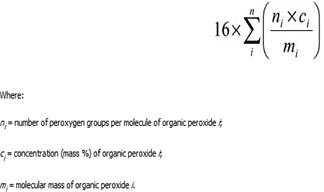 |
B.15.2.2 Organic peroxides must be classified in one of the seven categories of "Types A to G" for this class, according to the following principles:
(a) Any organic peroxide which, as packaged, can detonate or deflagrate rapidly must be defined as organic peroxide TYPE A;
(b) Any organic peroxide possessing explosive properties and which, as packaged, neither detonates nor deflagrates rapidly, but is liable to undergo a thermal explosion in that package must be defined as organic peroxide TYPE B;
(c) Any organic peroxide possessing explosive properties when the chemical as packaged cannot detonate or deflagrate rapidly or undergo a thermal explosion must be defined as organic peroxide TYPE C;
(d) Any organic peroxide which in laboratory testing meets the criteria in (d)(i), (ii), or (iii) must be defined as organic peroxide TYPE D:
(i) detonates partially, does not deflagrate rapidly and shows no violent effect when heated under confinement; or
(ii) does not detonate at all, deflagrates slowly and shows no violent effect when heated under confinement; or
(iii) does not detonate or deflagrate at all and shows a medium effect when heated under confinement;
(e) Any organic peroxide which, in laboratory testing, neither detonates nor deflagrates at all and shows low or no effect when heated under confinement must be defined as organic peroxide TYPE E;
(f) Any organic peroxide which, in laboratory testing, neither detonates in the cavitated state nor deflagrates at all and shows only a low or no effect when heated under confinement as well as low or no explosive power must be defined as organic peroxide TYPE F;
(g) Any organic peroxide which, in laboratory testing, neither detonates in the cavitated state nor deflagrates at all and shows no effect when heated under confinement nor any explosive power, provided that it is thermally stable (self-accelerating decomposition temperature is 60°C (140°F) or higher for a 50 kg (110 lb) package), and, for liquid mixtures, a diluent having a boiling point of not less than 150°C (302°F) is used for desensitization, must be defined as organic peroxide TYPE G. If the organic peroxide is not thermally stable or a diluent having a boiling point less than 150°C (302°F) is used for desensitization, it must be defined as organic peroxide TYPE F.
B.15.3 Additional classification considerations
B.15.3.1 For purposes of classification, the properties of organic peroxides must be determined in accordance with test series A to H as described in Part II of the UN ST/SG/AC.10/Rev. 4, The UN Recommendations on the Transport of Dangerous Goods, Manual of Tests and Criteria, Fourth Revised Edition, 2003.
B.15.3.2 Self-accelerating decomposition temperature (SADT) must be determined in accordance with the UN ST/SG/AC.10/Rev. 4, The UN Recommendations on the Transport of Dangerous Goods, Manual of Tests and Criteria, Fourth Revised Edition, 2003, Part II, section 28.
B.15.3.3 Mixtures of organic peroxides may be classified as the same type of organic peroxide as that of the most dangerous ingredient. However, as two stable ingredients can form a thermally less stable mixture, the SADT of the mixture must be determined.
B.16 CORROSIVE TO METALS
B.16.1 Definition
A chemical which is corrosive to metals means a chemical which by chemical action will materially damage, or even destroy, metals.
B.16.2 Classification criteria
A chemical which is corrosive to metals must be classified in a single category for this class, using the test in Part III, sub-section 37.4 of the UN ST/SG/AC.10/Rev. 4, The UN Recommendations on the Transport of Dangerous Goods, Manual of Tests and Criteria, Fourth Revised Edition, 2003, in accordance with Table B.16.1:
TABLE B.16.1—CRITERIA FOR CHEMICALS CORROSIVE TO METAL
Category | Criteria |
1 | Corrosion rate on either steel or aluminium surfaces exceeding 6.25 mm per year at a test temperature of 55°C (131°F) when tested on both materials. |
NOTE: Where an initial test on either steel or aluminium indicates the chemical being tested is corrosive the follow-up test on the other metal is not necessary.
B.16.3 Additional classification considerations
The specimen to be used for the test must be made of the following materials:
(a) For the purposes of testing steel, steel types S235JR+CR (1.0037 resp.St 37-2), S275J2G3+CR (1.0144 resp.St 44-3), ISO 3574, Unified Numbering System (UNS) G 10200, or SAE 1020;
(b) For the purposes of testing aluminium: non-clad types 7075-T6 or AZ5GU-T6.
[Statutory Authority: RCW 49.17.010, 49.17.040, 49.17.050, 49.17.060 and 29 C.F.R. 1910 Subpart Z. WSR 14-07-086, § 296-901-14024, filed 3/18/14, effective 5/1/14; WSR 13-06-050, § 296-901-14024, filed 3/5/13, effective 4/15/13.]
Reviser's note: The brackets and enclosed material in the text of the above section occurred in the copy filed by the agency.
PDF296-901-14026
Appendix C—Allocation of label elements.
C.1 The label for each hazardous chemical must include the product identifier used on the safety data sheet.
C.1.1 The labels on shipped containers must also include the name, address, and telephone number of the chemical manufacturer, importer, or responsible party.
C.2 The label for each hazardous chemical that is classified must include the signal word, hazard statement(s), pictogram(s), and precautionary statement(s) specified in C.4 for each hazard class and associated hazard category, except as provided for in C.2.1 through C.2.4.
C.2.1 Precedence of hazard information
C.2.1.1 If the signal word "Danger" is included, the signal word "Warning" must not appear.
C.2.1.2 If the skull and crossbones pictogram is included, the exclamation mark pictogram must not appear where it is used for acute toxicity.
C.2.1.3 If the corrosive pictogram is included, the exclamation mark pictogram must not appear where it is used for skin or eye irritation.
C.2.1.4 If the health hazard pictogram is included for respiratory sensitization, the exclamation mark pictogram must not appear where it is used for skin sensitization or for skin or eye irritation.
C.2.2 Hazard statement text
C.2.2.1 The text of all applicable hazard statements must appear on the label, except as otherwise specified. The information in italics must be included as part of the hazard statement as provided. For example: "causes damage to organs (state all organs affected) through prolonged or repeated exposure (state route of exposure if no other routes of exposure cause the hazard)". Hazard statements may be combined where appropriate to reduce the information on the label and improve readability, as long as all of the hazards are conveyed as required.
C.2.2.2 If the chemical manufacturer, importer, or responsible party can demonstrate that all or part of the hazard statement is inappropriate to a specific substance or mixture, the corresponding statement may be omitted from the label.
C.2.3 Pictograms
C.2.3.1 Pictograms must be in the shape of a square set at a point and must include a black hazard symbol on a white background with a red frame sufficiently wide to be clearly visible. A square red frame set at a point without a hazard symbol is not a pictogram and is not permitted on the label.
C.2.3.2 One of eight standard hazard symbols must be used in each pictogram. The eight hazard symbols are depicted in Figure C.1. A pictogram using the exclamation mark symbol is presented in Figure C.2, for the purpose of illustration.
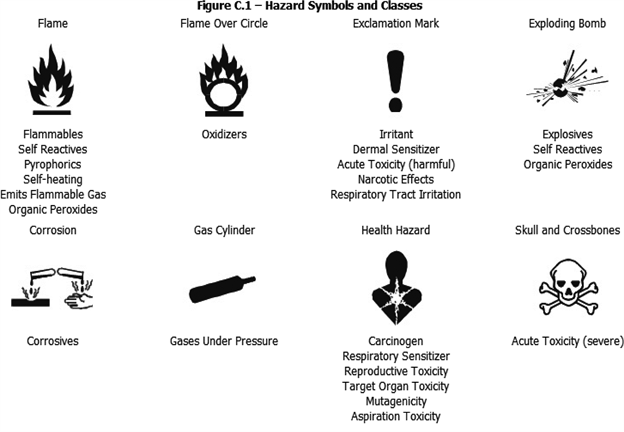 |
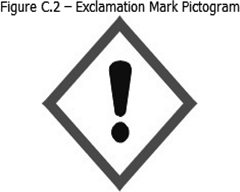 |
C.2.3.3 Where a pictogram required by the Department of Transportation under Title 49 of the Code of Federal Regulations appears on a shipped container, the pictogram specified in C.4 for the same hazard must not appear.
C.2.4 Precautionary statement text
C.2.4.1 There are four types of precautionary statements presented, "prevention," "response," "storage," and "disposal." The core part of the precautionary statement is presented in bold print. This is the text, except as otherwise specified, that must appear on the label. Where additional information is required, it is indicated in plain text.
C.2.4.2 When a backslash or diagonal mark (/) appears in the precautionary statement text, it indicates that a choice has to be made between the separated phrases. In such cases, the chemical manufacturer, importer, or responsible party can choose the most appropriate phrase(s). For example, "Wear protective gloves/protective clothing/eye protection/face protection" could read "wear eye protection".
C.2.4.3 When three full stops (…) appear in the precautionary statement text, they indicate that all applicable conditions are not listed. For example, in "Use explosion-proof electrical/ventilating/lighting/…/equipment", the use of "…" indicates that other equipment may need to be specified. In such cases, the chemical manufacturer, importer, or responsible party can choose the other conditions to be specified.
C.2.4.4 When text in italics is used in a precautionary statement, this indicates specific conditions applying to the use or allocation of the precautionary statement. For example, "Use explosion-proof electrical/ventilating/lighting/…/equipment" is only required for flammable solids "if dust clouds can occur". Text in italics is intended to be an explanatory, conditional note and is not intended to appear on the label.
C.2.4.5 Where square brackets ([ ]) appear around text in a precautionary statement, this indicates that the text in square brackets is not appropriate in every case and must be used only in certain circumstances. In these cases, conditions for use explaining when the text must be used are provided. For example, one precautionary statement states: "[In case of inadequate ventilation] wear respiratory protection." This statement is given with the condition for use "- text in square brackets may be used if additional information is provided with the chemical at the point of use that explains what type of ventilation would be adequate for safe use". This means that, if additional information is provided with the chemical explaining what type of ventilation would be adequate for safe use, the text in square brackets must be used and the statement would read: "In case of inadequate ventilation wear respiratory protection." However, if the chemical is supplied without such ventilation information, the text in square brackets must not be used, and the precautionary statement must read: "Wear respiratory protection."
C.2.4.6 Precautionary statements may be combined or consolidated to save label space and improve readability. For example, "Keep away from heat, sparks and open flame," "Store in a well-ventilated place" and "Keep cool" can be combined to read "Keep away from heat, sparks and open flame and store in a cool, well-ventilated place."
C.2.4.7 In most cases, the precautionary statements are independent (e.g., the phrases for explosive hazards do not modify those related to certain health hazards, and products that are classified for both hazard classes must bear appropriate precautionary statements for both). Where a chemical is classified for a number of hazards, and the precautionary statements are similar, the most stringent must be included on the label (this will be applicable mainly to preventive measures). An order of precedence may be imposed by the chemical manufacturer, importer or responsible party in situations where phrases concern "Response." Rapid action may be crucial. For example, if a chemical is carcinogenic and acutely toxic, rapid action may be crucial, and first aid measures for acute toxicity will take precedence over those for long-term effects. In addition, medical attention to delayed health effects may be required in cases of incidental exposure, even if not associated with immediate symptoms of intoxication.
C.2.4.8 If the chemical manufacturer, importer, or responsible party can demonstrate that a precautionary statement is inappropriate to a specific substance or mixture, the precautionary statement may be omitted from the label.
C.3 Supplementary hazard information
C.3.1 To ensure that non-standardized information does not lead to unnecessarily wide variation or undermine the required information, supplementary information on the label is limited to when it provides further detail and does not contradict or cast doubt on the validity of the standardized hazard information.
C.3.2 Where the chemical manufacturer, importer, or distributor chooses to add supplementary information on the label, the placement of supplemental information must not impede identification of information required by this section.
C.3.3 Where an ingredient with unknown acute toxicity is used in a mixture at a concentration ≥ 1%, and the mixture is not classified based on testing of the mixture as a whole, a statement that X% of the mixture consists of ingredient(s) of unknown acute toxicity is required on the label.
C.4 REQUIREMENTS FOR SIGNAL WORDS, HAZARD STATEMENTS, PICTOGRAMS, AND PRECAUTIONARY STATEMENTS
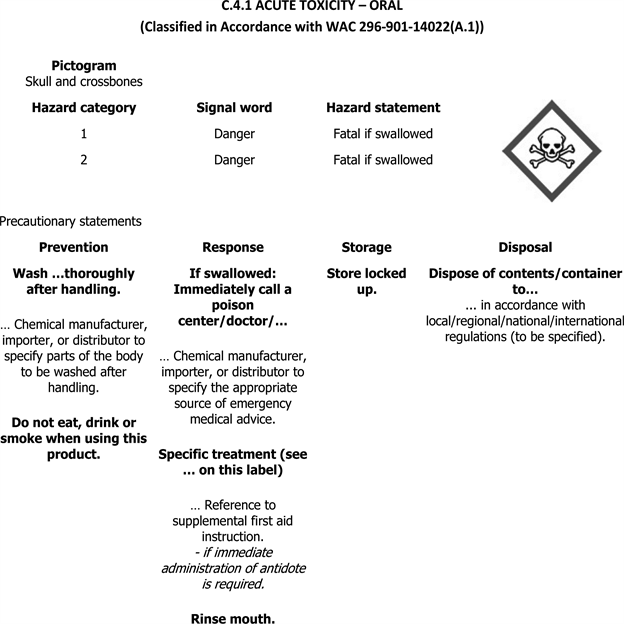 |
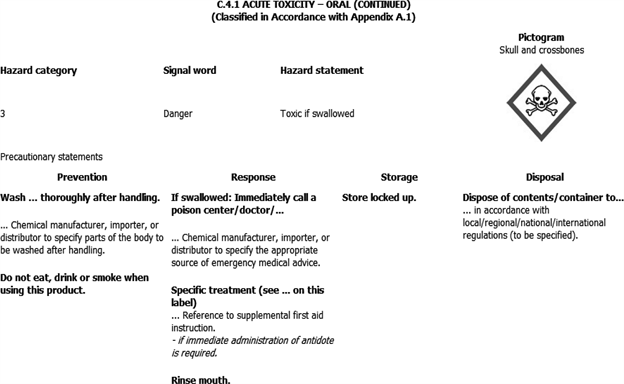 |
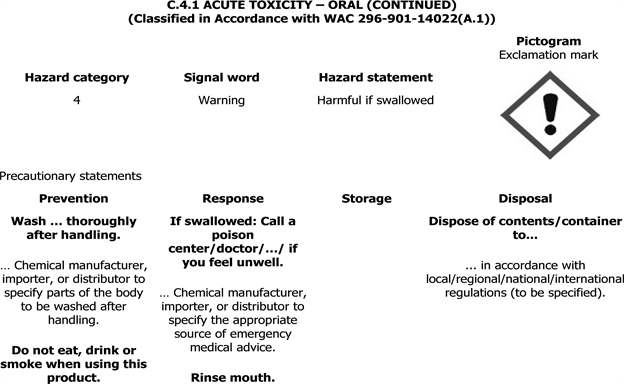 |
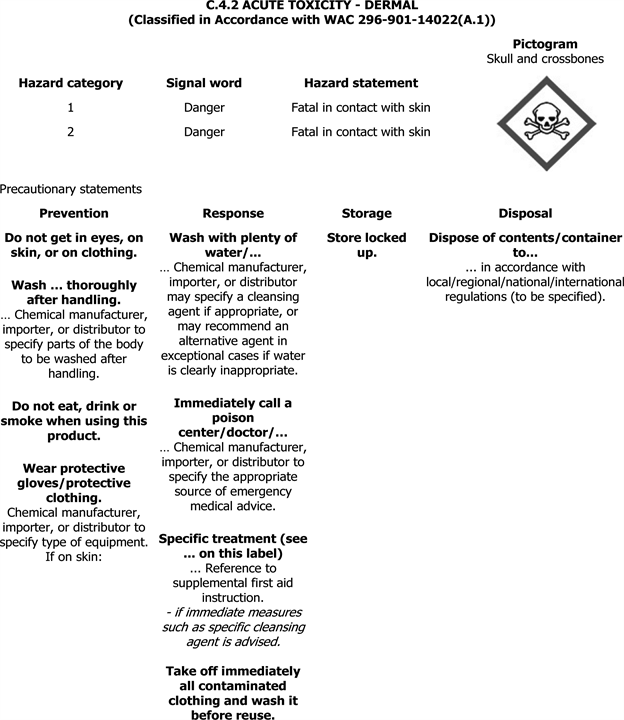 |
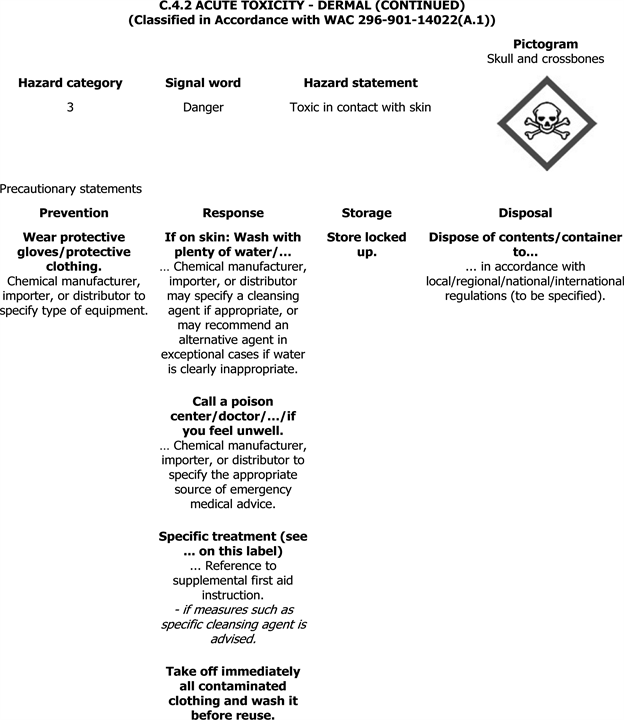 |
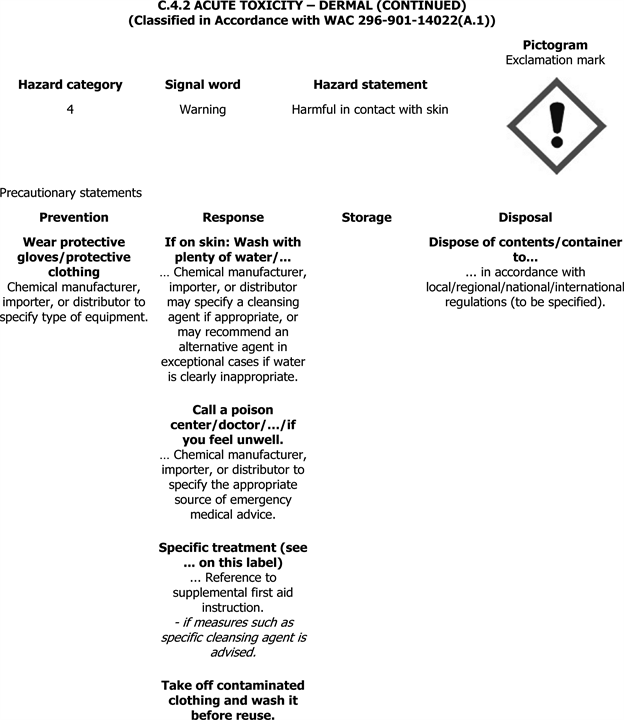 |
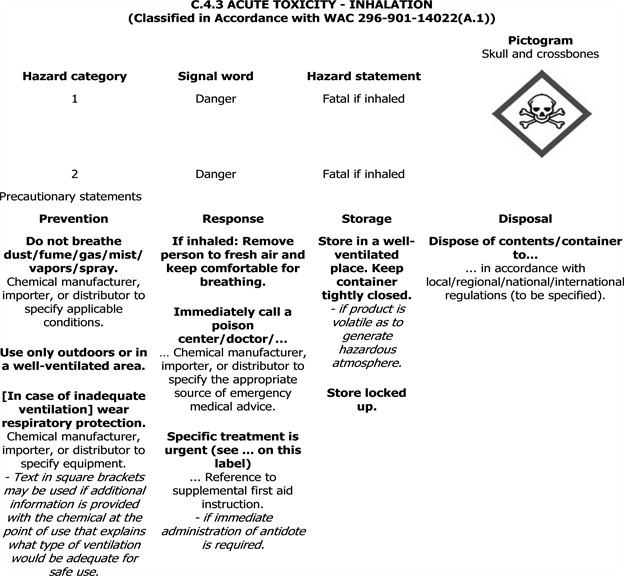 |
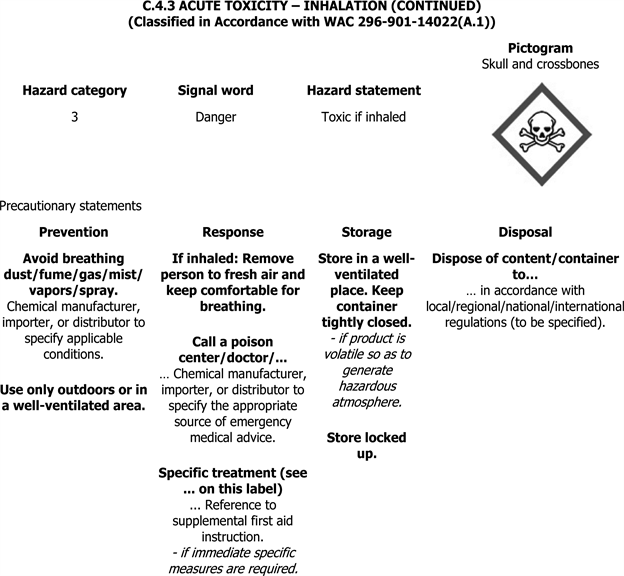 |
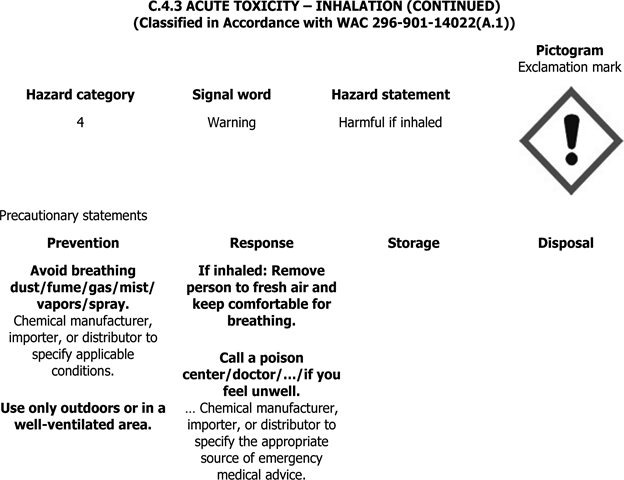 |
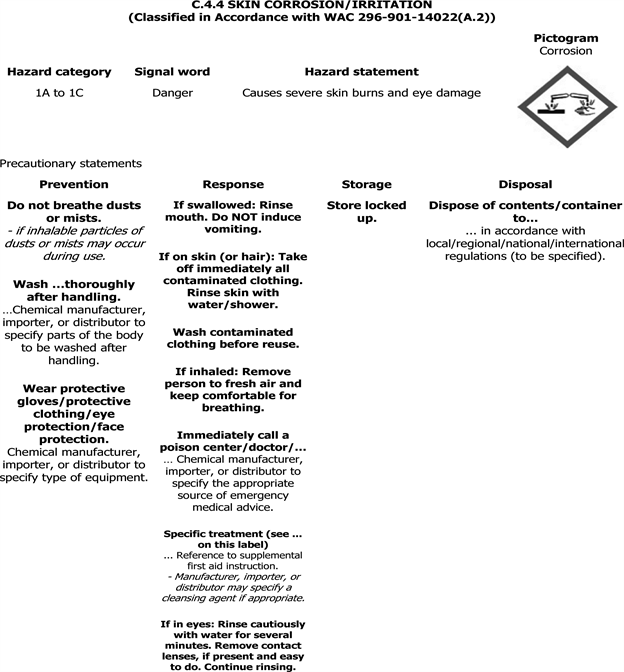 |
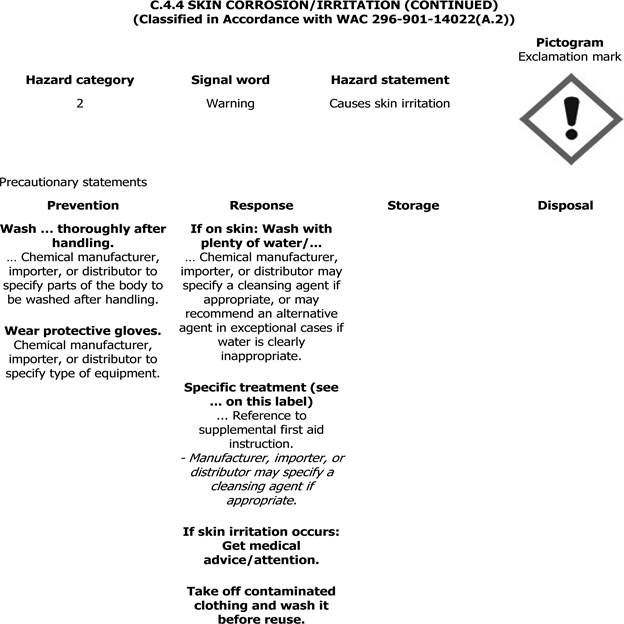 |
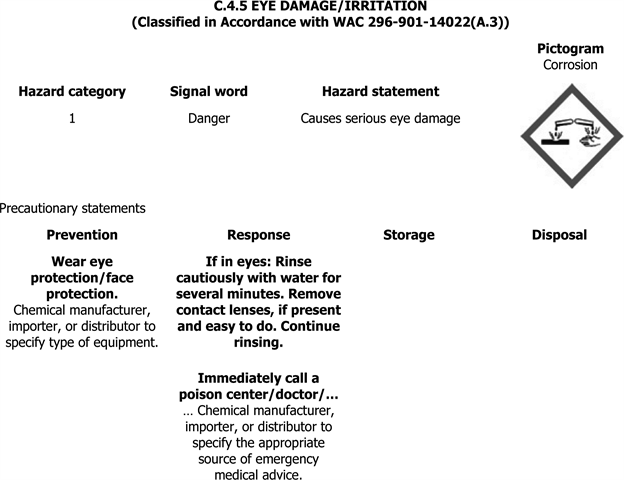 |
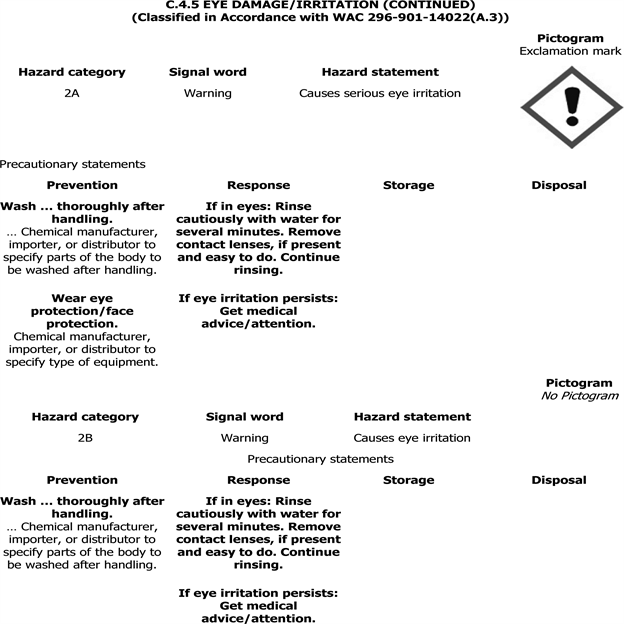 |
 |
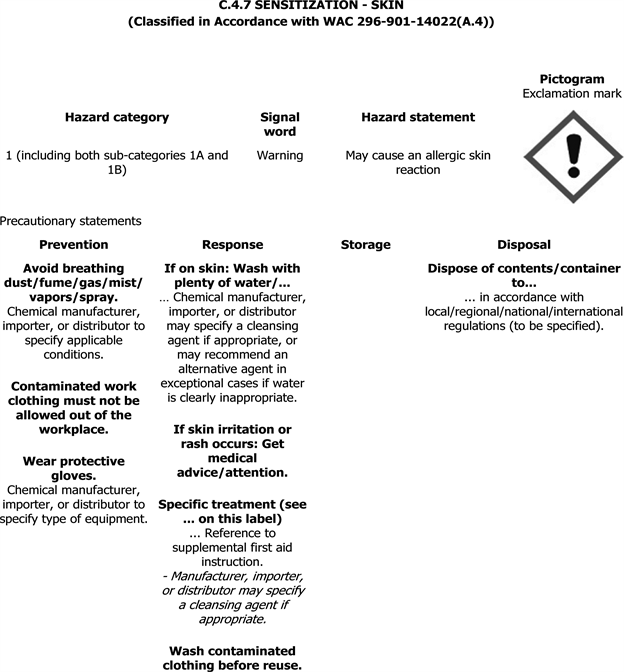 |
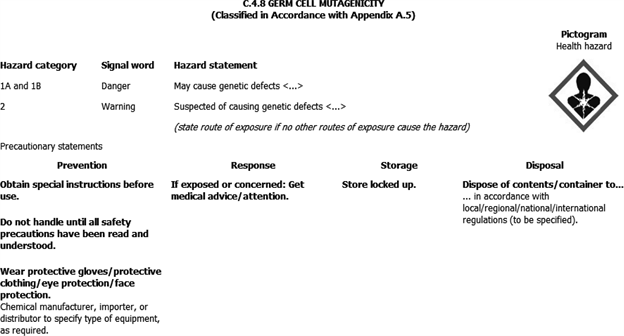 |
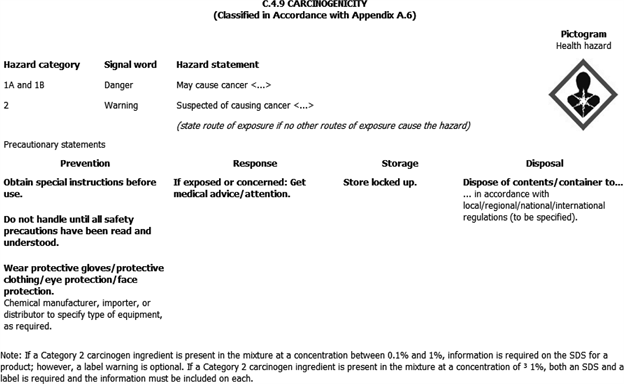 |
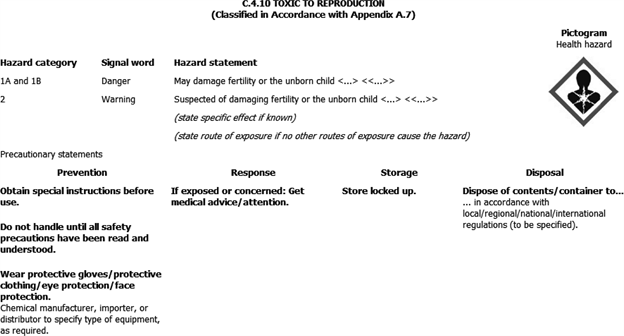 |
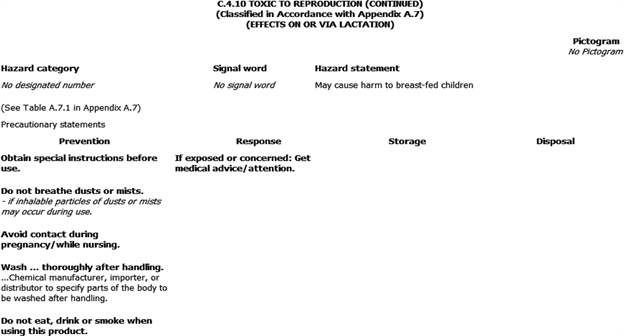 |
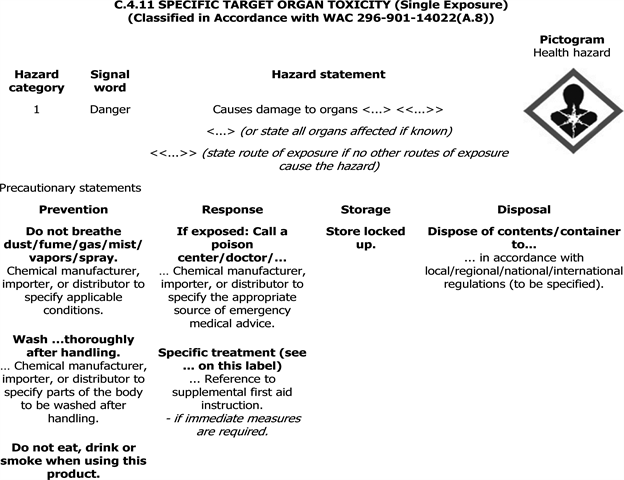 |
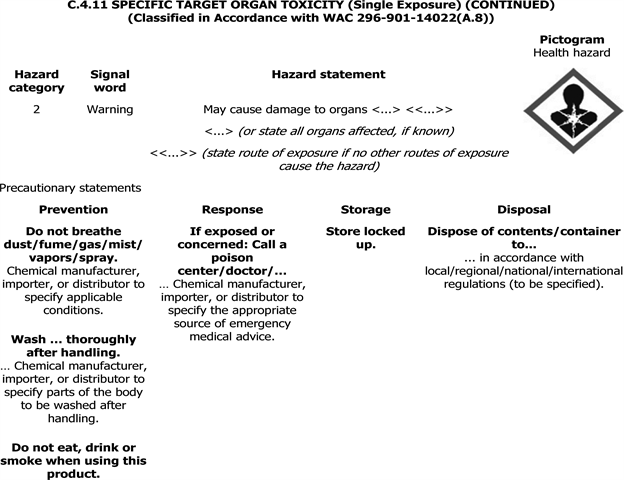 |
 |
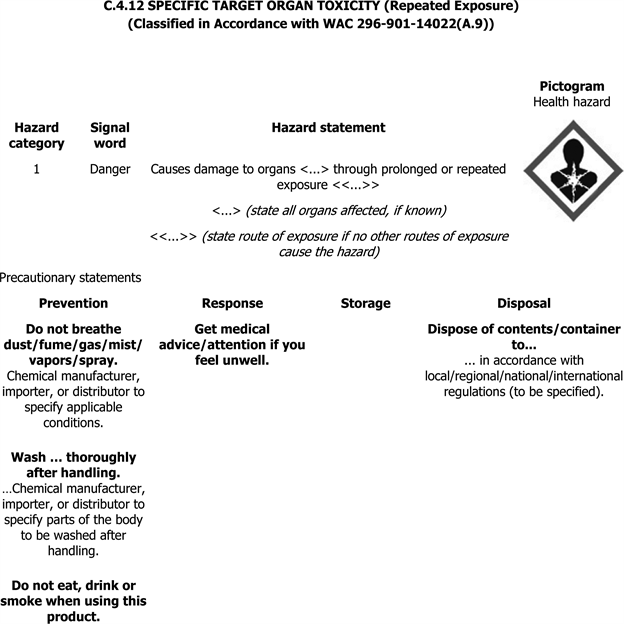 |
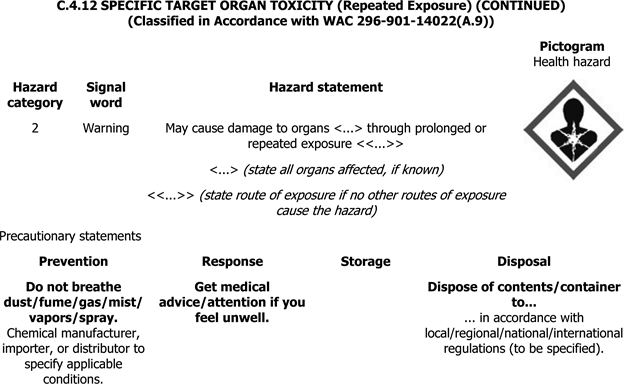 |
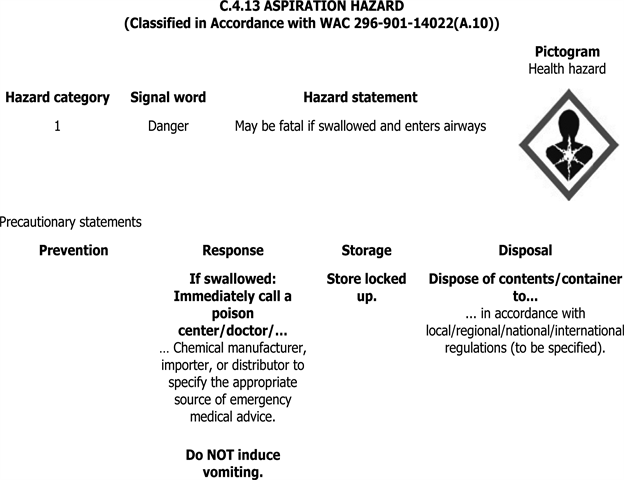 |
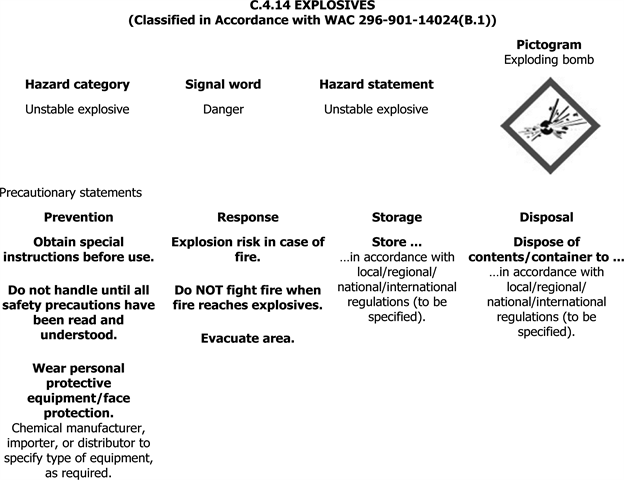 |
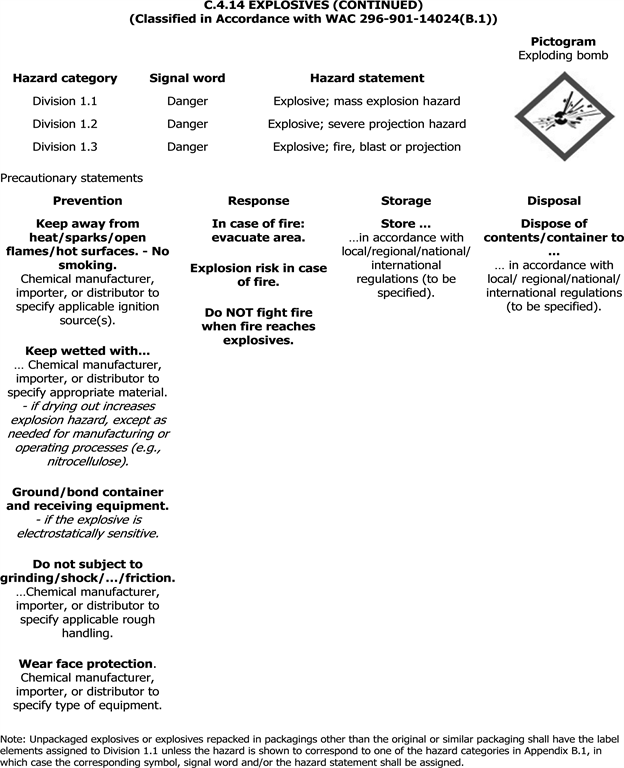 |
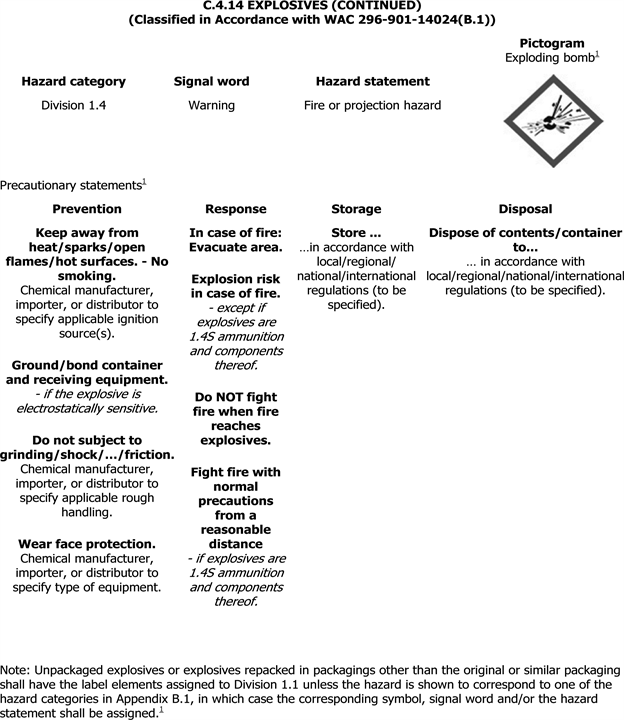 |
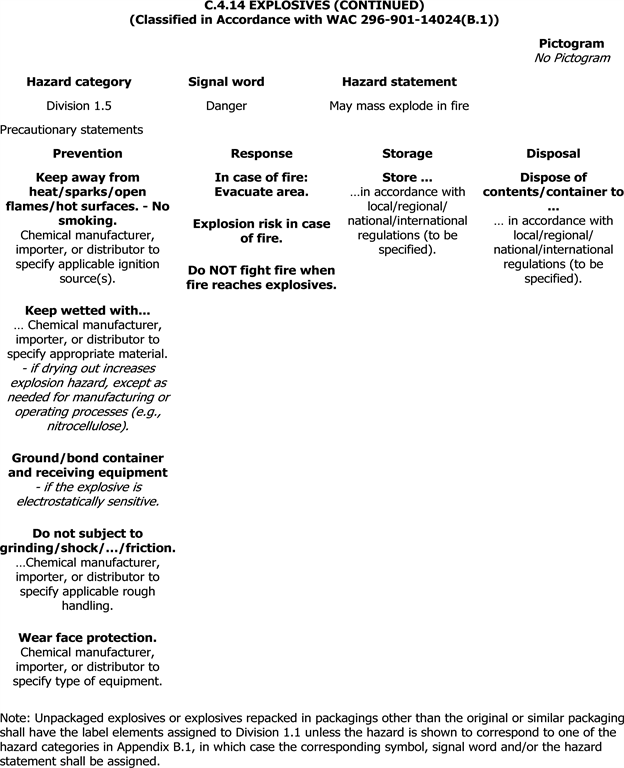 |
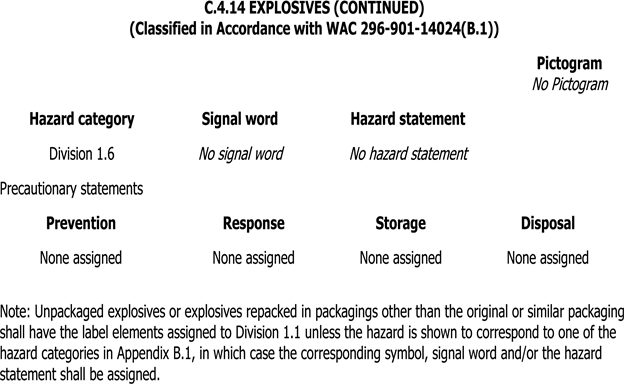 |
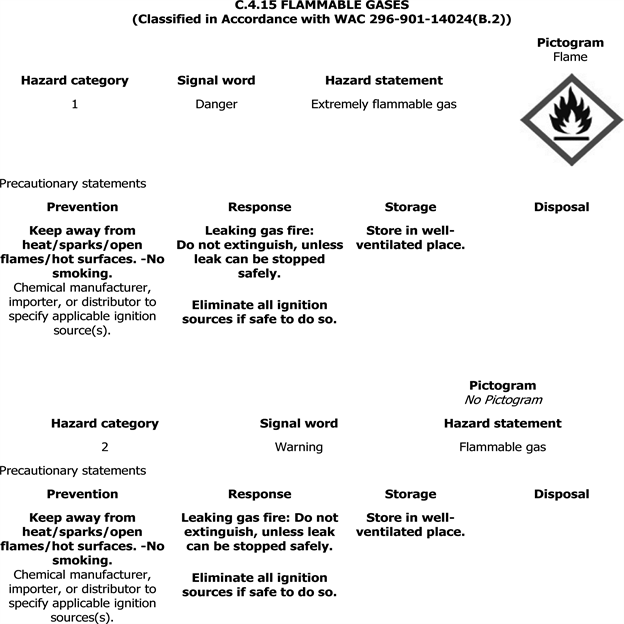 |
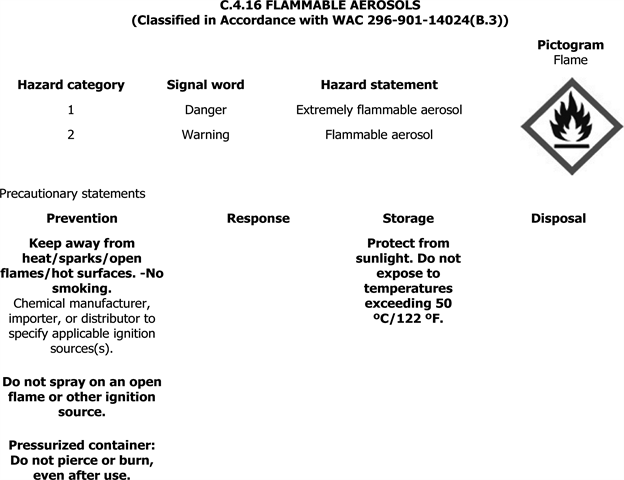 |
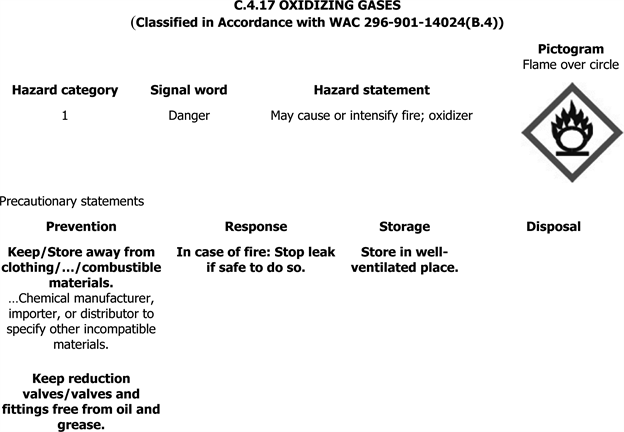 |
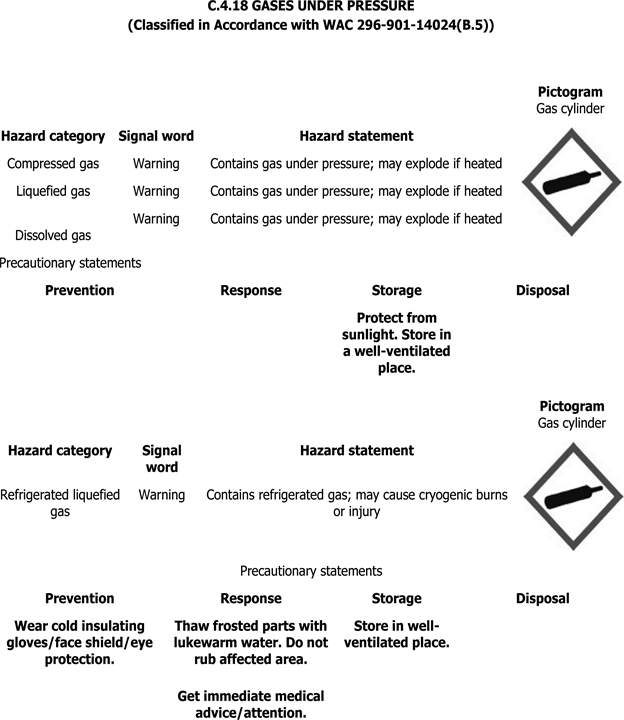 |
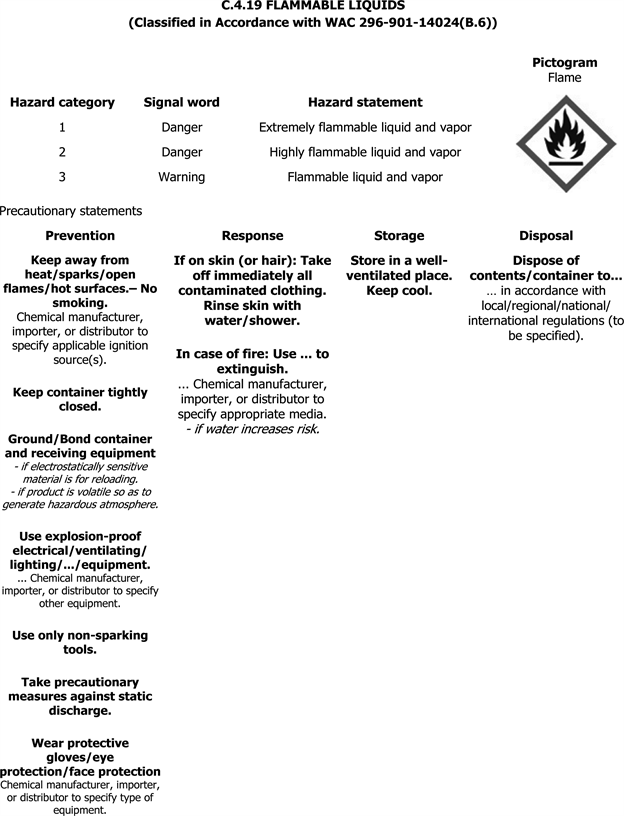 |
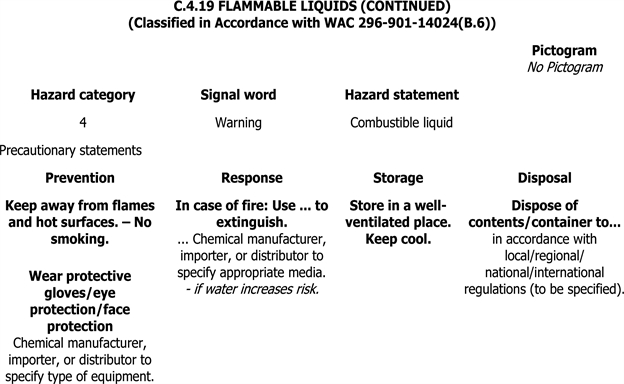 |
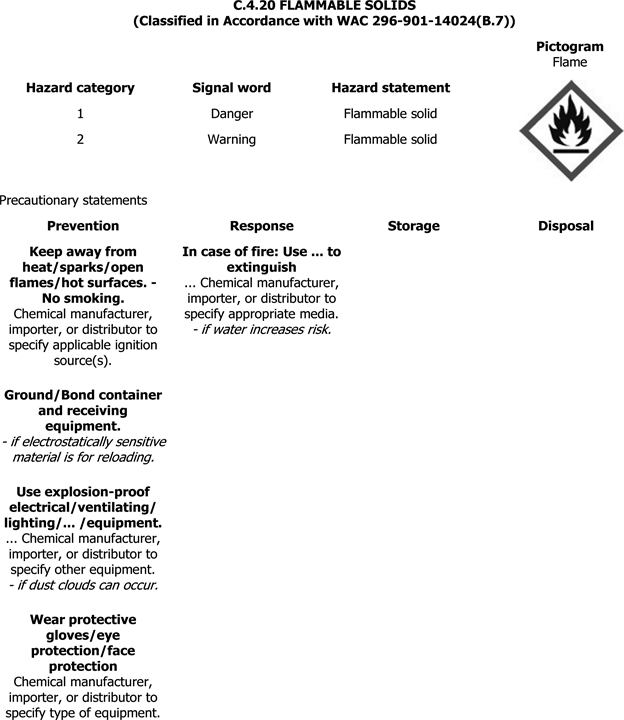 |
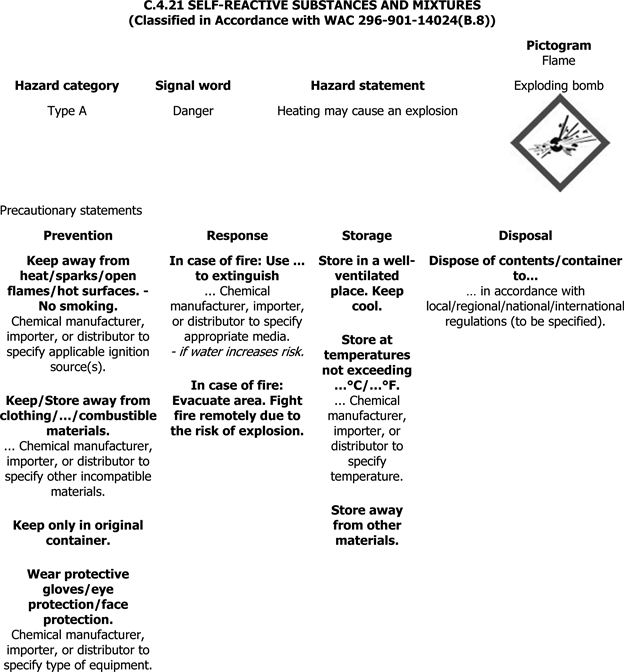 |
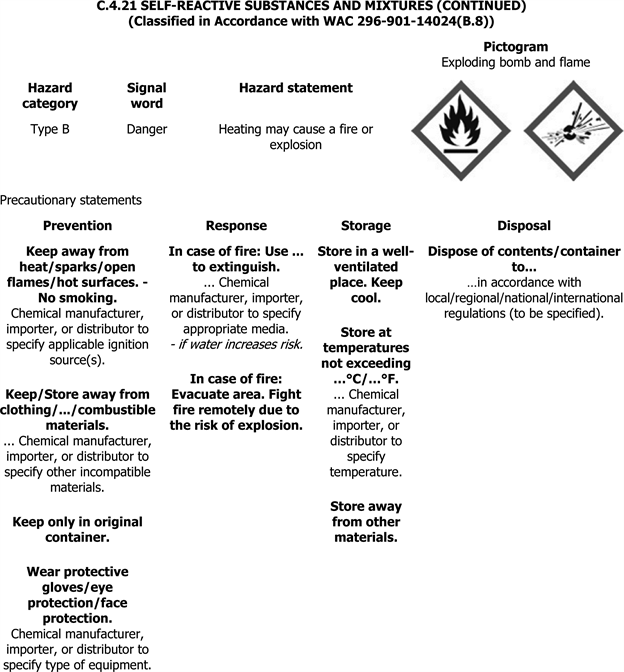 |
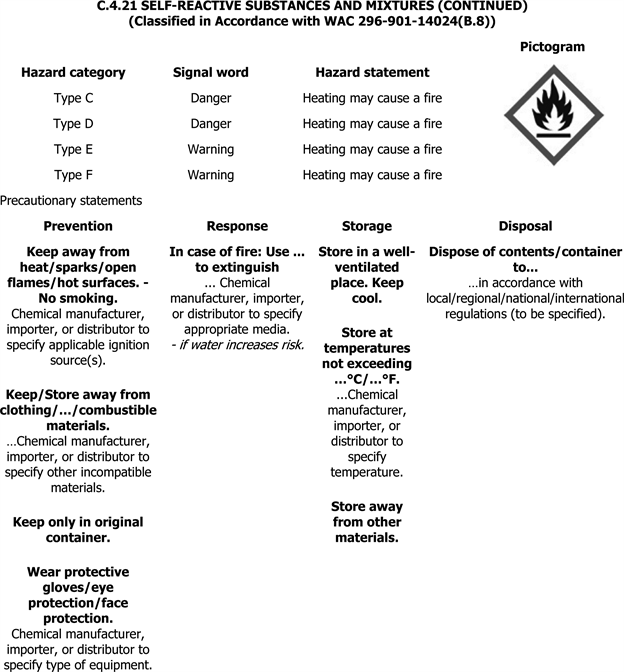 |
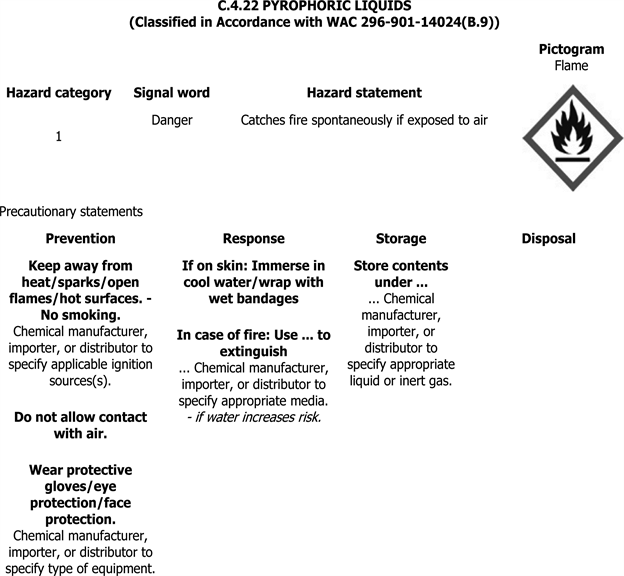 |
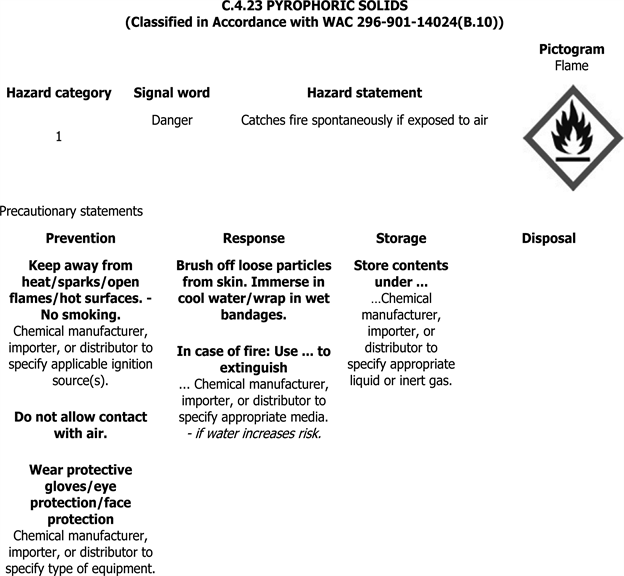 |
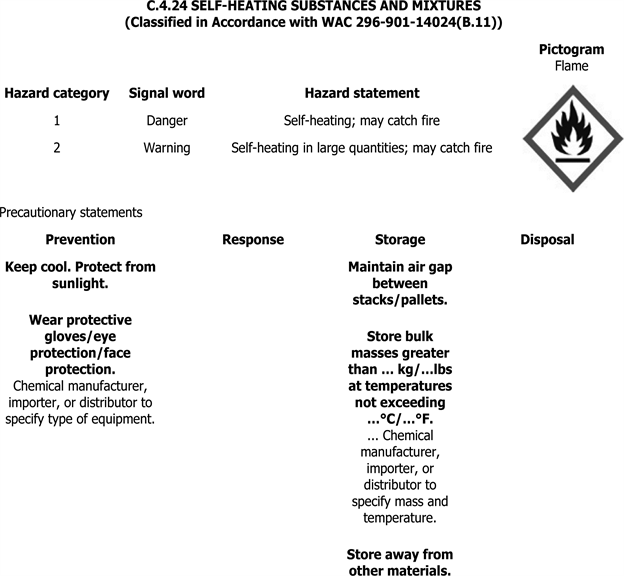 |
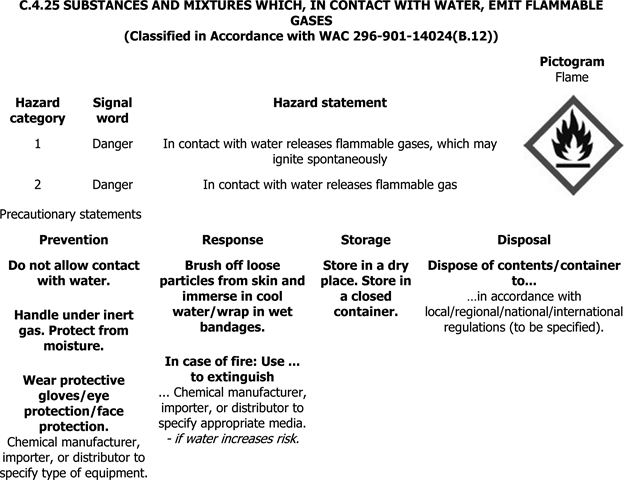 |
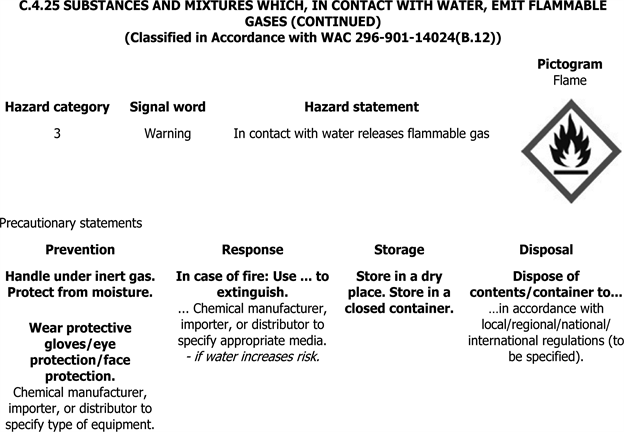 |
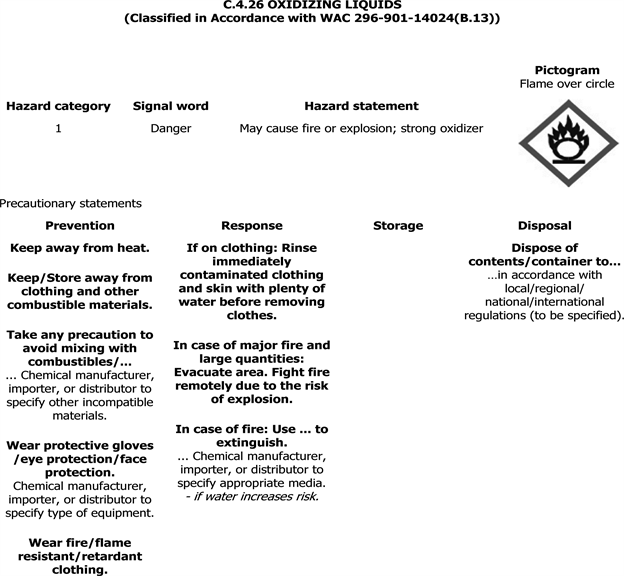 |
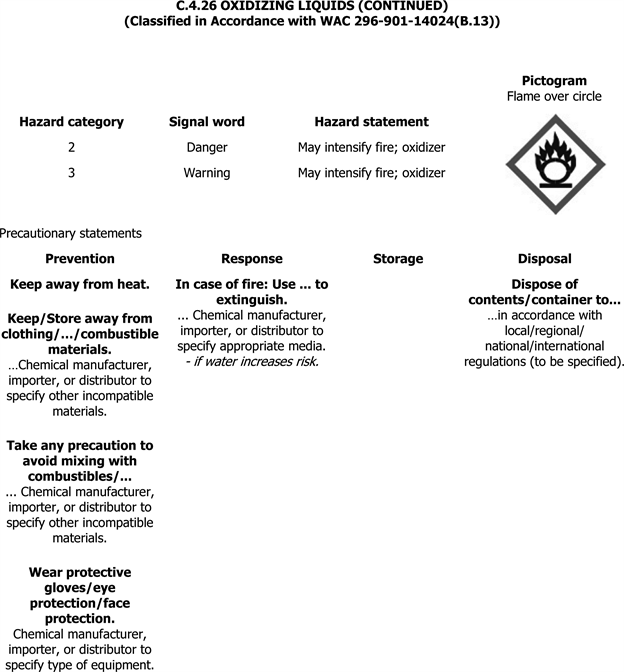 |
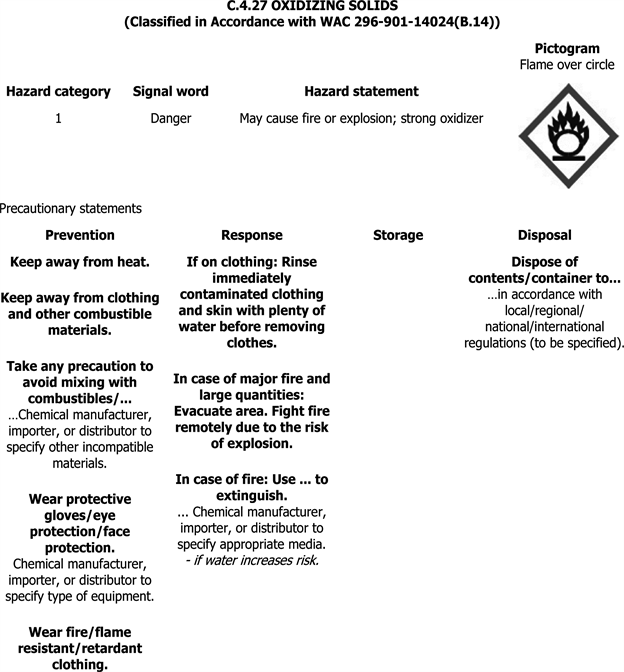 |
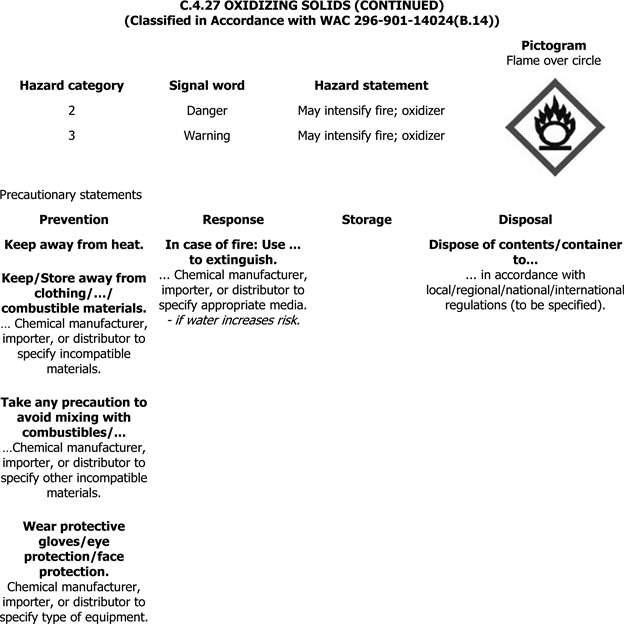 |
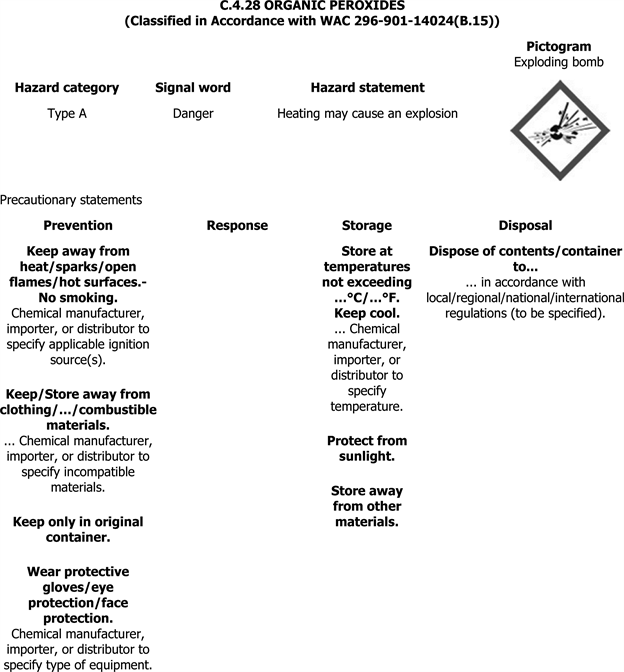 |
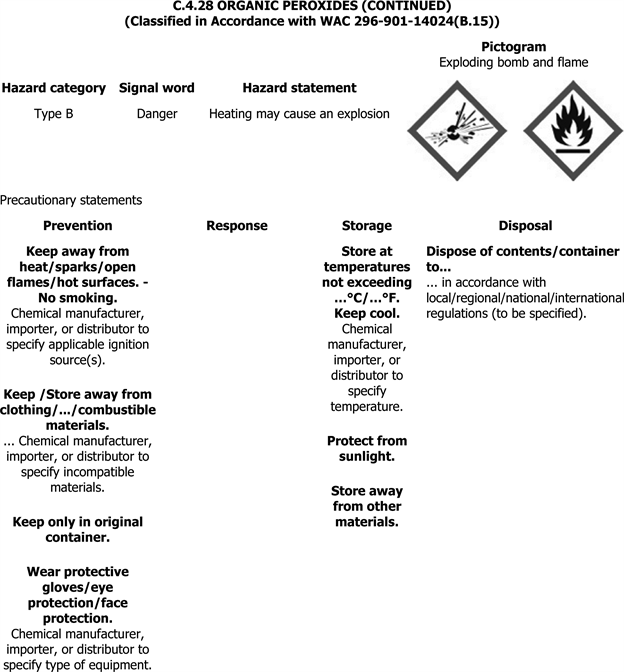 |
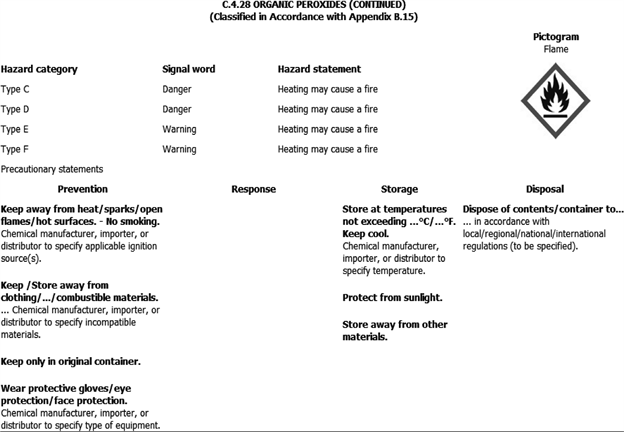 |
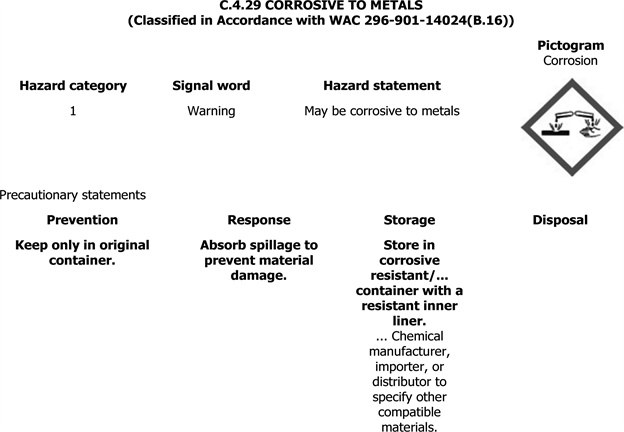 |
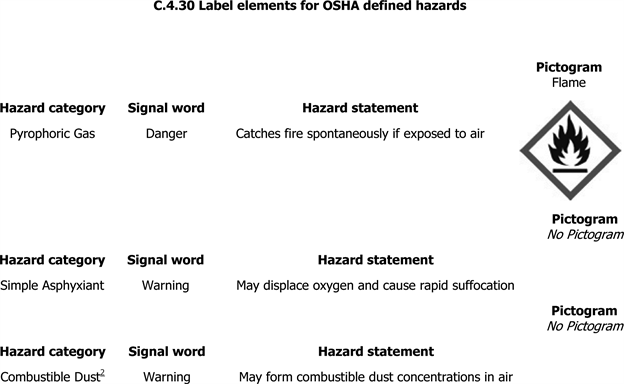 |
1 | Except no pictogram is required for explosives that are 1.4S small arms ammunition and components thereof. Labels for 1.4S small arms ammunition and components shall include appropriate precautionary statements. |
2 | The chemical manufacturer or importer shall label chemicals that are shipped in dust form, and present a combustible dust hazard in that form when used downstream, under WAC 296-901-14012(1); 2) the chemical manufacturer or importer shipping chemicals that are in a form that is not yet a dust must provide a label to customers under WAC 296-901-14012(4) if, under normal conditions of use, the chemicals are processed in a downstream workplace in such a way that they present a combustible dust hazard; and 3) the employer shall follow the workplace labeling requirements under WAC 296-901-14012(6) where combustible dust hazards are present. |
[Statutory Authority: RCW 49.17.010, 49.17.040, 49.17.050, 49.17.060 and 29 C.F.R. 1910 Subpart Z. WSR 14-07-086, § 296-901-14026, filed 3/18/14, effective 5/1/14; WSR 13-06-050, § 296-901-14026, filed 3/5/13, effective 4/15/13.]
Reviser's note: The brackets and enclosed material in the text of the above section occurred in the copy filed by the agency.
PDF296-901-14028
Appendix D—Safety data sheets.
A safety data sheet (SDS) must include the information specified in Table D.1 under the section number and heading indicated for sections 1-11 and 16. If no relevant information is found for any given subheading within a section, the SDS must clearly indicate that no applicable information is available. Sections 12-15 may be included in the SDS, but are not mandatory.
Table D.1. Minimum Information for an SDS
Heading | Subheading | |
1. | Identification | (a) Product identifier used on the label; (b) Other means of identification; (c) Recommended use of the chemical and restrictions on use; (d) Name, address, and telephone number of the chemical manufacturer, importer, or other responsible party; (e) Emergency phone number. |
2. | Hazard(s) identification | (a) Classification of the chemical in accordance with WAC 296-901-14008; (b) Signal word, hazard statement(s), symbol(s) and precautionary statement(s) in accordance with WAC 296-901-14012. (Hazard symbols may be provided as graphical reproductions in black and white or the name of the symbol, e.g., flame, skull and crossbones); (c) Describe any hazards not otherwise classified that have been identified during the classification process; (d) Where an ingredient with unknown acute toxicity is used in a mixture at a concentration ≥ 1% and the mixture is not classified based on testing of the mixture as a whole, a statement that X% of the mixture consists of ingredient(s) of unknown acute toxicity is required. |
3. | Composition/information on ingredients | Except as provided for in WAC 296-901-14018 on trade secrets: For Substances (a) Chemical name; (b) Common name and synonyms; (c) CAS number and other unique identifiers; (d) Impurities and stabilizing additives which are themselves classified and which contribute to the classification of the substance. For Mixtures In addition to the information required for substances: (a) The chemical name and concentration (exact percentage) or concentration ranges of all ingredients which are classified as health hazards in accordance with WAC 296-901-14008 and (1) are present above their cut-off/concentration limits; or (2) present a health risk below the cut-off/concentration limits. (b) The concentration (exact percentage) must be specified unless a trade secret claim is made in accordance with WAC 296-901-14018, when there is batch-to-batch variability in the production of a mixture, or for a group of substantially similar mixtures (See WAC 296-901-14022 (A.0.5.1.2)) with similar chemical composition. In these cases, concentration ranges may be used. For All Chemicals Where a Trade Secret is Claimed Where a trade secret is claimed in accordance with WAC 296-901-14018, a statement that the specific chemical identity and/or exact percentage (concentration) of composition has been withheld as a trade secret is required. |
4. | First-aid measures | (a) Description of necessary measures, subdivided according to the different routes of exposure, i.e., inhalation, skin and eye contact, and ingestion; (b) Most important symptoms/effects, acute and delayed. (c) Indication of immediate medical attention and special treatment needed, if necessary. |
5. | Fire-fighting measures | (a) Suitable (and unsuitable) extinguishing media. (b) Specific hazards arising from the chemical (e.g., nature of any hazardous combustion products). (c) Special protective equipment and precautions for fire-fighters. |
6. | Accidental release measures | (a) Personal precautions, protective equipment, and emergency procedures. (b) Methods and materials for containment and cleaning up. |
7. | Handling and storage | (a) Precautions for safe handling. (b) Conditions for safe storage, including any incompatibilities. |
8. | Exposure controls/personal protection | (a) DOSH permissible exposure limit (PEL), American Conference of Governmental Industrial Hygienists (ACGIH) Threshold Limit Value (TLV), and any other exposure limit used or recommended by the chemical manufacturer, importer, or employer preparing the safety data sheet, where available. (b) Appropriate engineering controls. (c) Individual protection measures, such as personal protective equipment. |
9. | Physical and chemical properties | (a) Appearance (physical state, color, etc.); (b) Odor; (c) Odor threshold; (d) pH; (e) Melting point/freezing point; (f) Initial boiling point and boiling range; (g) Flash point; (h) Evaporation rate; (i) Flammability (solid, gas); (j) Upper/lower flammability or explosive limits; (k) Vapor pressure; (l) Vapor density; (m) Relative density; (n) Solubility(ies); (o) Partition coefficient: n-octanol/water; (p) Auto-ignition temperature; (q) Decomposition temperature; (r) Viscosity. |
10. | Stability and reactivity | (a) Reactivity; (b) Chemical stability; (c) Possibility of hazardous reactions; (d) Conditions to avoid (e.g., static discharge, shock, or vibration); (e) Incompatible materials; (f) Hazardous decomposition products. |
11. | Toxicological information | Description of the various toxicological (health) effects and the available data used to identify those effects, including: (a) Information on the likely routes of exposure (inhalation, ingestion, skin and eye contact); (b) Symptoms related to the physical, chemical and toxicological characteristics; (c) Delayed and immediate effects and also chronic effects from short-and long-term exposure; (d) Numerical measures of toxicity (such as acute toxicity estimates). (e) Whether the hazardous chemical is listed in the National Toxicology Program (NTP) Report on Carcinogens (latest edition) or has been found to be a potential carcinogen in the International Agency for Research on Cancer (IARC) Monographs (latest edition), or by DOSH. |
12. | Ecological information (Non-mandatory) | (a) Ecotoxicity (aquatic and terrestrial, where available); (b) Persistence and degradability; (c) Bioaccumulative potential; (d) Mobility in soil; (e) Other adverse effects (such as hazardous to the ozone layer). |
13. | Disposal considerations (Non-mandatory) | Description of waste residues and information on their safe handling and methods of disposal, including the disposal of any contaminated packaging. |
14. | Transport information (Non-mandatory) | (a) UN number; (b) UN proper shipping name; (c) Transport hazard class(es); (d) Packing group, if applicable; (e) Environmental hazards (e.g., Marine pollutant (Yes/No)); (f) Transport in bulk (according to Annex II of MARPOL 73/78 and the IBC Code); (g) Special precautions which a user needs to be aware of, or needs to comply with, in connection with transport or conveyance either within or outside their premises. |
15. | Regulatory information (Non-mandatory) | Safety, health and environmental regulations specific for the product in question. |
16. | Other information, including date of preparation or last revision | The date of preparation of the SDS or the last change to it. |
PDF296-901-14030
Appendix E—Definition of "trade secret."
The following is a reprint of the "Restatement of Torts" section 757, comment b (1939):
b. "Definition of trade secret." A trade secret may consist of any formula, pattern, device or compilation of information which is used in one's business, and which gives him an opportunity to obtain an advantage over competitors who do not know or use it. It may be a formula for a chemical compound, a process of manufacturing, treating or preserving materials, a pattern for a machine or other device, or a list of customers. It differs from other secret information in a business (see s759 of the Restatement of Torts which is not included in this Appendix) in that it is not simply information as to single or ephemeral events in the conduct of the business, as, for example, the amount or other terms of a secret bid for a contract or the salary of certain employees, or the security investments made or contemplated, or the date fixed for the announcement of a new policy or for bringing out a new model or the like. A trade secret is a process or device for continuous use in the operations of the business. Generally it relates to the production of goods, as, for example, a machine or formula for the production of an article. It may, however, relate to the sale of goods or to other operations in the business, such as a code for determining discounts, rebates or other concessions in a price list or catalogue, or a list of specialized customers, or a method of bookkeeping or other office management.
"Secrecy." The subject matter of a trade secret must be secret. Matters of public knowledge or of general knowledge in an industry cannot be appropriated by one as his secret. Matters which are completely disclosed by the goods which one markets cannot be his secret. Substantially, a trade secret is known only in the particular business in which it is used. It is not requisite that only the proprietor of the business know it. He may, without losing his protection, communicate it to employees involved in its use. He may likewise communicate it to others pledged to secrecy. Others may also know of it independently, as, for example, when they have discovered the process or formula by independent invention and are keeping it secret. Nevertheless, a substantial element of secrecy must exist, so that, except by the use of improper means, there would be difficulty in acquiring the information. An exact definition of a trade secret is not possible. Some factors to be considered in determining whether given information is one's trade secret are: (1) The extent to which the information is known outside of his business; (2) the extent to which it is known by employees and others involved in his business; (3) the extent of measures taken by him to guard the secrecy of the information; (4) the value of the information to him and his competitors; (5) the amount of effort or money expended by him in developing the information; (6) the ease or difficulty with which the information could be properly acquired or duplicated by others.
"Novelty and prior art." A trade secret may be a device or process which is patentable; but it need not be that. It may be a device or process which is clearly anticipated in the prior art or one which is merely a mechanical improvement that a good mechanic can make. Novelty and invention are not requisite for a trade secret as they are for patentability. These requirements are essential to patentability because a patent protects against unlicensed use of the patented device or process even by one who discovers it properly through independent research. The patent monopoly is a reward to the inventor. But such is not the case with a trade secret. Its protection is not based on a policy of rewarding or otherwise encouraging the development of secret processes or devices. The protection is merely against breach of faith and reprehensible means of learning another's secret. For this limited protection it is not appropriate to require also the kind of novelty and invention which is a requisite of patentability. The nature of the secret is, however, an important factor in determining the kind of relief that is appropriate against one who is subject to liability under the rule stated in this Section. Thus, if the secret consists of a device or process which is a novel invention, one who acquires the secret wrongfully is ordinarily enjoined from further use of it and is required to account for the profits derived from his past use. If, on the other hand, the secret consists of mechanical improvements that a good mechanic can make without resort to the secret, the wrongdoer's liability may be limited to damages, and an injunction against future use of the improvements made with the aid of the secret may be inappropriate.
PDF296-901-14032
Appendix F—Guidance for hazard classifications regarding carcinogenicity.
The mandatory criteria for classification of a chemical for carcinogenicity under HCS are found in WAC 296-901-14022 (A.6). This non-mandatory Appendix provides additional guidance on hazard classification for carcinogenicity. Part A of Appendix F includes background guidance provided by GHS based on the Preamble of the International Agency for Research on Cancer (IARC) "Monographs on the Evaluation of Carcinogenic Risks to Humans" (2006). Part B provides IARC classification information. Part C provides background guidance from the National Toxicology Program (NTP) "Report on Carcinogens" (RoC), and Part D is a table that compares GHS carcinogen hazard categories to carcinogen classifications under IARC and NTP, allowing classifiers to be able to use information from IARC and NTP RoC carcinogen classifications to complete their classifications under the GHS, and thus the HCS.
Part A: Background Guidance1
As noted in Footnote 6 of WAC 296-901-14022 (A.6)., the GHS includes as guidance for classifiers information taken from the Preamble of the International Agency for Research on Cancer (IARC) "Monographs on the Evaluation of Carcinogenic Risks to Humans" (2006), providing guidance on the evaluation of the strength and evidence of carcinogenic risks to humans. This guidance also discusses some additional considerations in classification and an approach to analysis, rather than hard-and-fast rules. Part A is consistent with WAC 296-901-14022 (A.6), and must help in evaluating information to determine carcinogenicity.
Carcinogenicity in humans:
The evidence relevant to carcinogenicity from studies in humans is classified into one of the following categories:
(a) Sufficient evidence of carcinogenicity: A causal relationship has been established between exposure to the agent and human cancer. That is, a positive relationship has been observed between the exposure and cancer in studies in which chance, bias and confounding could be ruled out with reasonable confidence.
(b) Limited evidence of carcinogenicity: A positive association has been observed between exposure to the agent and cancer for which a causal interpretation is considered by the Working Group to be credible, but chance, bias or confounding could not be ruled out with reasonable confidence.
In some instances, the above categories may be used to classify the degree of evidence related to carcinogenicity in specific organs or tissues.
Carcinogenicity in experimental animals:
The evidence relevant to carcinogenicity in experimental animals is classified into one of the following categories:
(a) Sufficient evidence of carcinogenicity: A causal relationship has been established between the agent and an increased incidence of malignant neoplasms or of an appropriate combination of benign and malignant neoplasms in (i) two or more species of animals or (ii) two or more independent studies in one species carried out at different times or in different laboratories or under different protocols. An increased incidence of tumors in both sexes of a single species in a well-conducted study, ideally conducted under Good Laboratory Practices, can also provide sufficient evidence.
Exceptionally, a single study in one species and sex might be considered to provide sufficient evidence of carcinogenicity when malignant neoplasms occur to an unusual degree with regard to incidence, site, type of tumor or age at onset, or when there are strong findings of tumors at multiple sites.
(a) Limited evidence of carcinogenicity: The data suggest a carcinogenic effect but are limited for making a definitive evaluation because, e.g. (i) the evidence of carcinogenicity is restricted to a single experiment; (ii) there are unresolved questions regarding the adequacy of the design, conduct or interpretation of the studies; (iii) the agent increases the incidence only of benign neoplasms or lesions of uncertain neoplastic potential; or (iv) the evidence of carcinogenicity is restricted to studies that demonstrate only promoting activity in a narrow range of tissues or organs.
Guidance on how to consider important factors in classification of carcinogenicity (See Reference Section)
The weight of evidence analysis called for in GHS and the HCS is an integrative approach that considers important factors in determining carcinogenic potential along with the strength of evidence analysis. The IPCS "Conceptual Framework for Evaluating a Mode of Action for Chemical Carcinogenesis" (2001), International Life Sciences Institute (ILSI) "Framework for Human Relevance Analysis of Information on Carcinogenic Modes of Action" (Meek, et al., 2003; Cohen et al., 2003, 2004), and Preamble to the IARC Monographs (2006; Section B.6. (Scientific Review and Evaluation; Evaluation and Rationale)) provide a basis for systematic assessments that may be performed in a consistent fashion. The IPCS also convened a panel in 2004 to further develop and clarify the human relevance framework. However, the above documents are not intended to dictate answers, nor provide lists of criteria to be checked off.
Mode of action
Various documents on carcinogen assessment all note that mode of action in and of itself, or consideration of comparative metabolism, must be evaluated on a case-by-case basis and are part of an analytic evaluative approach. One must look closely at any mode of action in animal experiments, taking into consideration comparative toxicokinetics/toxicodynamics between the animal test species and humans to determine the relevance of the results to humans. This may lead to the possibility of discounting very specific effects of certain types of substances. Life stage-dependent effects on cellular differentiation may also lead to qualitative differences between animals and humans. Only if a mode of action of tumor development is conclusively determined not to be operative in humans may the carcinogenic evidence for that tumor be discounted. However, a weight of evidence evaluation for a substance calls for any other tumorigenic activity to be evaluated, as well.
Responses in multiple animal experiments
Positive responses in several species add to the weight of evidence that a substance is a carcinogen. Taking into account all of the factors listed in WAC 296-901-14022 (A.6.2.5.2) and more, such chemicals with positive outcomes in two or more species would be provisionally considered to be classified in GHS Category 1B until human relevance of animal results are assessed in their entirety. It must be noted, however, that positive results for one species in at least two independent studies, or a single positive study showing unusually strong evidence of malignancy may also lead to Category 1B.
Responses are in one sex or both sexes
Any case of gender-specific tumors must be evaluated in light of the total tumorigenic response to the substance observed at other sites (multi-site responses or incidence above background) in determining the carcinogenic potential of the substance.
If tumors are seen only in one sex of an animal species, the mode of action must be carefully evaluated to see if the response is consistent with the postulated mode of action. Effects seen only in one sex in a test species may be less convincing than effects seen in both sexes, unless there is a clear patho-physiological difference consistent with the mode of action to explain the single sex response.
Confounding effects of excessive toxicity or localized effects
Tumors occurring only at excessive doses associated with severe toxicity generally have doubtful potential for carcinogenicity in humans. In addition, tumors occurring only at sites of contact and/or only at excessive doses need to be carefully evaluated for human relevance for carcinogenic hazard. For example, forestomach tumors, following administration by gavage of an irritating or corrosive, non-mutagenic chemical, may be of questionable relevance. However, such determinations must be evaluated carefully in justifying the carcinogenic potential for humans; any occurrence of other tumors at distant sites must also be considered.
Tumor type, reduced tumor latency
Unusual tumor types or tumors occurring with reduced latency may add to the weight of evidence for the carcinogenic potential of a substance, even if the tumors are not statistically significant.
Toxicokinetic behavior is normally assumed to be similar in animals and humans, at least from a qualitative perspective. On the other hand, certain tumor types in animals may be associated with toxicokinetics or toxicodynamics that are unique to the animal species tested and may not be predictive of carcinogenicity in humans. Very few such examples have been agreed internationally. However, one example is the lack of human relevance of kidney tumors in male rats associated with compounds causing α2u-globulin nephropathy (IARC, Scientific Publication N° 1472). Even when a particular tumor type may be discounted, expert judgment must be used in assessing the total tumor profile in any animal experiment.
Part B: International Agency for Research on Cancer (IARC)3
IARC Carcinogen Classification Categories:
Group 1: The agent is carcinogenic to humans.
This category is used when there is sufficient evidence of carcinogenicity in humans. Exceptionally, an agent may be placed in this category when evidence of carcinogenicity in humans is less than sufficient but there is sufficient evidence of carcinogenicity in experimental animals and strong evidence in exposed humans that the agent acts through a relevant mechanism of carcinogenicity.
Group 2:
This category includes agents for which, at one extreme, the degree of evidence of carcinogenicity in humans is almost sufficient, as well as those for which, at the other extreme, there are no human data but for which there is evidence of carcinogenicity in experimental animals. Agents are assigned to either Group 2A (probably carcinogenic to humans) or Group 2B (possibly carcinogenic to humans) on the basis of epidemiological and experimental evidence of carcinogenicity and mechanistic and other relevant data. The terms probably carcinogenic and possibly carcinogenic have no quantitative significance and are used simply as descriptors of different levels of evidence of human carcinogenicity, with probably carcinogenic signifying a higher level of evidence than possibly carcinogenic.
Group 2A: The agent is probably carcinogenic to humans.
This category is used when there is limited evidence of carcinogenicity in humans and sufficient evidence of carcinogenicity in experimental animals. In some cases, an agent may be classified in this category when there is inadequate evidence of carcinogenicity in humans and sufficient evidence of carcinogenicity in experimental animals and strong evidence that the carcinogenesis is mediated by a mechanism that also operates in humans. Exceptionally, an agent may be classified in this category solely on the basis of limited evidence of carcinogenicity in humans. An agent may be assigned to this category if it clearly belongs, based on mechanistic considerations, to a class of agents for which one or more members have been classified in Group 1 or Group 2A.
Group 2B: The agent is possibly carcinogenic to humans.
This category is used for agents for which there is limited evidence of carcinogenicity in humans and less than sufficient evidence of carcinogenicity in experimental animals. It may also be used when there is inadequate evidence of carcinogenicity in humans but there is sufficient evidence of carcinogenicity in experimental animals. In some instances, an agent for which there is inadequate evidence of carcinogenicity in humans and less than sufficient evidence of carcinogenicity in experimental animals together with supporting evidence from mechanistic and other relevant data may be placed in this group. An agent may be classified in this category solely on the basis of strong evidence from mechanistic and other relevant data.
Part C: National Toxicology Program (NTP), "Report on Carcinogens", Background Guidance
NTP Listing Criteria4:
The criteria for listing an agent, substance, mixture, or exposure circumstance in the Report on Carcinogens (RoC) are as follows:
Known To Be A Human Carcinogen: There is sufficient evidence of carcinogenicity from studies in humans that indicates a causal relationship between exposure to the agent, substance, or mixture, and human cancer.
Reasonably Anticipated To Be A Human Carcinogen: There is limited evidence of carcinogenicity from studies in humans that indicates that a causal interpretation is credible, but that alternative explanations, such as chance, bias, or confounding factors, could not adequately be excluded,
or
there is sufficient evidence of carcinogenicity from studies in experimental animals that indicates there is an increased incidence of malignant and/or a combination of malignant and benign tumors (1) in multiple species or at multiple tissue sites, or (2) by multiple routes of exposure, or (3) to an unusual degree with regard to incidence, site, or type of tumor, or age at onset,
or
there is less than sufficient evidence of carcinogenicity in humans or laboratory animals; however, the agent, substance, or mixture belongs to a well-defined, structurally-related class of substances whose members are listed in a previous Report on Carcinogens as either known to be a human carcinogen or reasonably anticipated to be a human carcinogen, or there is convincing relevant information that the agent acts through mechanisms indicating it would likely cause cancer in humans.
Conclusions regarding carcinogenicity in humans or experimental animals are based on scientific judgment, with consideration given to all relevant information. Relevant information includes, but is not limited to, dose response, route of exposure, chemical structure, metabolism, pharmacokinetics, sensitive sub-populations, genetic effects, or other data relating to mechanism of action or factors that may be unique to a given substance. For example, there may be substances for which there is evidence of carcinogenicity in laboratory animals, but there are compelling data indicating that the agent acts through mechanisms that do not operate in humans and would therefore not reasonably be anticipated to cause cancer in humans.
Part D. Table Relating Approximate Equivalences among IARC, NTP RoC, and GHS Carcinogenicity Classifications
The following table may be used to perform hazard classifications for carcinogenicity under the HCS. It relates the approximated GHS hazard categories for carcinogenicity to the classifications provided by IARC and NTP, as described in Parts B and C of this Appendix.
Approximate Equivalences Among Carcinogen Classification Schemes
IARC | GHS | NTP RoC |
Group 1 | Category 1A | Known. |
Group 2A | Category 1B | Reasonably anticipated. |
Group 2B | Category 2 | (See Note 1). |
Note 1: | |
1. Limited evidence of carcinogenicity from studies in humans (corresponding to IARC 2A/GHS 1B); | |
2. Sufficient evidence of carcinogenicity from studies in experimental animals (again, essentially corresponding to IARC 2A/GHS 1B); | |
3. Less than sufficient evidence of carcinogenicity in humans or laboratory animals; however: | |
a. The agent, substance, or mixture belongs to a well-defined, structurally-related class of substances whose members are listed in a previous RoC as either "Known" or "Reasonably Anticipated" to be a human carcinogen, or | |
b. There is convincing relevant information that the agent acts through mechanisms indicating it would likely cause cancer in humans. |
*References:
Cohen, S.M., J. Klaunig, M.E. Meek, R.N. Hill, T. Pastoor, L. Lehman-McKeeman, J. Bucher, D.G. Longfellow, J. Seed, V. Dellarco, P. Fenner-Crisp, and D. Patton. 2004. Evaluating the human relevance of chemically induced animal tumors. Toxicol. Sci. 78(2):181-186.
Cohen, S.M., M.E. Meek, J.E. Klaunig, D.E. Patton, P.A. Fenner-Crisp. 2003. The human relevance of information on carcinogenic modes of action: Overview. Crit. Rev. Toxicol. 33(6):581-9.
Meek, M.E., J.R. Bucher, S.M. Cohen, V. Dellarco, R.N. Hill, L. Lehman-McKeeman, D.G. Longfellow, T. Pastoor, J. Seed, D.E. Patton. 2003. A framework for human relevance analysis of information on carcinogenic modes of action. Crit. Rev. Toxicol. 33(6):591-653.
Sonich-Mullin, C., R. Fielder, J. Wiltse, K. Baetcke, J. Dempsey, P. Fenner-Crisp, D. Grant, M. Hartley, A. Knapp, D. Kroese, I. Mangelsdorf, E. Meek, J.M. Rice, and M. Younes. 2001. The conceptual framework for evaluating a mode of action for chemical carcinogenesis. Reg. Toxicol. Pharm. 34:146-152.
International Programme on Chemical Safety Harmonization Group. 2004. Report of the First Meeting of the Cancer Working Group. World Health Organization. Report IPCS/HSC-CWG-1/04. Geneva.
International Agency for Research on Cancer. IARC Monographs on the Evaluation of Carcinogenic Risks to Human. Preambles to Volumes. World Health Organization. Lyon, France.
Cohen, S.M., P.A. Fenner-Crisp, and D.E. Patton. 2003. Special Issue: Cancer Modes of Action and Human Relevance. Critical Reviews in Toxicology, R.O. McClellan, ed., Volume 33/Issue 6. CRC Press.
Capen, C.C., E. Dybing, and J.D. Wilbourn. 1999. Species differences in thyroid, kidney and urinary bladder carcinogenesis. International Agency for Research on Cancer, Scientific Publication N˚ 147.
Doi, A.M., G. Hill, J. Seely, J.R. Hailey, G. Kissling, and J.R. Buchera. 2007. α2u-globulin nephropathy and renal tumors in National Toxicology Program studies. Toxicol. Pathol. 35:533-540
Footnote 1 The text of Appendix F, Part A, on the IARC Monographs, is paraphrased from the 2006 Preamble to the "Monographs on the Evaluation of Carcinogenic Risks to Humans" the Classifier is referred to the full IARC Preamble for the complete text. The text is not part of the agreed GHS text on the harmonized system developed by the OECD Task Force-HCL.
Footnote 2 While most international agencies do not consider kidney tumors coincident with α2u-globulin nephropathy to be a predictor of risk in humans, this view is not universally held. (See: Doi et al., 2007)
Footnote 3 Preamble of the International Agency for Research on Cancer (IARC) "Monographs on the Evaluation of Carcinogenic Risks to Humans" (2006)
Footnote 4 See: http://ntp.niehs.nih.gov/go/15209
Footnote 5 This evidence can include traditional cancer epidemiology studies, data from clinical studies, and/or data derived from the study of tissues or cells from humans exposed to the substance in question that can be useful for evaluating whether a relevant cancer mechanism is operating in people.